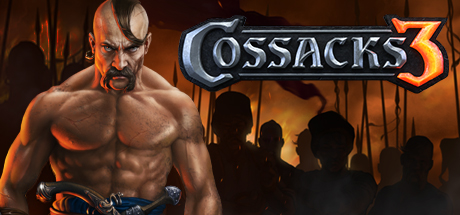Welcome to the Cossacks 3: Turkey Faction Guide! This guide will provide you with information about the nation of Turkey, including their bonuses, unique units, and overall playstyle. We will also touch upon some historical background for a better understanding of this faction. So, let’s dive in and learn all about the powerful nation of Turkey in Cossacks 3.
Introduction
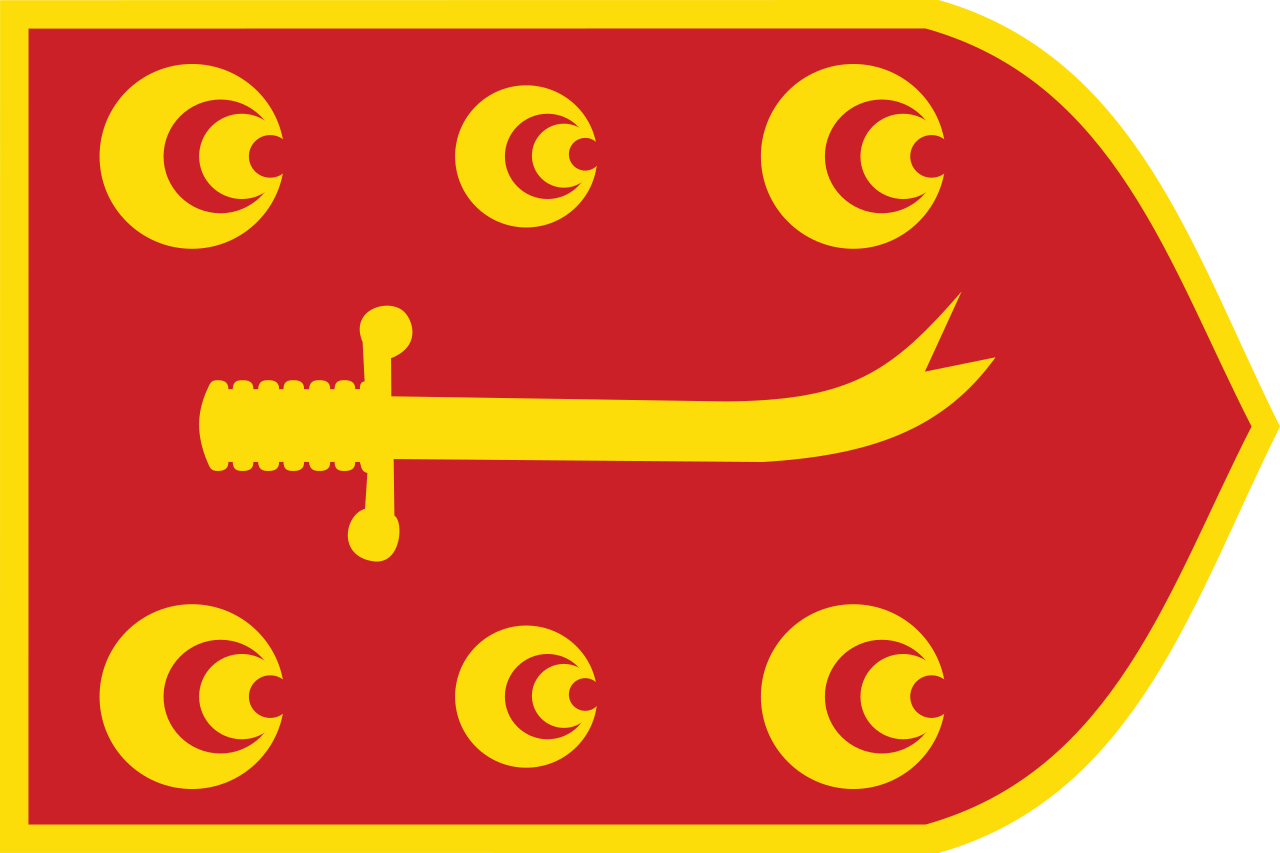
Example of a Zulfiqar battle flag typically used by Ottoman armies during the 16th and 17th centuries. “Zulfiqar” is the name given to the sword of Ali ibn Abi Talib, an Islamic hero from the faith’s early days, and it’s generally depicted as having a curved and split point. During the game’s timeframe, the empire didn’t have a set national flag apart from arguably the horsetail tug, so Ottoman forces employed a dizzying array of banners in battle.
Availability: Base game
Focus: Early, Rush, Spammer, Naval
Playstyle: Islamic
Turkey dominates the early game. With their combination of cheap production buildings, strong 17th century units, and numerous discounts to kickstart their economy and military, they outclass every other rushing nation except arguably Algeria, Poland, Scotland, or a Hetman-rushing Ukraine. Starting near a competent Turkish player in a low-peacetime game is one of the scariest things you can experience in Cossacks and has led to many a quick defeat. Turkey is also one of the top countries on water maps thanks to its numerous naval discounts and unique Islamic ships.
The downside is that Turkey’s land forces get progressively outclassed by other nations’ troops over time. They’re still competitive in the mid game but once the late 18th century rolls around they fall far behind the Europeans economically and militarily. This threat of inevitable obsolescence hangs over the entire faction like a giant sword of Damocles and forces Turkish players to be very aggressive: Sitting back and booming is not an option when your position gets worse with every passing minute.
If you like early aggression, enjoy unique rosters and mechanics, or just love the thrill of racing against the clock to wreak as much havoc as possible, Turkey is a great nation for you.

The so-called “Turks Standard” featured in Bowles’s Universal Display of the Naval Flags of all Nations (1783). It wasn’t until 1793 that a buyruldu (decree) went out that standardized the Ottoman naval ensign into a red flag with a white crescent and star.
Features
+ Town Centers, Shipyards, and Storehouses cost less
+ Cheap 17c. Barracks that don’t cost gold but only support 50 pop.
+ Fast-building Minarets replace Academies
+ Towers are cheaper and build faster
+ Ottoman Pikeman–good for early rushing but very poor later on
+ Light Infantryman–weak, spammable swordsman
+ Janissary–very strong but slow-training early Musketeer
+ Tatar–cavalry archer great for early raiding & destroying buildings
+ Light Sipahi–cheap swarm cavalry
+ Heavy Sipahi–armored heavy cavalry
+ Mullah–weaker, faster-training healer
+ Islamic Yacht–faster and stronger than normal Yachts at no extra cost
+ Xebec–stronger Frigate that’s cheaper to unlock and has no upkeep
+ Tech Discounts:
- 1st harvesting upgrade (Mill)
- 2nd & 3rd harvesting upgrades* (Academy)
- Cannon & Howitzer production speed (Artillery Depot)
- Artillery range upgrades (Academy)
- Improved unit armor (Blacksmith & Academy)
- Building durability (Academy)
- Ship construction & movement speed (Academy)
~ Early Stables are cheap and build faster but later ones are much more expensive
~ Diplomatic Center costs less wood but more stone
~ Turkish Archer–weak, spammable bowman
– Can’t advance to the 18th century
– Markets/Bazaars and Artillery Depots cost more
– Walls cost more and build slowly
– No 2nd harvesting upgrade (Mill)
– No balloon to reveal the map
– No native fast cavalry
– No Multi-barrelled Cannon
– No native armored infantry for tanking bullets
– Rising building costs & no 18c. Barracks leads to lower late-game population cap
– Can’t upgrade Ferries’ troop capacity
*Smaller discount than Algeria
The Islamic nations are geared toward the early game and Turkey is no exception. Their numerous discounts on farming upgrades and naval techs help them kickstart their economy quicker than other factions, as do their fast-building Minarets. Likewise, their combination of cheap military production buildings, discounted artillery techs, and units that are either very strong (Janissaries, Heavy Sipahis) or extremely spammable (Light Infantry, Ottoman Pikemen, Tatars, Light Sipahis) allow them to quickly and cheaply raise large, powerful armies in the 17th century.
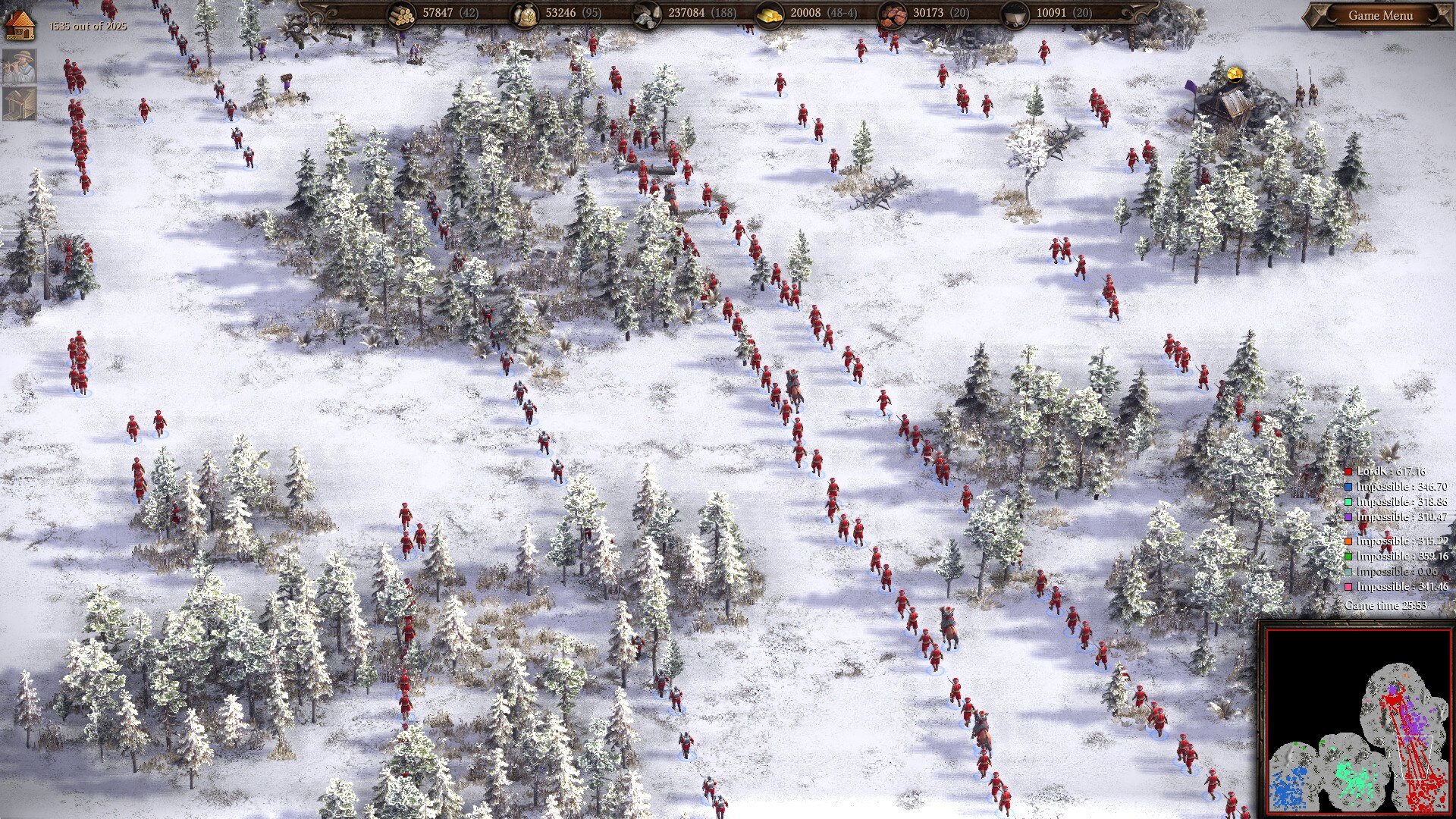
Spam on a whole other level: Light Infantry, Tatars, and mercenaries marching to the front. No country, not even Russia, can pump out bodies as quickly as Turkey (and Algeria).
The flip side is that Turkey is easily one of the weakest countries in the later stages of the game. Turkey can’t advance to the 18th century, meaning they’re stuck with early-game units. Likewise, their economy becomes worse than everyone else’s due to missing the last farming upgrade that kicks food production into high gear. Finally, the combination of rising building costs and the lack of 18c. Barracks hinders their late-game unit production and population cap compared to European factions. Eventually, Turkey will reach a point where they’re outmatched in both quality and quantity of units, all but guaranteeing defeat.
This is why you need to be aggressive when playing as Turkey. If you don’t kill or cripple your enemy in the early-to-mid game, you’re basically screwed unless you have strong allies to fall back on. This encourages you to get stuck into the action right away, which is why Turkey is so fun to play.
That’s just on land maps, though. On water maps, Turkey is powerful across the entire game. Between their cheaper Shipyards, huge discounts on ship movement and production speed techs, stronger Yachts, and mighty Xebecs, Turkey can build up a powerful navy faster than any non-Islamic nation except maybe Ukraine and unlike their armies, their navies never decrease in quality. The only things they struggle with are not getting the balloon tech, which can be easily solved by your allies*, and being poor at amphibious assaults due to their low-capacity Ferries.
*NOTE: The AI never researches the balloon tech. Ever.
Ottoman Pikeman (17th century)

Base stats:
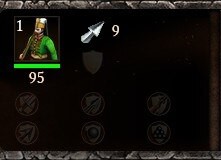
Full upgrades:
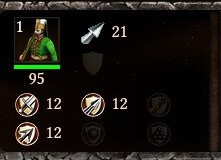
Cost: 55 food, 5 gold
Training time: 5.5 seconds
+ Great for rushing in the first 15 minutes
+ Low cost
+ Cheap upgrades
+ Gets bigger buffs from their Barracks upgrades than most other units
+ Doesn’t tax your early economy as much as Light Infantry do
~ Slow training time to balance out cheap Islamic Barracks
– No bullet armor
– Relative effectiveness declines sharply after the first 15-20 minutes
One of the most common openings for Islamic countries is to throw down a couple of Barracks and start making Ottoman Pikemen. While they don’t perform well in the mid-to-late game, their low cost and rapid stat gains allow you to field a very strong melee army in the first 15-20 minutes (remember that number) without overtaxing your developing economy.
Stat-wise, Ottoman Pikemen are basically unarmored, offense-oriented versions of 17c. Pikemen. Their max melee defenses are lower due to not wearing armor and their bullet protection is nonexistent, but they make up for it with +3 attack. Their 5.5-second training time is annoyingly slow but is mostly balanced out by Turkey’s cheaper Barracks. On the plus side, their slower production rate means they don’t require lots of extra housing like Light Infantry do, making them far less taxing on your weak early economy.
All that sounds cool, but it doesn’t explain why Ottoman Pikemen are so good early on. No, the real key to their prowess is in their Barracks upgrades, which buff their stats at a much faster rate than other Pikemen:
Upgrades comparison: Ottoman Pike vs. 17c. Pike
Total Attack change:
Level: 2 3 4 5 6 7
Otto. +2 +4 +6 +8 +10 +12
17c. +1 +3 +5 +6 +8 +11
Total Defense change:
Level: 2 3 4 5 6 7
Otto. +1 +3 +6 +7 +9 +11
17c. +1 +2 +4 +5 +6 +8
These faster stat gains have real consequences on the battlefield:
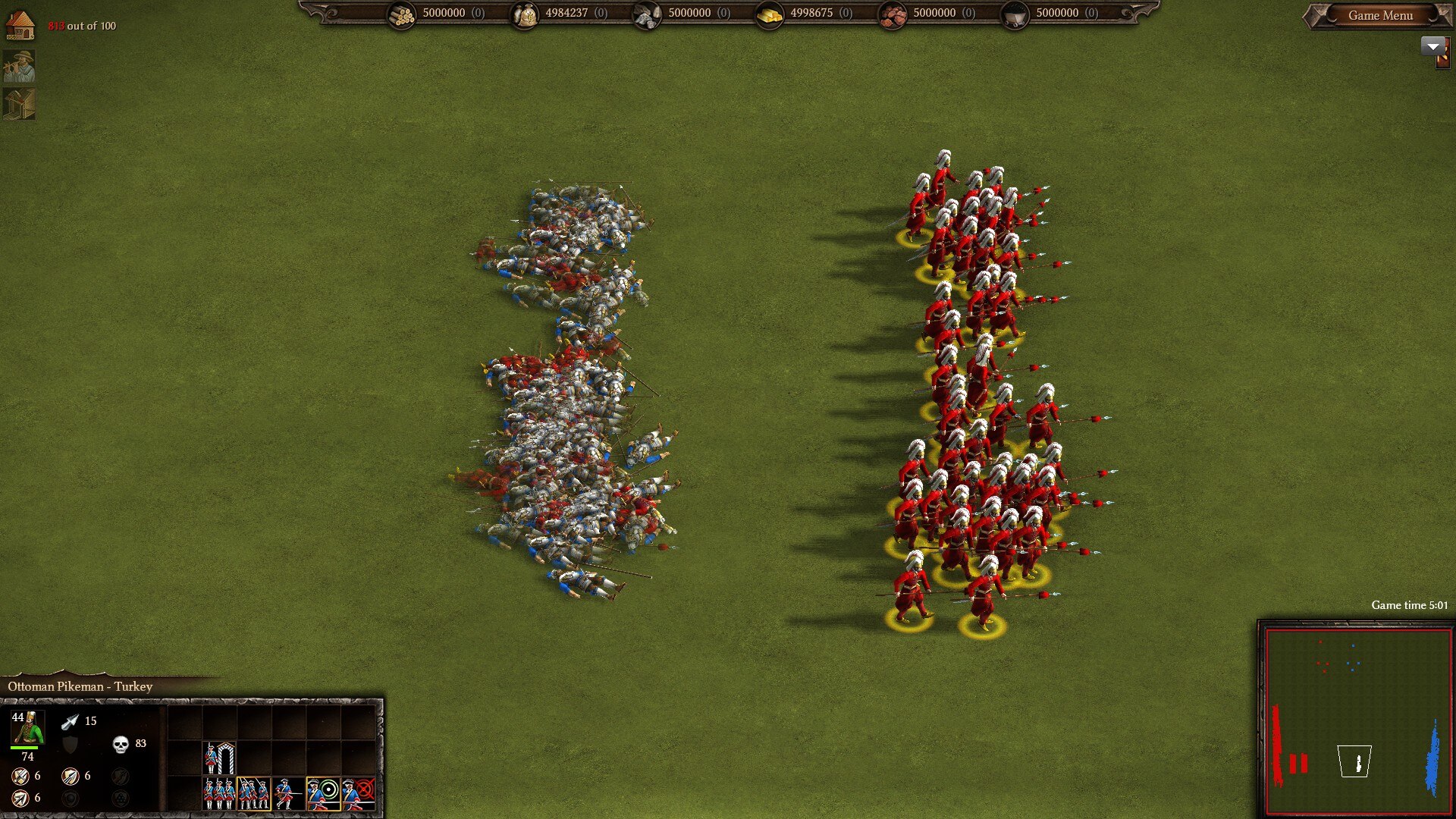
87 Ottoman Pikemen at upgrade tier IV vs. 108 17c. Pikemen. They do even better with full Barracks upgrades. (Note: This test assumed that the Turkish player only had two Barracks up; with three Barracks, the number of Ottoman Pikemen jumps to 131 and they dominate even harder.)
With equal upgrades and training time, Ottoman Pikemen dominate standard 17c. Pikemen, and it gets even better once Turkey has more Barracks than its Europeans foes (which doesn’t take long). After that, only Polish Pikemen, Russian Spearmen, and a Scottish Covenanter-Clansman combo can reliably beat Ottoman Pikemen in an early pike fight. This gives Turkish players a strong, low-cost force with which to blitz most other factions in the early game, making them lethally good in low-peacetime games.
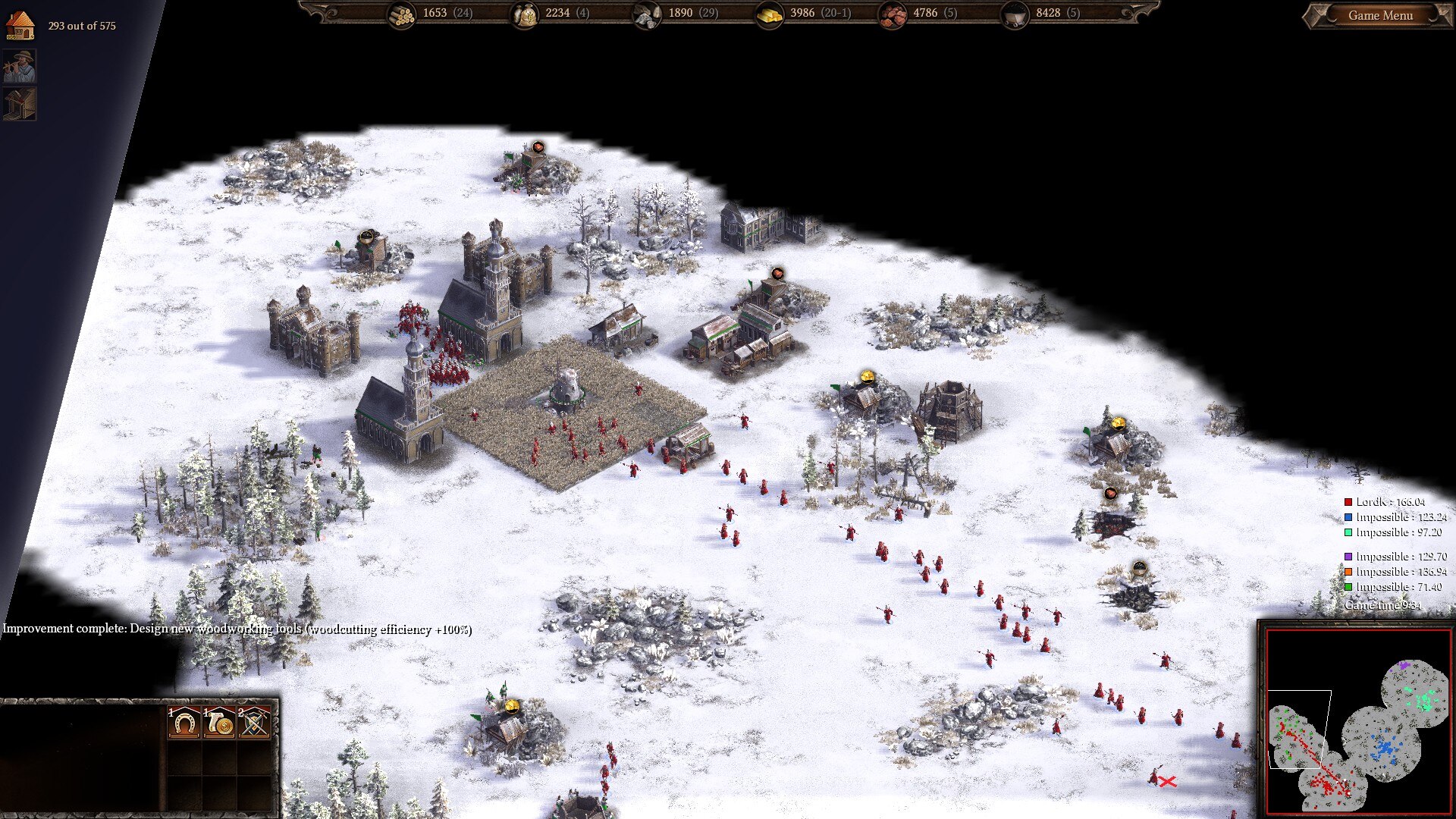
First Vienna, now Munich: Ottoman Pikemen and mercs overrun a Bavarian base before the 10-minute mark.
As time goes on, however, the Ottoman Pikeman’s effectiveness declines pretty sharply. There are two reasons for this: First, their relative melee strength drops as European nations snag their armor upgrades to fully buff their Pikemen.
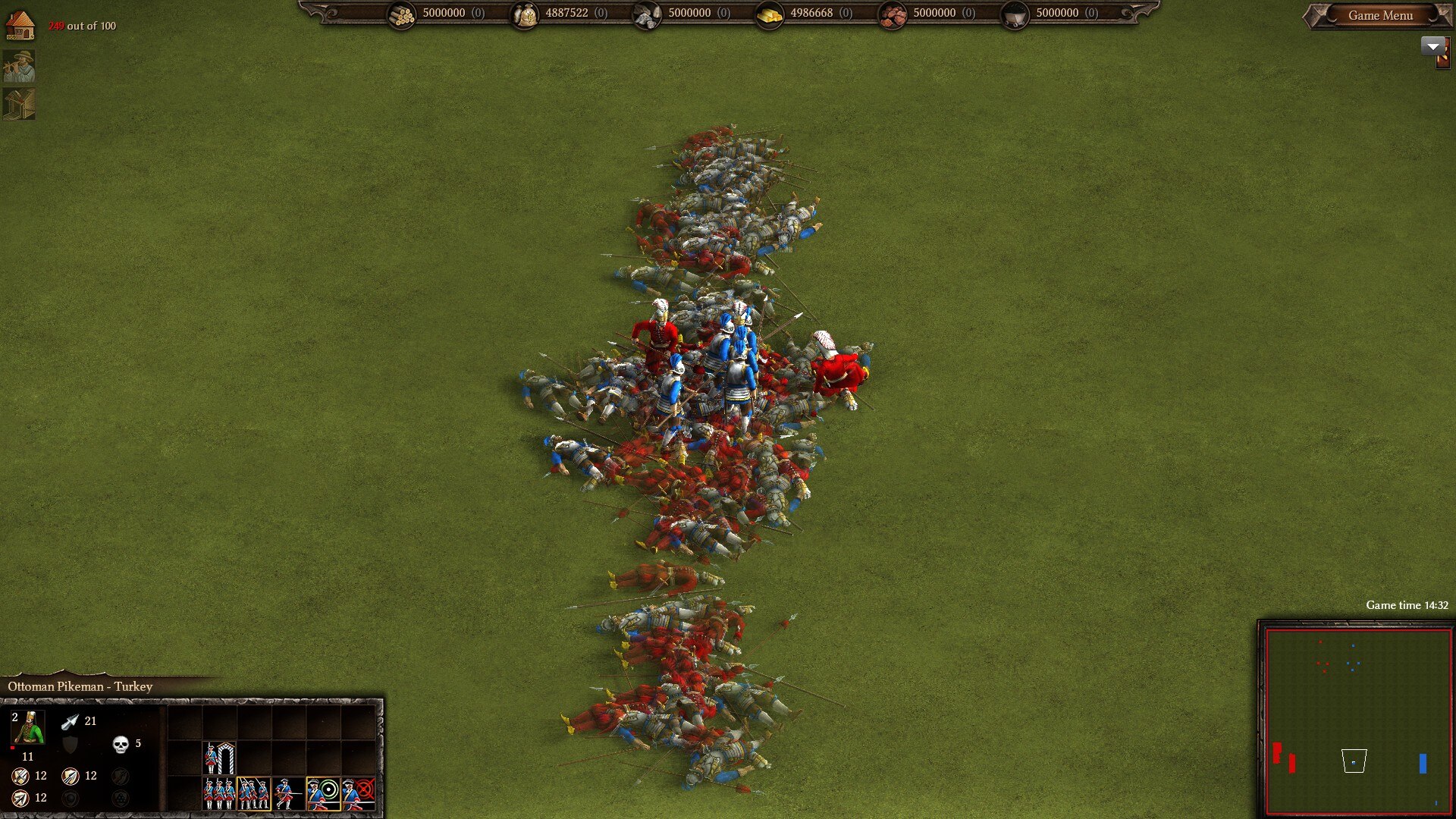
The same test as before (87 Ottomans vs 108 17c.) but with full upgrades, including the armor techs.
This isn’t the worst thing in the world, as you can still overwhelm most other pike units with superior numbers using your extra Barracks. Even so, your margin of superiority is less than what it was, leading to higher losses.
Second and much more importantly, Ottoman Pikemen are horrible at withstanding gunfire due to their total lack of bullet armor:
Shots to kill (full upgrades)
Against normal Musketeers dealing 25 damage per shot, Ottoman Pikemen die in only 4 hits compared to a 17c. Pikeman’s 6, which is really bad. Combine that with their less-than-stellar production speed, and you can see why Ottoman Pikemen are horribly suited for combat in the mid-to-late game when shooting rules the battlefield.
This is why you want to switch off Ottoman Pikemen after the first 15-20 minutes; wait much longer, and you have a good chance of being destroyed by any halfway competent musket army. Most likely you’ll want to swap to Light Infantry to keep up with higher late-game losses. Speaking of which…
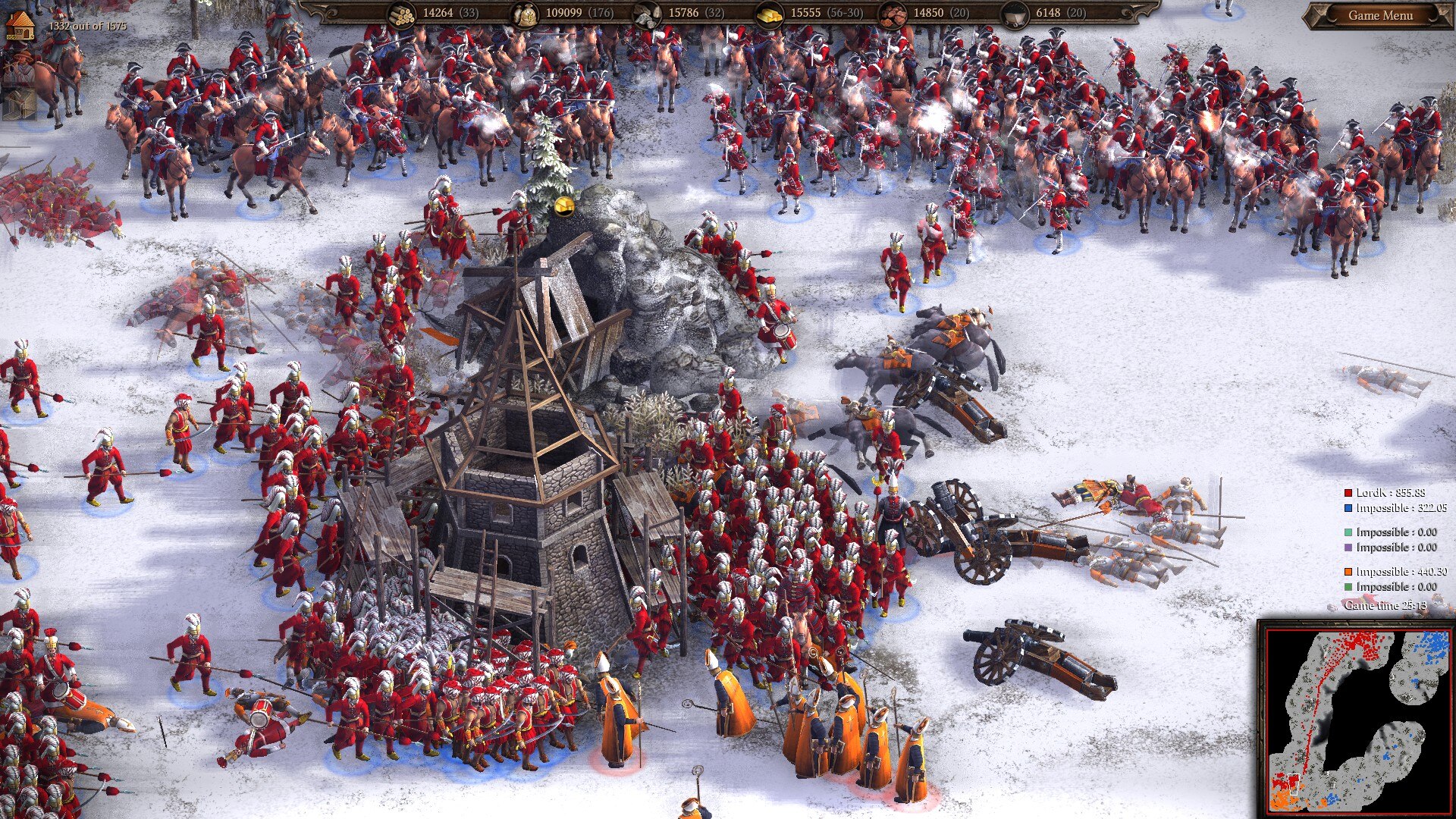
Culling clergymen: Ottoman Pikemen and and mercenaries strike down some Priests while storming a French town.
Light Infantryman (17th century)
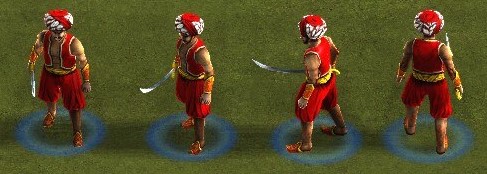
Base stats:
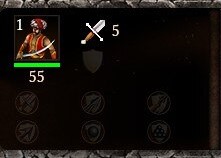
Full upgrades:
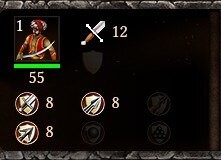
Cost: 25 food, 1 iron
Training time: 1 second
+ The most spammable unit in the game
+ Nonexistent cost
+ Cheap upgrades
+ Great at overwhelming enemies in the early-to-mid game
+ Can be decent blocking troops through sheer numbers
– Pathetic stats
– Near-useless on their own in the late game
– Extremely inefficient population-wise
– Requires lots of extra housing which slows down your early economy
– End up with 3 less attack than Algerian Light Infantry
Light Infantry are the undisputed kings of spam. No other unit in the game can match their crazy fast 1-second training time. This allows them to be fielded in overwhelming numbers, making them both deadly in the early-to-mid game and vital blocking troops/army padding in the later stages of the game.
The big selling point of Light infantry is their near-instant production speed. In the time it takes European players to make 108 17c. Pikemen, Islamic players can churn out 480 Light Infantry from the same number of Barracks. This is of course offset by their garbage stats; with 55 HP and 8 melee/arrow protection, Light Infantry die at the drop of a hat. Their offense isn’t much better, and they’ll often struggle more than 1 damage with once their foes are heavily upgraded.
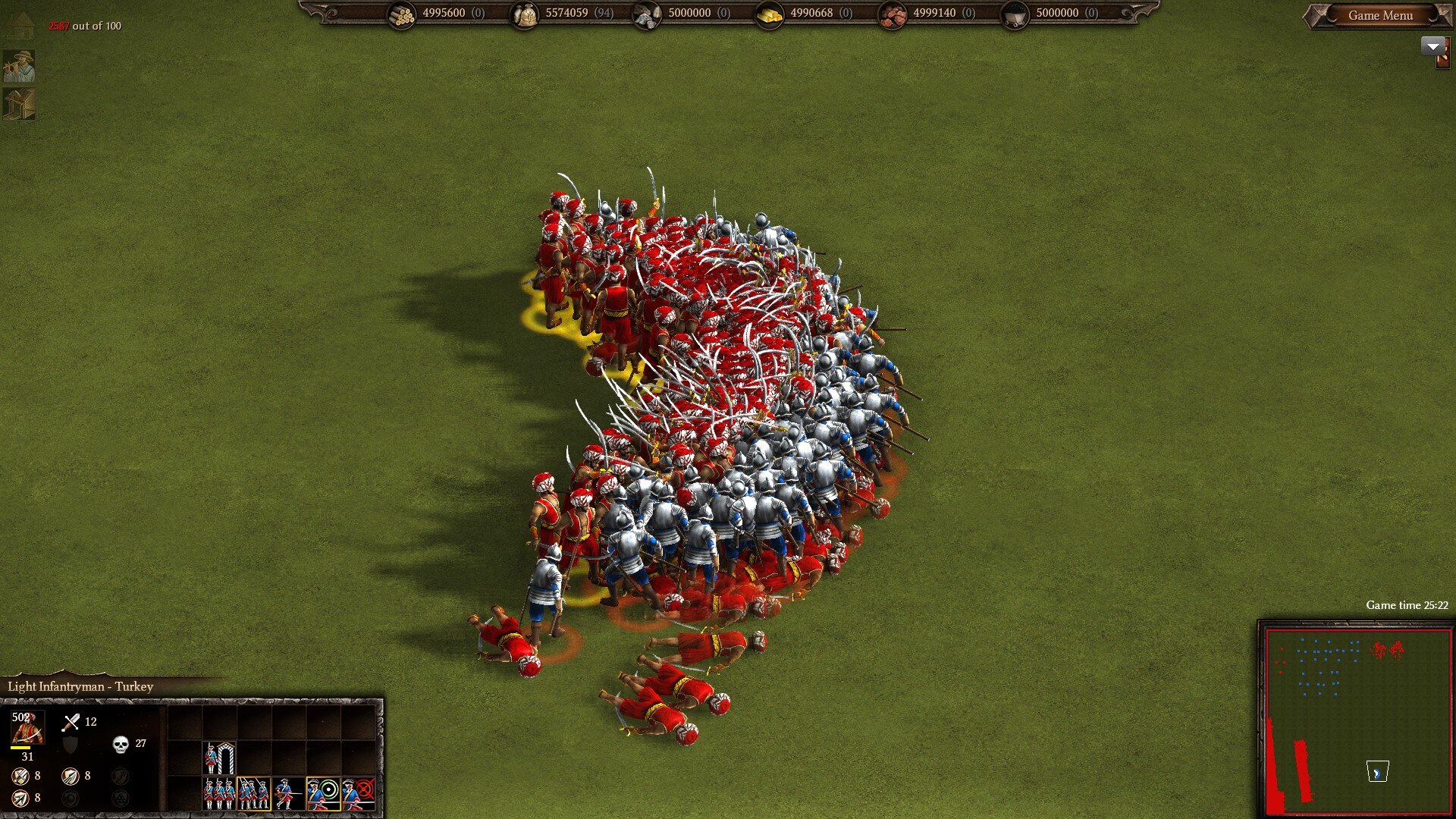
720 fully-upgraded Light Infantry vs 87 Spanish Coseletes. Look at those scimitars fly (and those bodies pile up)!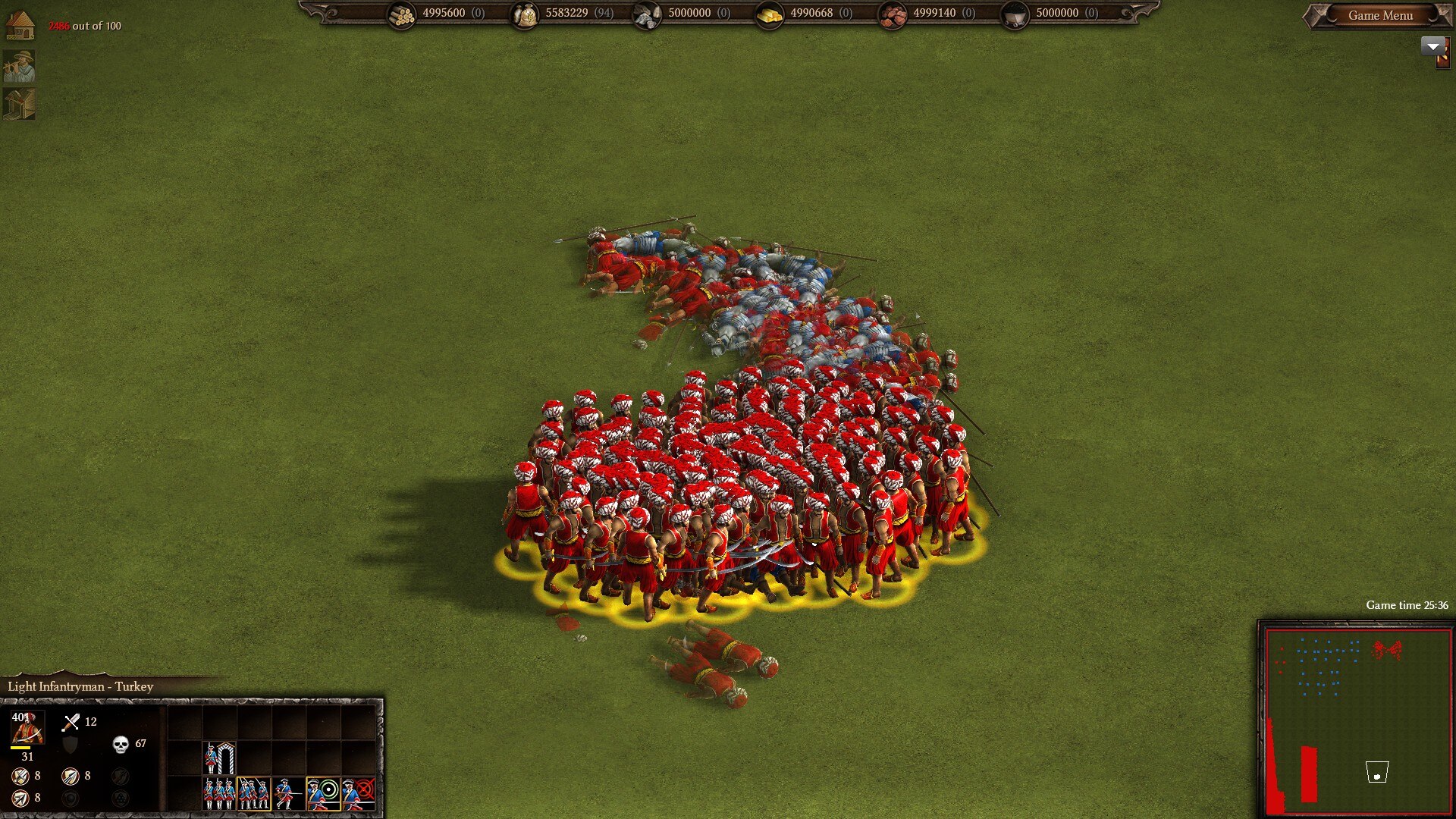
Aftermath of the above fight. Quantity trumped quality today.
That low attack really is their Achilles heel in melee combat. They do very well at low upgrade tiers, beating every other early melee infantry in a head-on fight, but once enemy defense catches up with their attack, Light Infantry’s performance drops sharply, losing to Polish, Portuguese, Ottoman, and even Scottish Pikemen plus Russian Spearmen, Sword Clansmen, and Algerian Light Infantry (whose +3 attack allows them to dominate their Turkish counterparts). Light Infantry are also near-worthless against massed heavy cavalry like Reiters, whose high HP and sword armor render them almost immune to the Light Infantry’s blades.
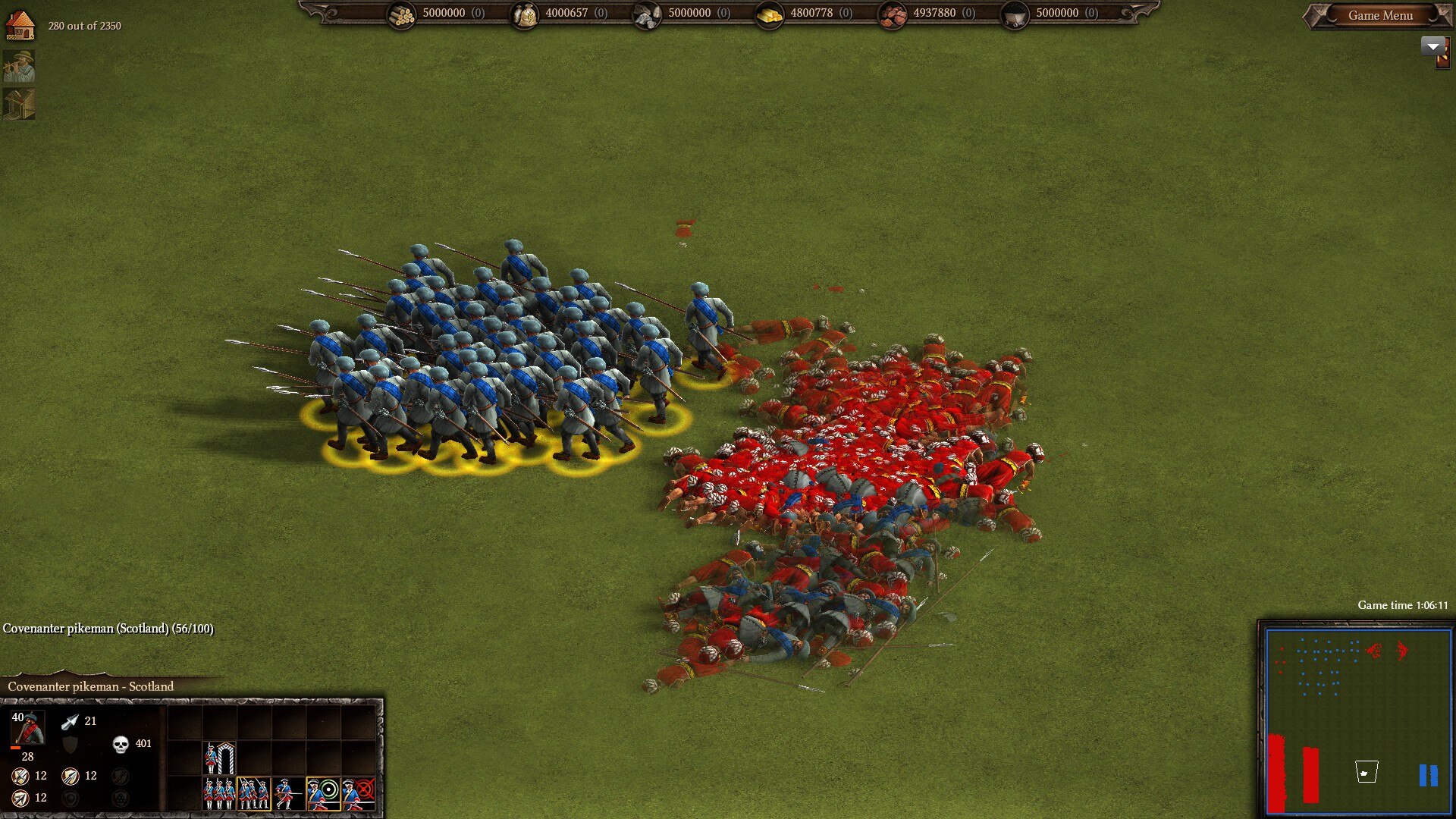
A very different outcome: 720 fully-upgraded Light Infantry vs 120 Scottish Covenanter Pikemen.
You might have noticed something about these tests, though: They all assume the Turkish player has unlimited population space to make however many Light Infantry they need. This is much harder to do in-game, where rising housing costs can make it hard to achieve the overwhelming numbers Light Infantry need to be effective. (This is also why a lot of players start with Ottoman Pikemen—they don’t strain your wood and stone income like Light Infantry do.)
Something else the tests didn’t account for was the presence of Officers and Drummers. Since your men’s stats are so weak, a +2 or 3 to attack and defense is very significant. Try to group your Light Infantry into formations whenever you can .
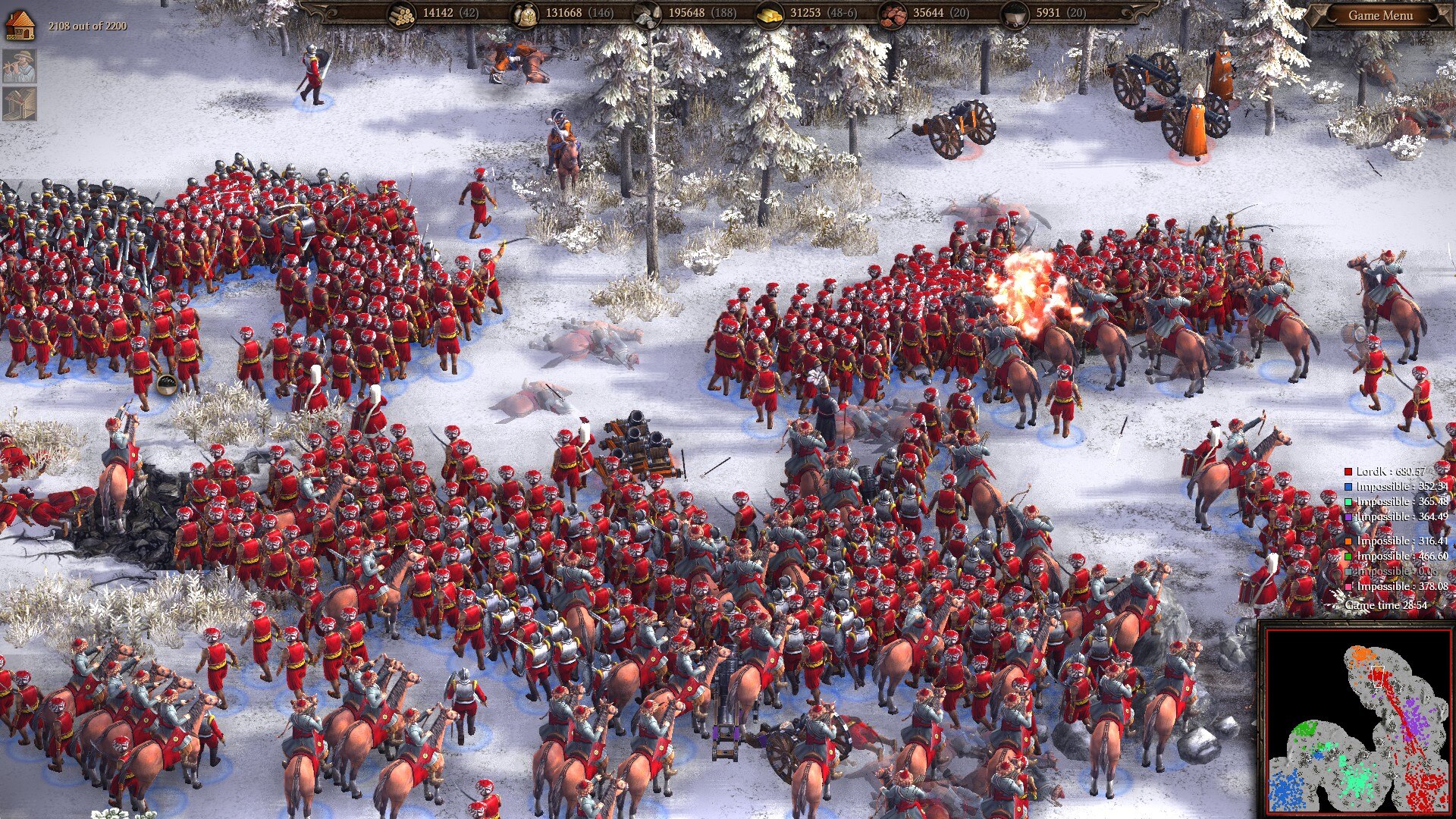
Another day along the Habsburg-Ottoman frontier: Light Infantry, Tatars, and mercs overwhelm an Austrian force.
In the early-to-mid game, Light Infantry can do very well, swarming over stronger enemies and drowning them in bodies. It’s not elegant, but it gets the job done. They also pair extremely well with Mercenary Dragoons and Grenadiers, who can gun down tough melee threats that the Light Infantry struggle with. They’re good for mid-length peacetime games and can even do very well in lower-peacetime games if you don’t want to bother with Ottoman Pikemen, though it’s trickier to pull off. (See the Algeria guide for a good example game showing how to pull off a Light Infantry rush.)
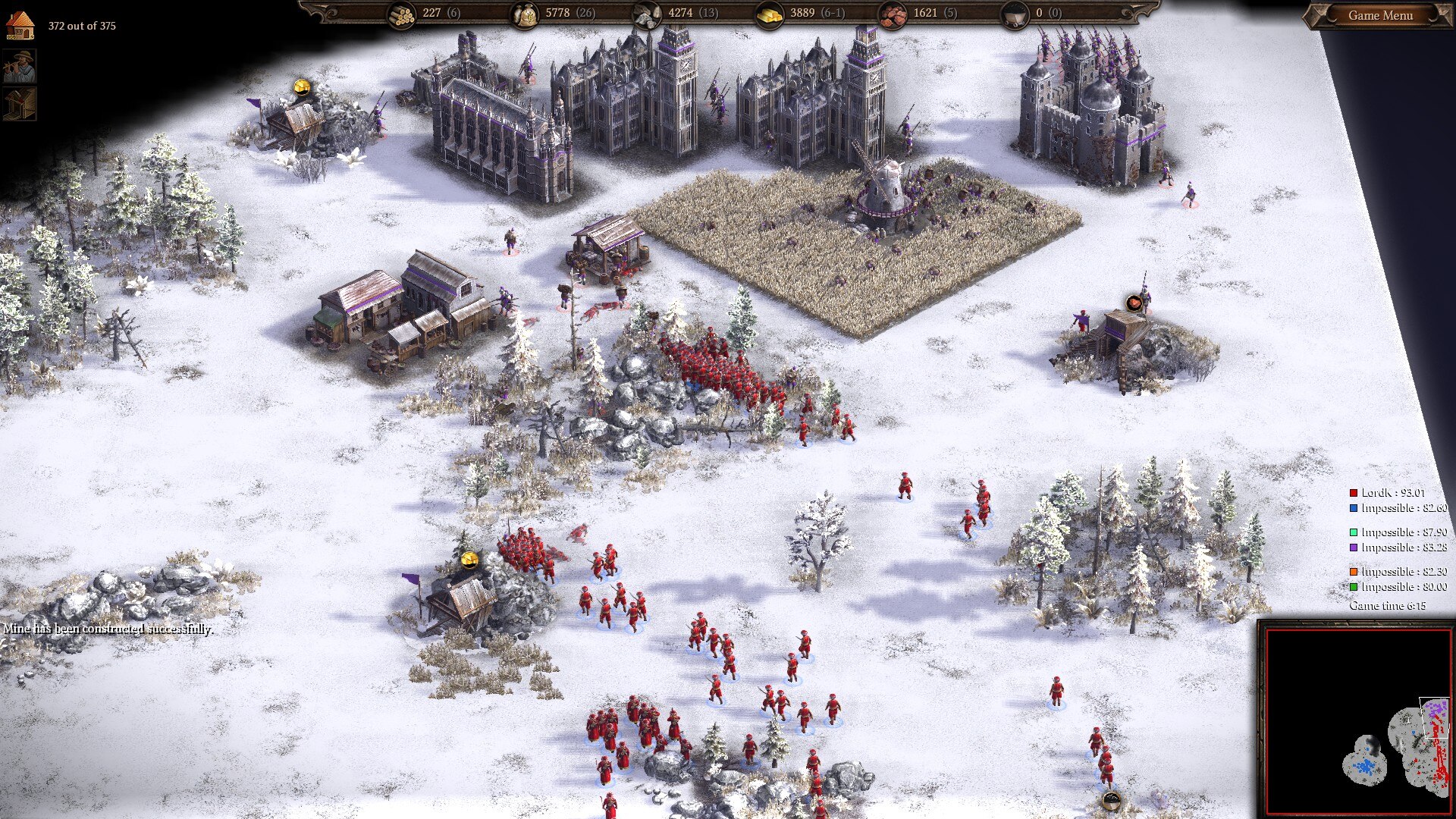
Enslaving Britannia: A Light Infantry rush hits an English base just after the six-minute mark. The key with this strategy is to attack immediately and frequently; after all, taking constant losses allows you to keep making more troops despite your low initial population cap.
Later on, as Musketeers become the dominant factor in battles, Light Infantry become both worse and practically mandatory: They’re worse in the sense that they die to most Musketeers in only 2-3 shots, meaning they get shredded by even moderate gunfire. They’re mandatory because they’re your only infantry that can be produced fast enough to keep up with late-game losses—kind of like a poor man’s 18c. Pikemen.
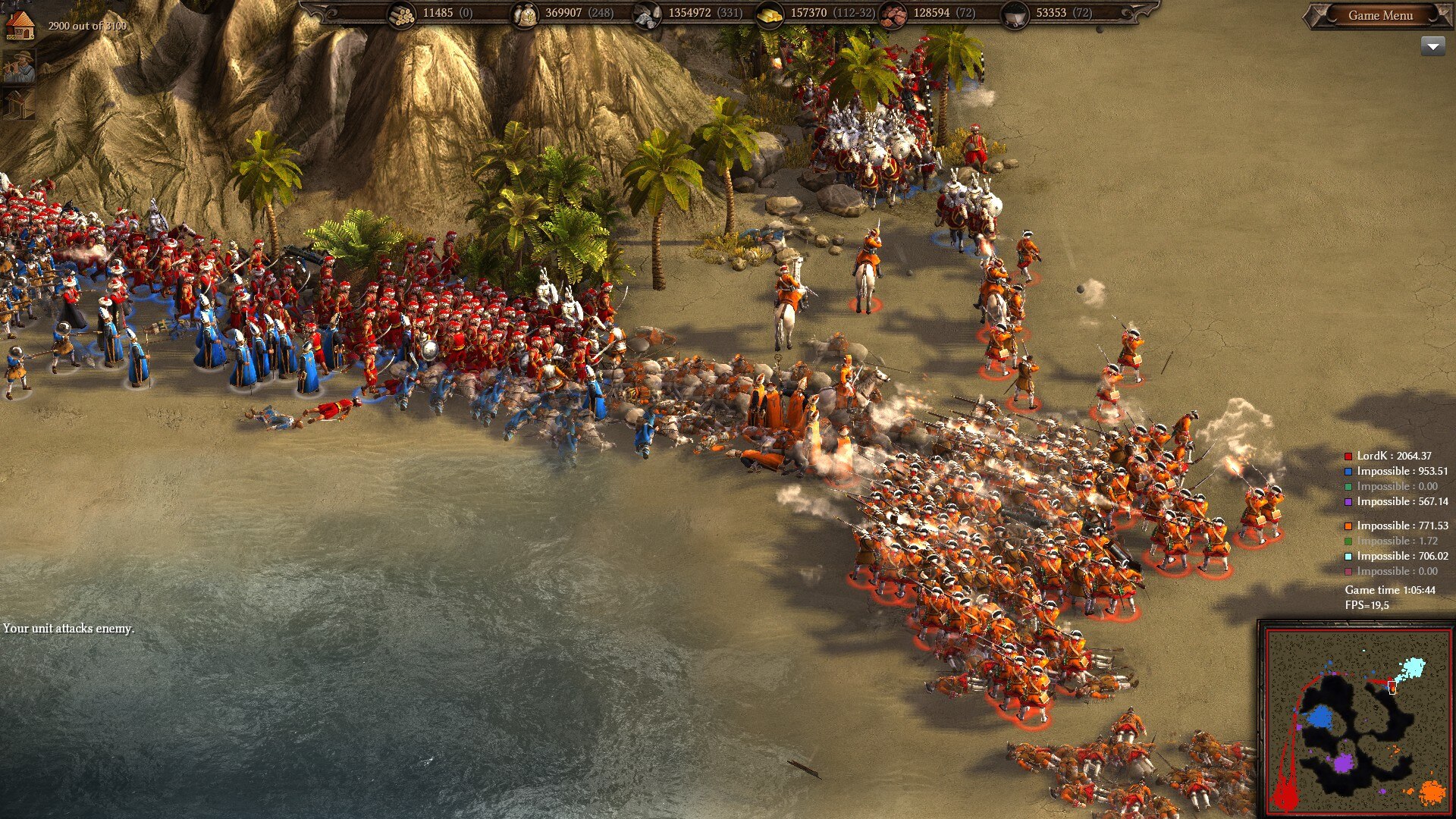
Cover our allies! Light Infantry push out ahead of their stronger (and much more valuable) European teammates to shield them from incoming French fire. This is one of the best ways to play Turkey in the late game if you want to be an asset to your team.
Sure, they’ll get obliterated the moment they get within range of a late-game musket army and have zero chance of winning, but they can be replaced quickly and will absorb bullets meant for more valuable troops (like your allies’ or maybe your own Janissaries), allowing you to field a decent-sized force that can contribute something to late-game battles.
So that’s Light Infantry—a nonstop spam machine that can overwhelm early armies and soak up some gunfire later on. Don’t be fooled by their stats; these muscular, bare-chested men are one of the best tools Turkey has.
Janissary (17th century)
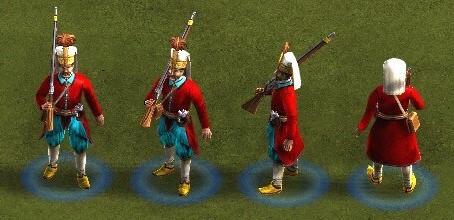
Base stats:
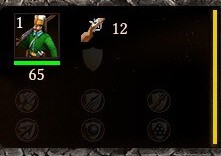
Full upgrades:
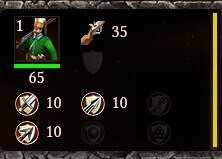
Cost: 55 food, 13 gold, 5 iron
Training time: 8 seconds
Range: 15.94
Reload speed: 4.69 seconds max, 2.3 seconds min.
+ One of the strongest Musketeers of the 17th century
+ High damage
+ Long range for an early Musketeer
+ Gets six Barracks attack upgrades instead of four like most early Musketeers
~ Very long training time to balance out cheap Islamic Barracks
– Low HP
– No melee attack
– Struggles to keep up with high late-game casualty rates
The Janissary is one of the most powerful Musketeers of the 17th century. For a slight drop in HP and a longer training time that’s mostly offset by their faction’s cheaper Barracks, they gain extra range and a big boost in firepower. They perform very well in the early-to-mid game but struggle against the fast-training musket armies that rule the late game.
Compared to normal 17c. Musketeers, Janissaries have -5 HP and take 2 seconds longer to train. The former isn’t a big deal—they usually die in the same number of hits anyway—while the latter can be offset by Turkey’s low-costing Barracks. With 3 Barracks up (which isn’t hard to achieve before the 10-minute mark if you use the Market), Turkey can make 90 Janissaries in 4 minutes while a European country with 2 Barracks will only produce 80 17c. Musketeers.
In exchange for the HP loss and longer training time, Janissaries have an impressive 35 max damage, which is 10 more than most Musketeers. This is allows them to tear through armored troops and kill most other ranged infantry in one or two fewer shots. This is made even better by their range, which is long for an early shooter (15.94 vs 15), allowing them to get the first strike in most 17th century gun battles.
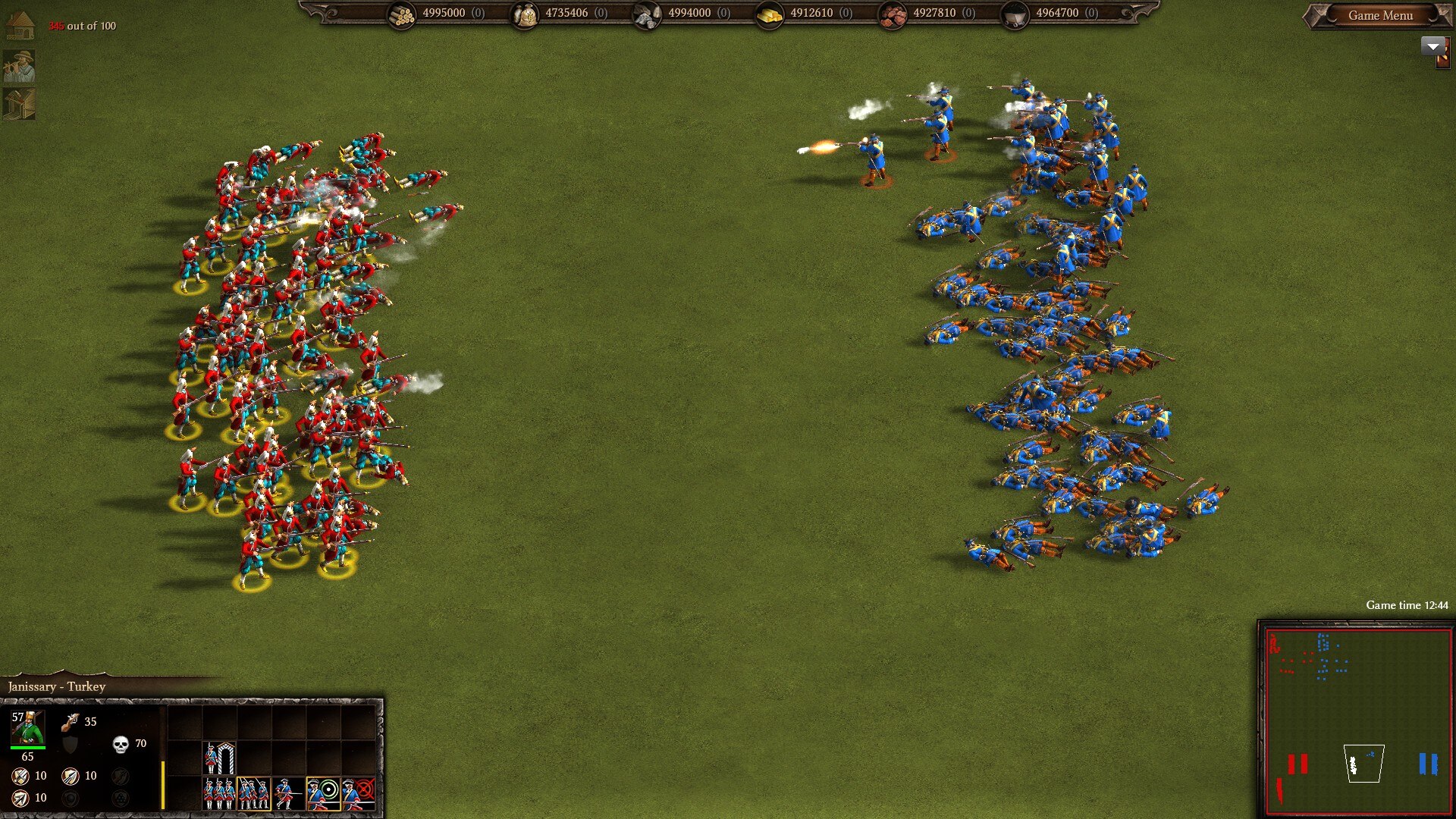
Battle of the best: 90 fully-upgraded Janissaries vs 96 Dutch Musketeers, reflecting the difference in training time (and with 3 cheap Turkish Barracks vs 2 Dutch ones).
This combination of high range and damage serves Janissaries very well on the battlefield. They do well in shooting tests at lower upgrade tiers, but their performance improves dramatically as you research additional techs. By the time the Janissaries are fully upgraded, they’re dominating the competition, easily thrashing famously strong early shooters like Dutch Musketeers and Russian Streltsy. Only Ukrainian Serdiuks can handle fully-upgraded Janissaries in a straight gunfight (and Serdiuks are much more expensive to upgrade, giving Turkish players a potential window when their Janissaries have an upgrade advantage in actual matches).
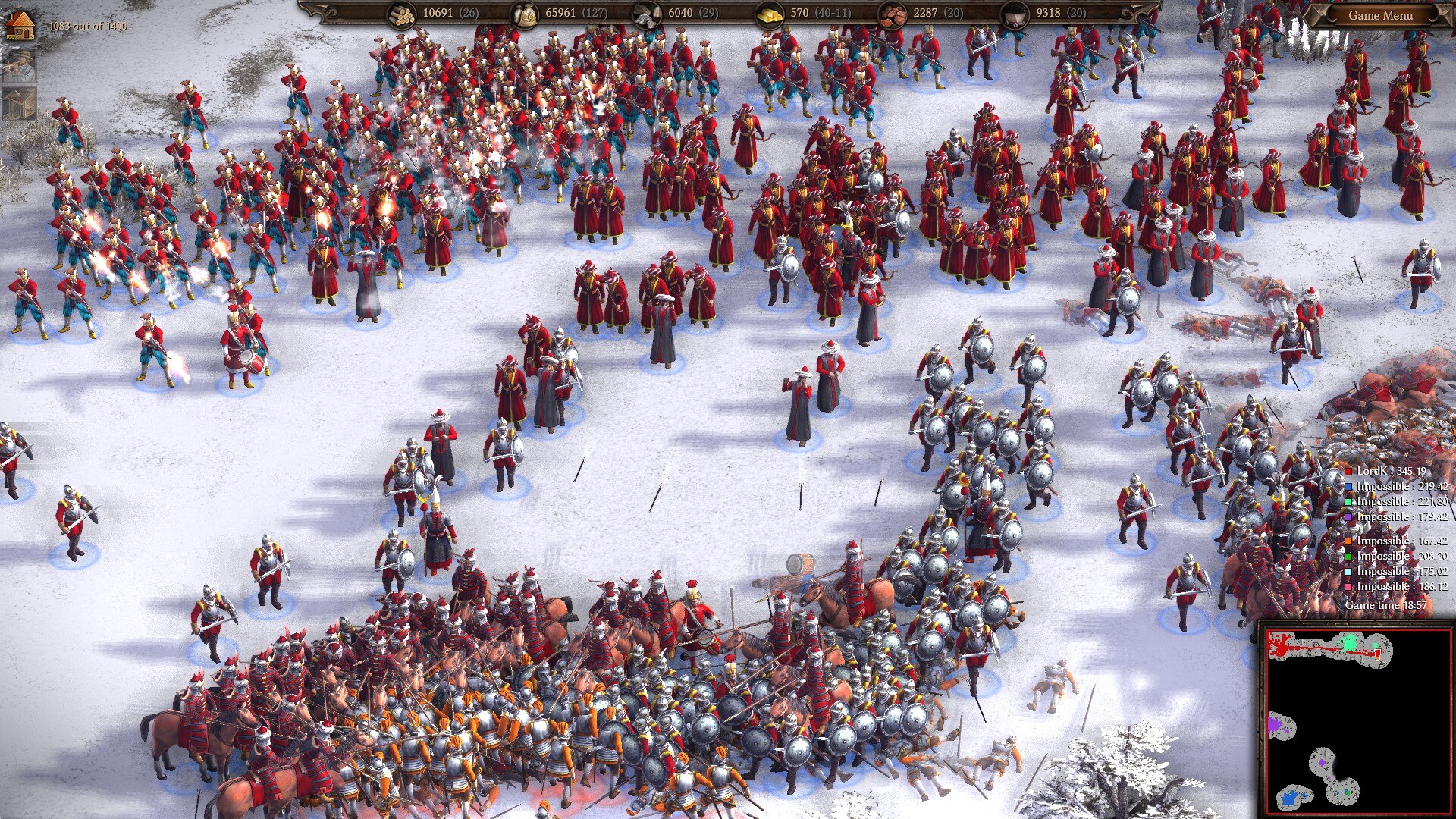
Fruits of the youth levy: An early force of Janissaries, Light Sipahis, Mullahs, and mercenaries engages a Danish force.
In actual matches, Janissaries can be very powerful in the early-to-mid game. There’s some debate about whether Janissaries or Light Infantry are the better pick in 15-minute peacetimes, but for 20+ minutes Janissaries are more potentially powerful. With Turkey’s extra Barracks, they can often outnumber other early Musketeers and even when they don’t, their superior range and damage make them lethally effective.
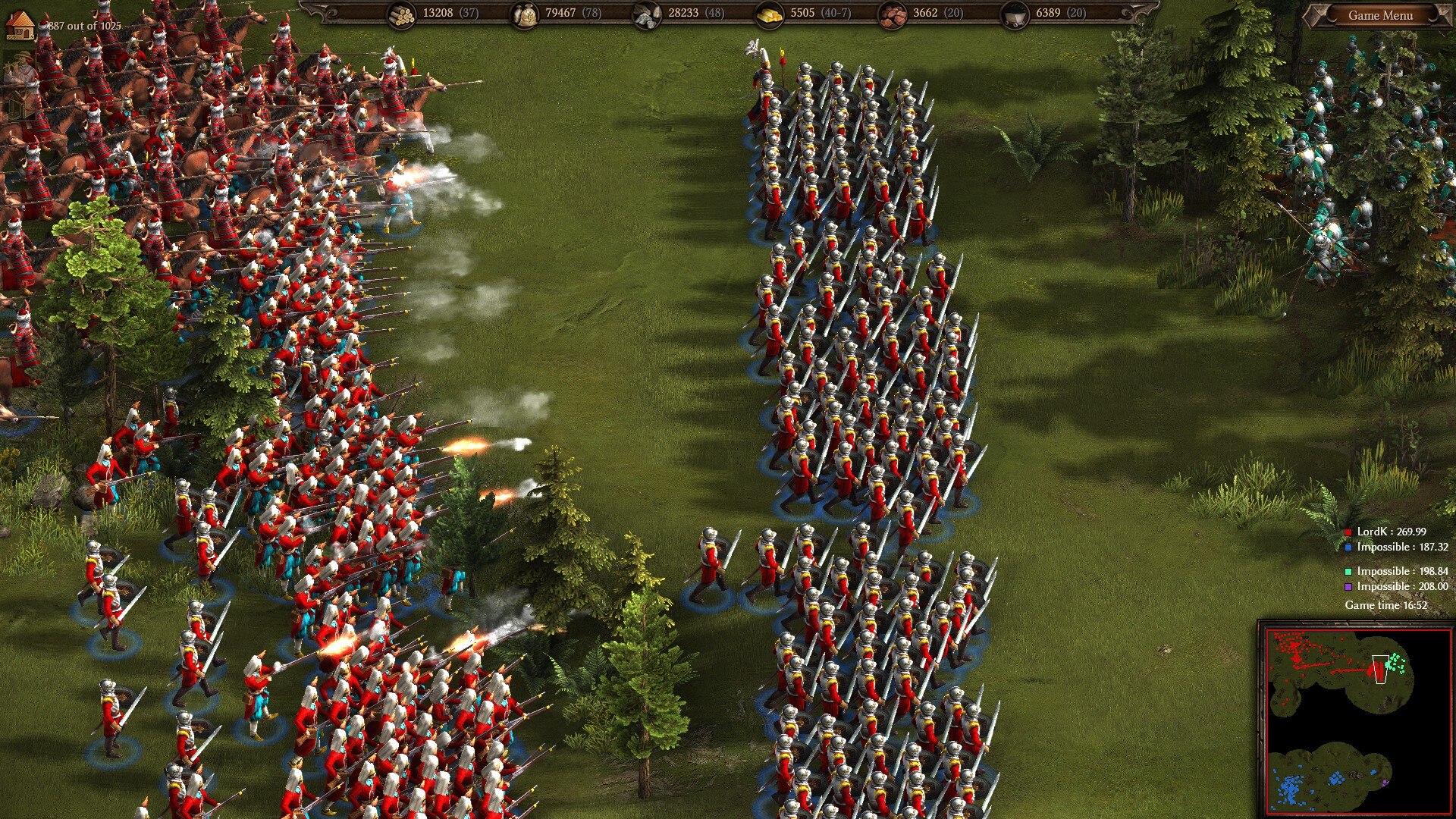
Another early engagement, with the Janissaries showing off their range as they pump hot lead into the enemy from behind their screen of Mercenary Roundshiers.
In the late game, Janissaries lose a lot of their luster. Like all early Musketeers, they can’t compete with the much faster production rate of 18c. Musketeers (who also outrange Janissaries with 16.88 range). This wouldn’t be a problem if Turkey had 18th century units of its own, but since they don’t, your Janissaries will be forced to compete with larger European musket armies that can replenish their losses far more quickly.
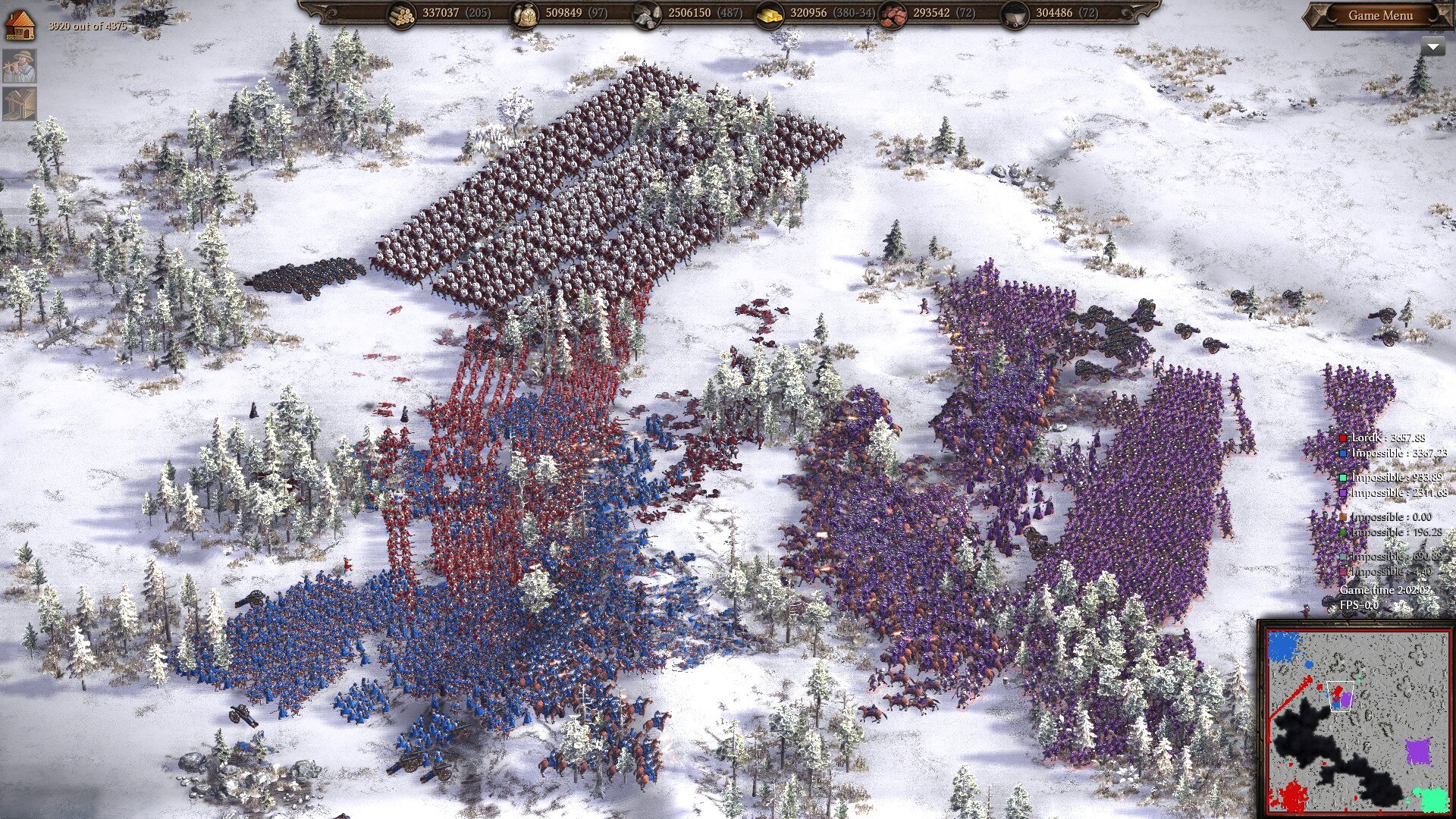
Massive late-game brawl with Janissaries, Heavy Sipahis, and allies, plus Light Infantry to screen them. While this army gave several good fights, it was eventually so ground down that I had to switch fully to Light Infantry just to keep up with the losses.
Although a large, well-managed force of Janissaries can put up a surprisingly stiff fight against an 18th century force–35 damage is still good, even in the late game–they’ll eventually be ground down by the faster-training Europeans. Once that happens, you’ll probably need to switch fully to Light Infantry, and even adding some beforehand to bolster your blocking troops would be a good idea.
Even with that downside (plus the usual “no melee attack” weakness all early ranged units suffer from), Janissaries are a great tool in Turkey’s arsenal that makes them not just competitive but very strong in mid-length peacetime games.
Turkish Archer (17th century)
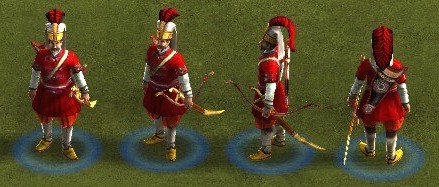
Base stats:

Full upgrades:
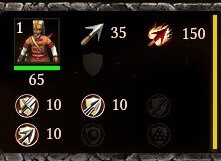
Cost: 45 food, 3 wood, 4 gold
Training time: 3 seconds
Range: 16.88
Reload speed: 2.66 seconds
+ Cheap
+ Fast training time
+ High attack
+ Long range for a 17th century unit
+ Can torch buildings
+ Good at mowing down stationary or closely-packed enemies
+ Doesn’t require expensive Academy upgrades or consume coal and iron to fire
~ Reloads more quickly than unupgraded Musketeers but slower than upgraded ones
– Inaccurate
– Can inflict friendly fire
– Low HP
– No melee attack
– Deals arrow damage
– Very weak to melee cavalry
– Population-inefficient
The unloved stepchildren of their faction’s roster, Turkish Archers are basically Janissaries who traded in their muskets for bows and a fast training time. I already went over the pros and cons of archers in depth while talking about Bow Clansmen during my Scotland guide, so go check that out if you want the whole breakdown of how bowmen differ from Musketeers (or just glance over the pros and cons above if you want the cliff notes version). In the interest of time, I’ll just focus on what Turkish Archers bring to the table.
The main selling points of Turkish Archers are that they’re cheap, train quickly, and can overwhelm ranged troops or any other unit with low arrow armor that’s standing still, giving them a possible role as a Musketeer counter. The problem is that they struggle against moving targets, kill their own blocking troops, and are practically useless against even a small force of heavy or fast cavalry. This means your enemy can very easily counter them if they scout your base and see what you’re making ahead of time.
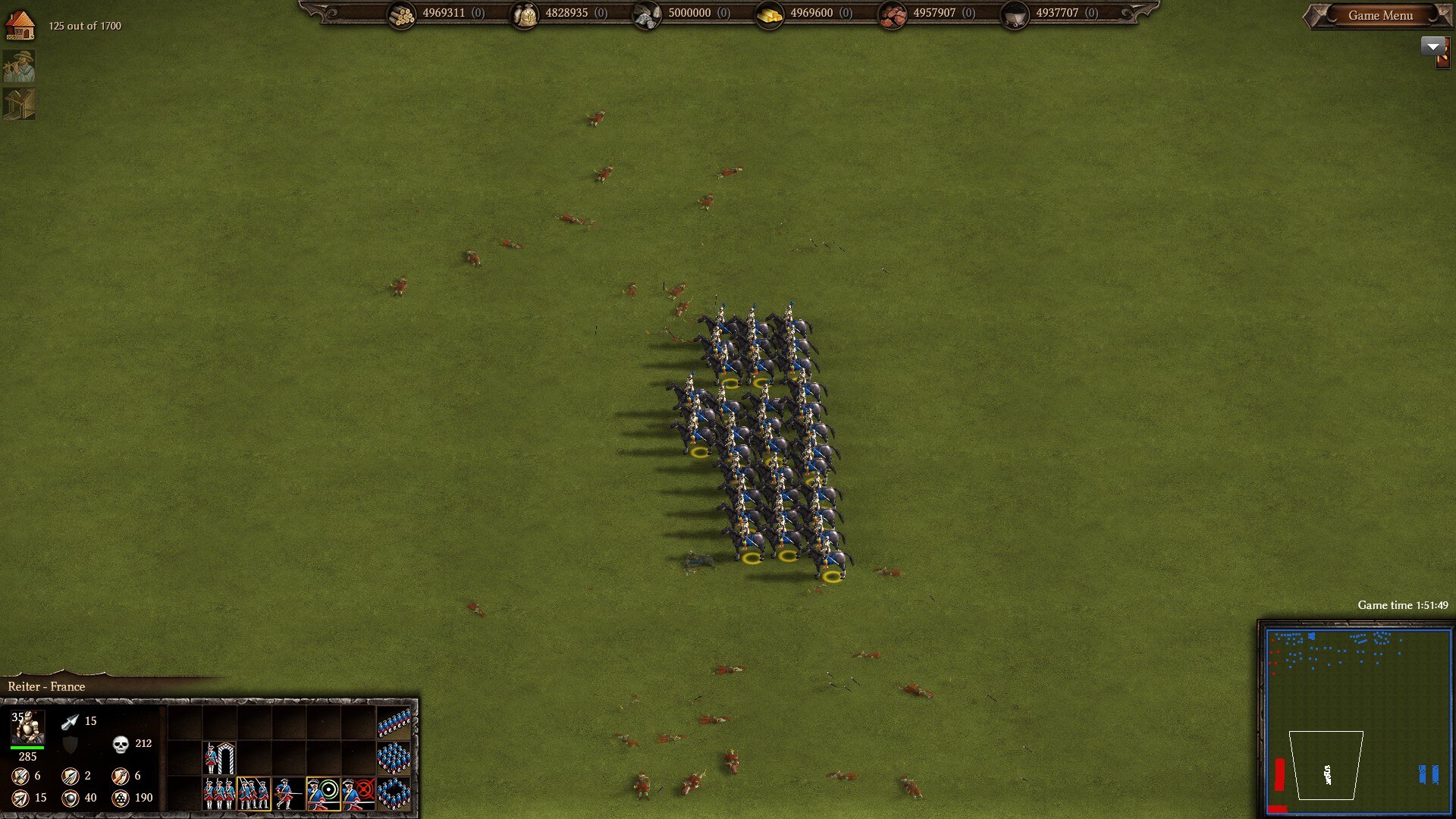
240 unupgraded Turkish Archers versus 45 Reiters. This is what happens whenever a halfway competent force of melee cavalry comes into contact with archers. (Adding upgrades to both units only makes the Reiters dominate harder.)
While proper management of blocking troops can keep your Archers safe, it’s still very much a high risk strategy, and much more difficult to pull off than Turkey’s other units demand.
Bottom line: There’s a very good reason why the Ottomans historically reserved firearms for their elite troops and relegated bows to less-loyal provincial levies (at least until the mid-17th century, when the increasing firepower of European armies forced them to use more Musketeers). Turkish Archers may have potential against musket-centric armies, but they’re hard to make work and are easily countered, especially compared to Turkey’s other infantry choices. I’ve also never seen them used successfully in a high-level game, so I can’t even recommend a good way to use them. (Maybe use Heavy Sipahis to minimize losses to friendly fire?)
Besides, Turkey’s best bowmen come from their Stables, not their Barracks. Speaking of which…
Tatar (17th century)
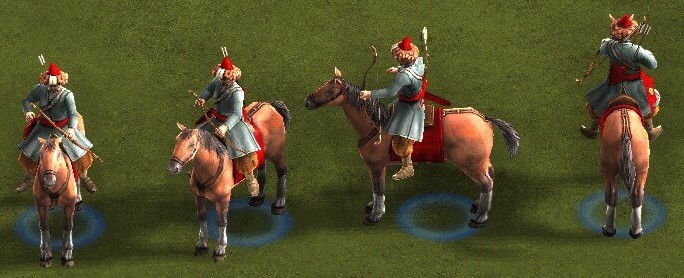
Base stats:
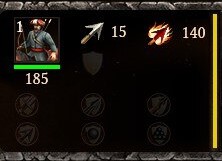
Full upgrades:
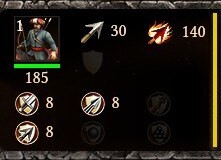
Cost: 70 food, 2 wood, 6 gold
Training time: 11.25 seconds max: 7.5 seconds min.
Range: 20.63
Reload speed: 1.56 seconds
+ Great early-game raider and town-razer
+ Very fast training time for cavalry
+ Very long range
+ Very fast reload speed
+ Can torch buildings
+ Good at mowing down stationary or closely-packed enemies
+ Doesn’t require expensive Academy upgrades or consume coal and iron to fire
– Low HP and defenses for cavalry
– Can’t make formations
– Inaccurate
– Can inflict friendly fire
– No melee attack
– Deals arrow damage
– Scales poorly into the mid and late game
Hailing from Crimea and serving the last khans left over from the Mongol Empire of the Middle Ages, the Tatar is possibly the most unique Dragoon in the game, being armed with a bow instead of a gun. They’re a common choice in high-level, low-peacetime games because of their cheap cost, fast training time, and effectiveness in both early battles and town-razing if micromanaged well.
Stat-wise, Tatars boast the same 30 max attack as normal 17c. Dragoons, but that’s where the similarities end. Their low HP and weak melee/arrow defenses are offset by their rapid training time, lightning-fast reload rate, and jaw-droppingly long range (20.63 vs a 17c. Dragoon’s 15). This range isn’t so useful against units due to the inherently poor archer accuracy, but it does make Tatars great for torching Mines and other buildings with their fire arrows, which is what they’re best at.
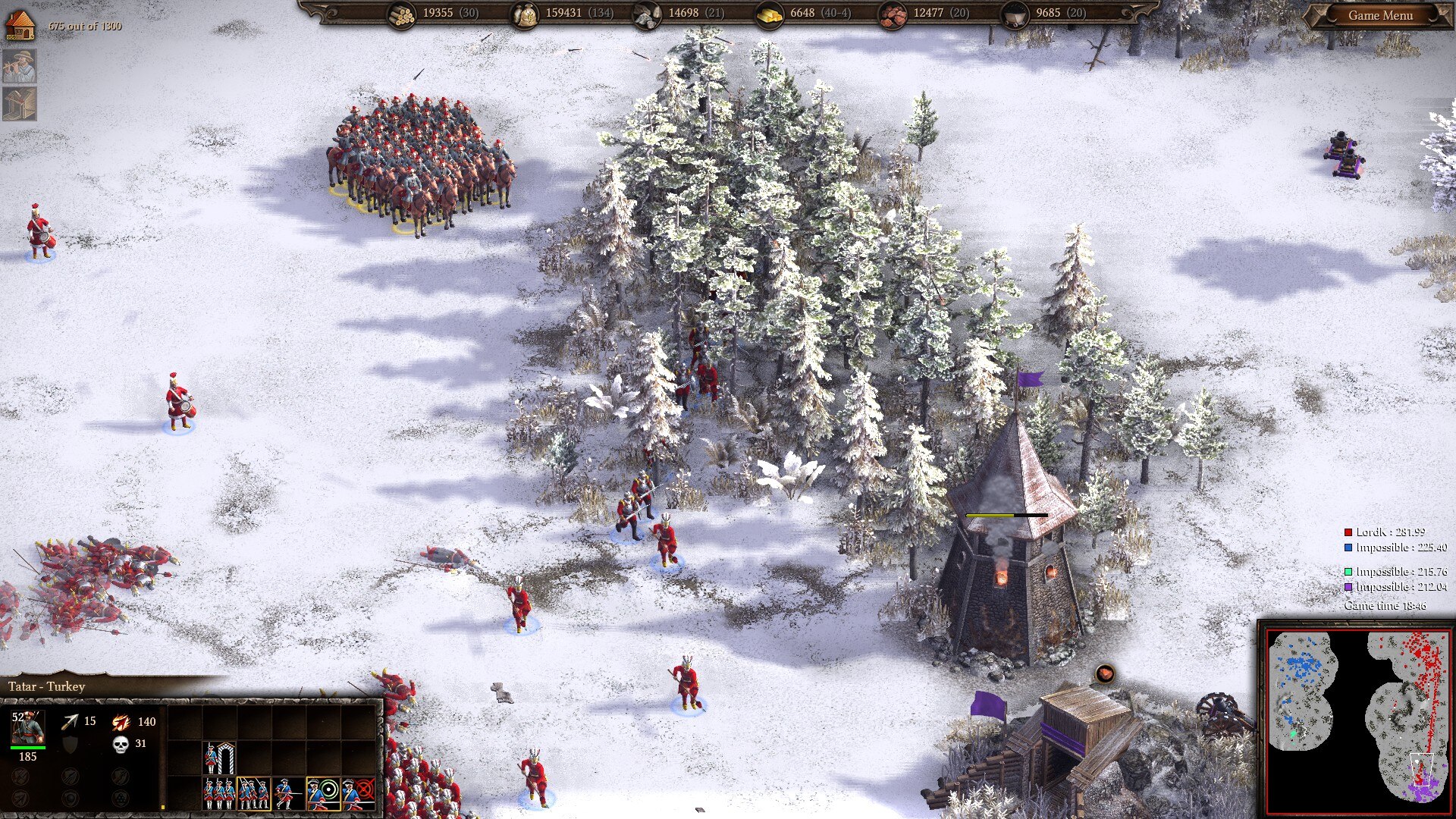
Soldiers of the last khans: Tatars show off their range as they torch a Tower during the storming of a town. This can also be ruthlessly exploited during early-game standoffs to snipe Mines and buildings from afar without the enemy being able to retaliate.
This unique combination of traits makes the Tatar one of the best units in the game for menacing enemy towns early on, able to trot forward, quickly level important buildings, then retreat before the enemy can retaliate. Additionally, their cheap upgrades let you ramp up their attack quickly, allowing them to deal lots of damage in battles (except to upgraded heavy cavalry). Do be mindful of friendly fire, though, as the low arrow armor on Turkish troops (especially Light Infantry) mean they can get shredded by your own Tatars if you don’t direct their shooting with care.
It’s actually very hard to convey how effective Tatars can be in the hands of a skilled player with words and pictures alone. Check out some of the example games to see some true Tatar masters in action.
This, combined with rising arrow armor among enemies and potentially sturdier buildings as upgrades come in, are why the Tatar’s effectiveness declines sharply over time. By the time the mid game rolls around, you’ll probably want to switch over to Sipahis to ensure you have an effective cavalry force. This is also why you probably shouldn’t invest too heavily in your Tatars’ upgrades, especially their defense ones, as you won’t be using them forever in longer games (much like other early Dragoons).
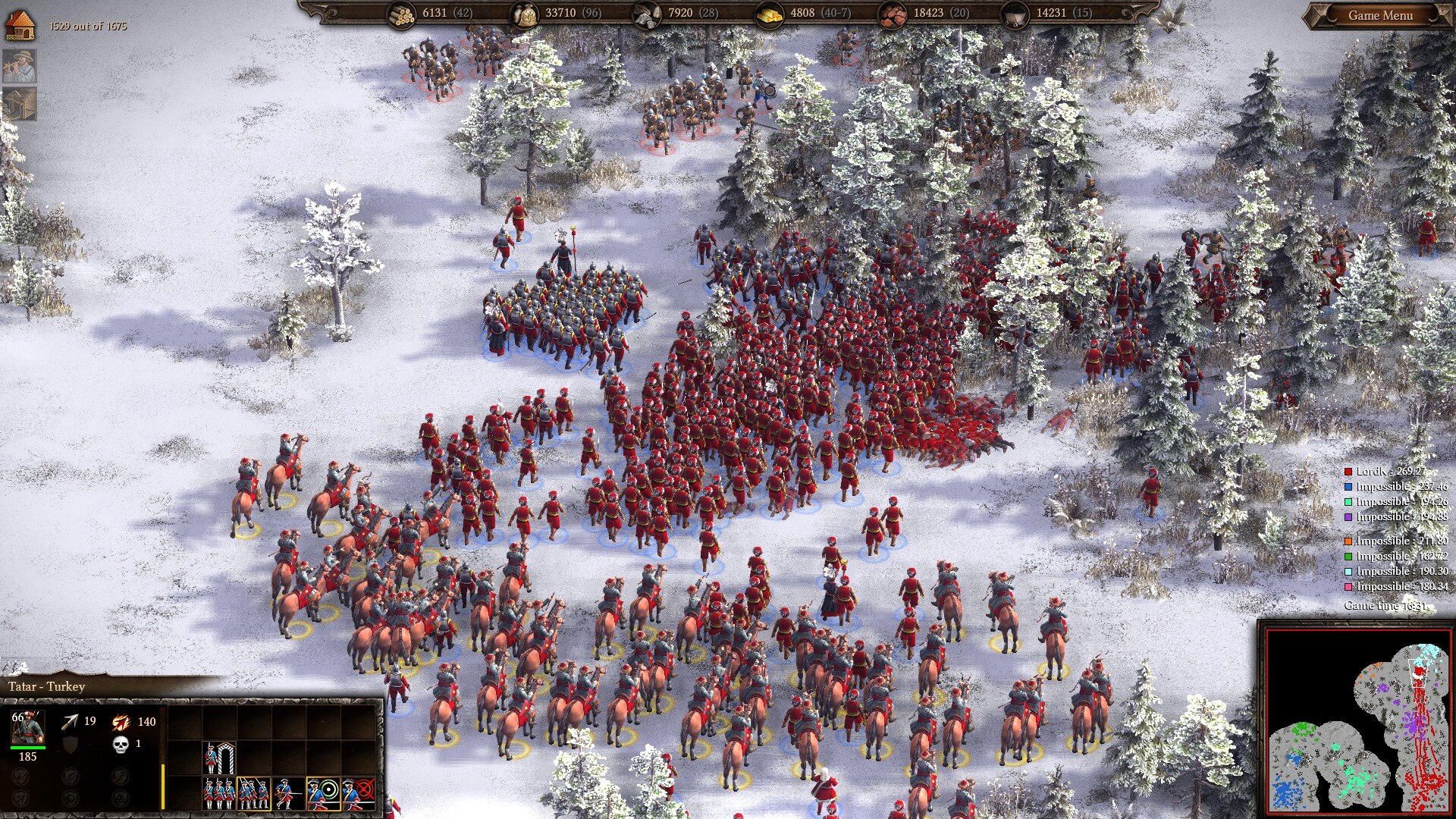
Valued vassals of the Sublime Porte: Tatars lend their fire to a push by Light Infantry and mercs. A lot of the losses are being caused by friendly fire from the arrows, but they’re Light Infantry so I don’t care too much.
Light Sipahi (17th century)
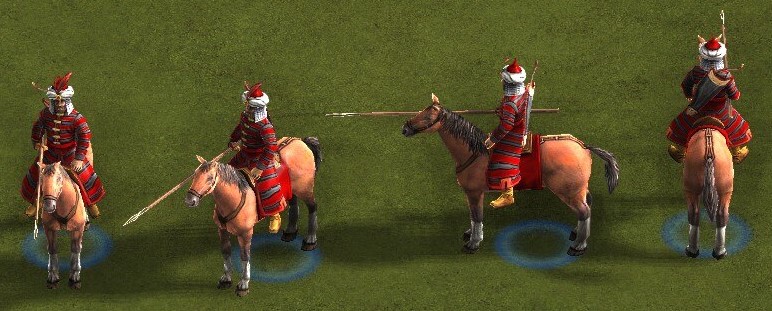
Base stats:

Full upgrades:
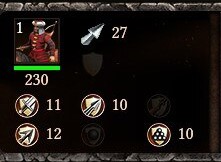
Cost: 80 food, 6 gold, 5 iron
Training time: 9 seconds max: 6 seconds min.
+ Very fast training time for cavalry
+ Low cost
+ Good in melee fights
+ Great for quickly building a large army or replacing losses
– Unarmored
– Expensive upgrades
– Slightly worse at tanking bullets than Heavy Sipahis
Turkey’s two Sipahi units fill very different roles. The Light Sipahi (which probably represents the feudal cavalry raised from the empire’s provinces) is the spammier option; a fast-training, unarmored melee cavalry unit in the vein of Polish Light Reiters and Ukrainian Register Cossacks. They’re good in melee fights and are great for quickly building up a decent-sized cavalry force, especially given Turkey’s fewer Stables.
Like most spammer cavalry, Light Sipahis don’t wow with their stats. In fact, they look like a Hussar that’s given up their speed and a bit of attack for a couple extra points of sword and arrow armor. They do deal pike damage instead of sword damage, which is good since many units have lower pike armor (though it does mean they can’t chop through Palisades), but other than that they aren’t very impressive.
Naturally, the big advantage of Light Sipahis is their training time. At 6 seconds, even just a couple of Turkish Stables can produce a strong force of melee cavalry—80 in 4 minutes, to be precise. This is what gives Light Sipahis their edge, as few other melee units can match their mix of stats and numbers.
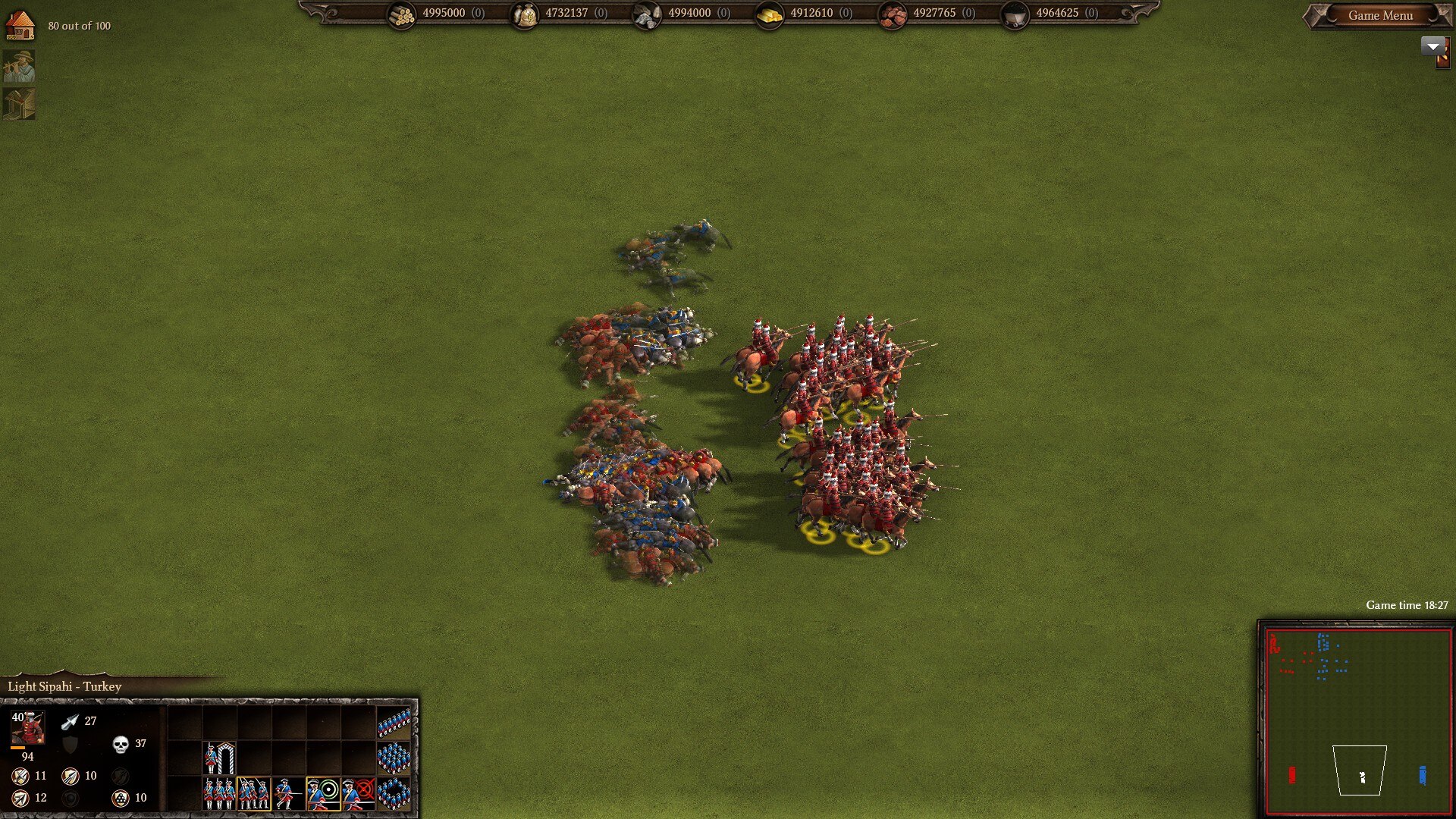
A second Varna: 80 fully-upgraded Light Sipahis vs 45 Reiters.
In tests with other melee cavalry, Light Sipahis did very well, especially at lower upgrade tiers. Even with full upgrades, only Cuirassiers, Saxon Cavalry Guards, Ukrainian Register Cossacks, and Russian Vityazes and Don Cossacks were able to consistently beat them; every other melee cavalry lost. That’s a very good performance and it makes Light Sipahis a very strong, quick-replenishing melee threat in the early-to-mid game.
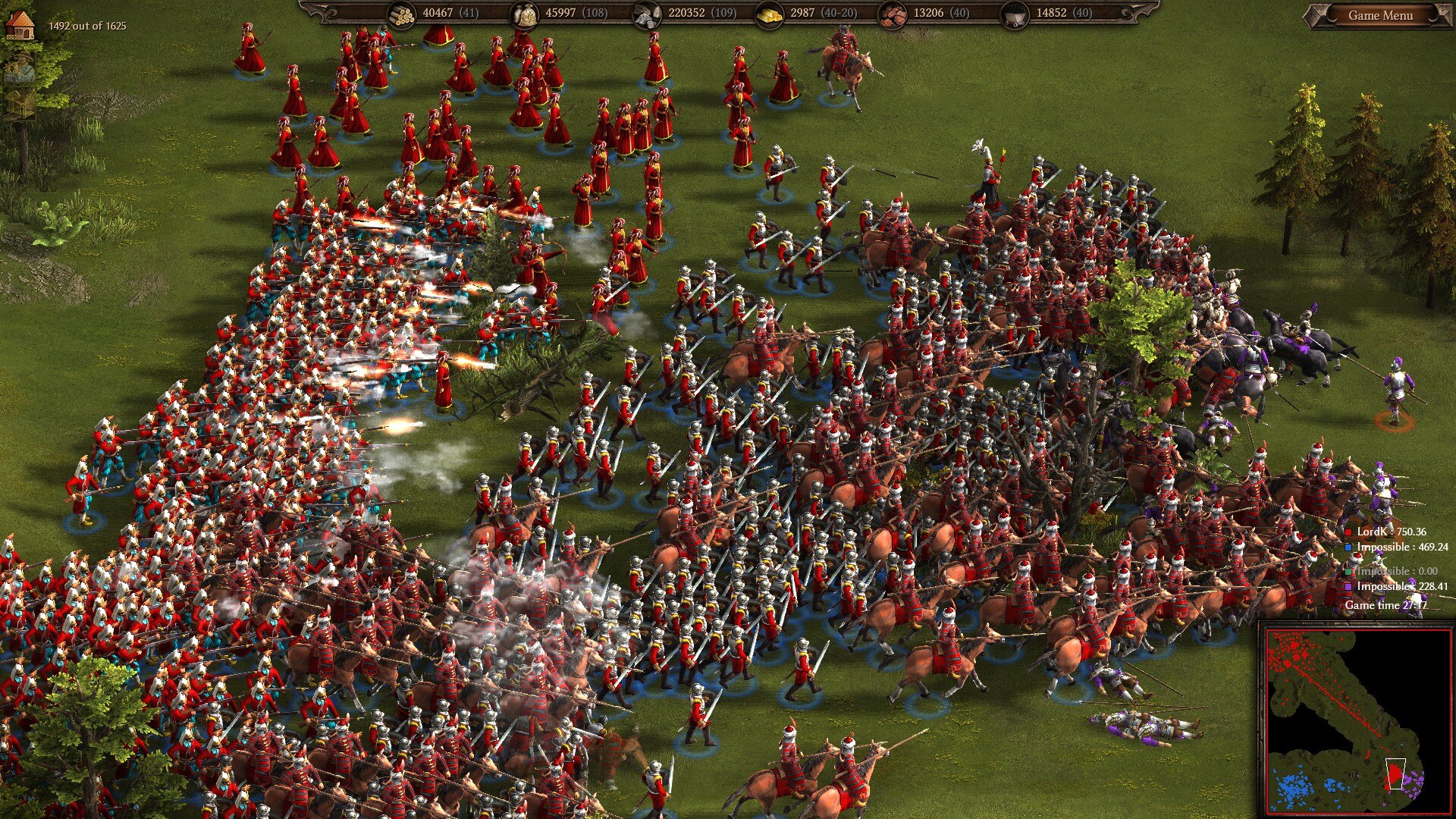
Storming Crete: A mid-game army of Light Sipahis, Janissaries, and mercs works the Venetians over. The quick training time of Light Sipahis makes them a good match for Janissaries, allowing you to maintain a decent-sized army despite your slow-producing infantry.
There is an important caveat to those tests, however: They all assumed that the Turks had two Stables while their opponents had three. That’s a reasonable amount for the early-to-mid game, but once other countries’ economies grow and they start building more of their cheaper Stables, the cavalry ratio turns increasingly in their favor. There’s nothing you can do to stop this (apart from wiping the other nation out early on), so just be aware of it.
Aside from that, Light Sipahis have two other weaknesses. The first is their Stable upgrades, which cost significantly more than those of Tatars and Heavy Sipahis. The second is their lack of bullet armor, which makes them less effective at tanking gunfire for your army later on. If you want to optimize your army for battle against musket-armed foes and don’t care about melee combat, you might want to forgo Light Sipahis in favor of their older brothers…
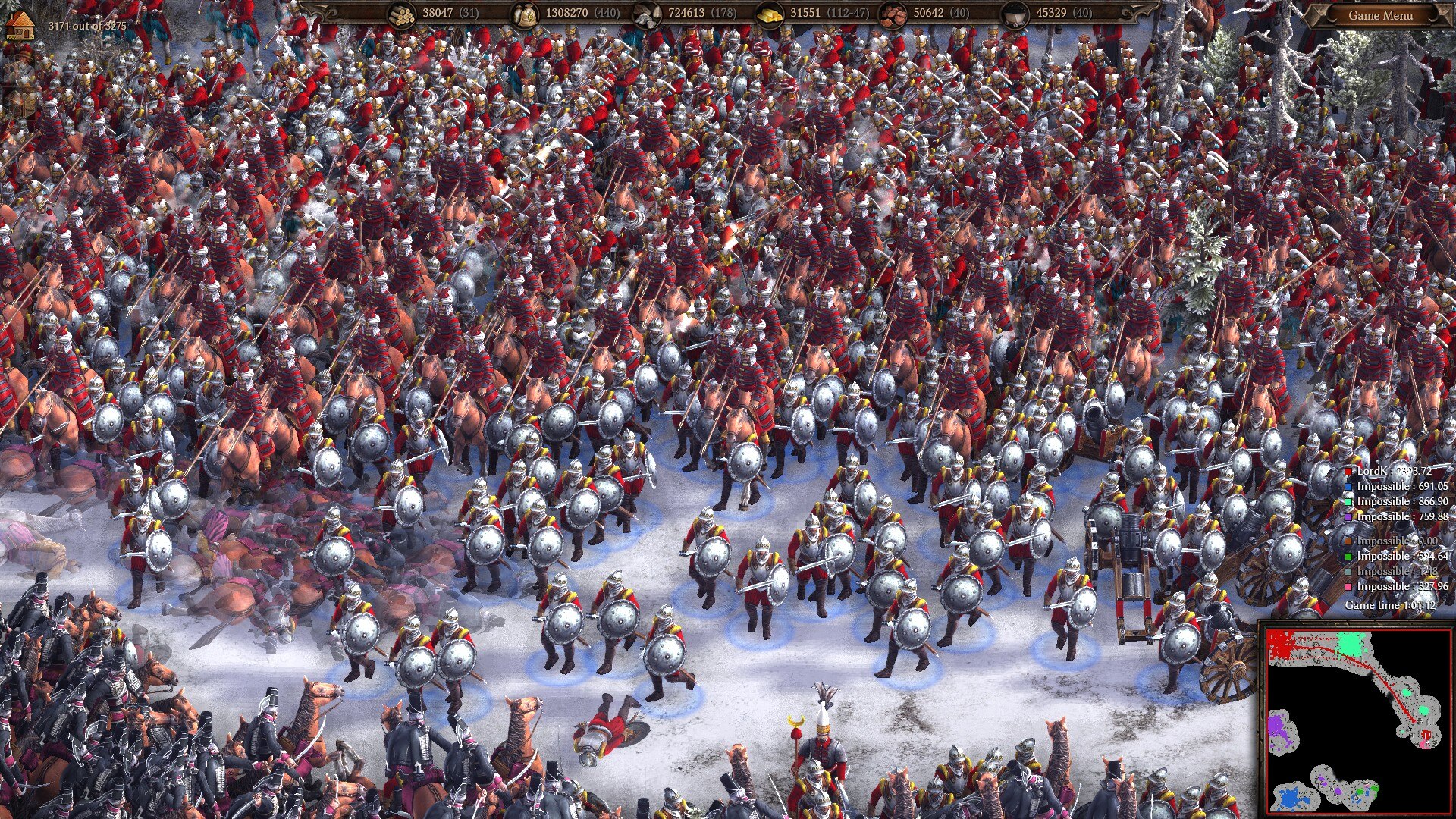
These fools are the ones who beat Austria?! Light Sipahis charge toward defending Prussians alongside their accompanying Roundshiers and Janissaries. (Engaging Prussia in the late game is usually a risky business, especially for Turkey, but they’d lost their main army shortly beforehand so I decided to hit them while they were down.)
Heavy Sipahi (17th century)
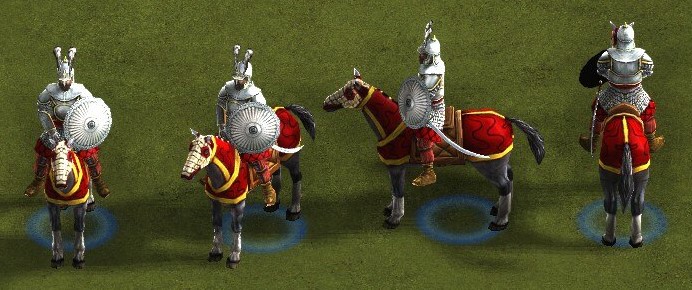
Base stats:

Full upgrades:

Cost: 130 food, 20 gold, 70 iron
Training time: 18 seconds max: 12 seconds min.
+ Best Turkish cavalry for tanking bullets
+ Very high HP
+ Cheap Stable upgrades
+ Population-efficient
+ Benefits from armor upgrades at the Academy and Blacksmith
~ Does sword damage
– Very high iron cost
– Slow training time
– Worse in melee than Light Sipahis
The Heavy Sipahi (likely representing the sultan’s elite household regiments who served as mounted, non-slave rivals to the Janissaries) is Turkey’s best bullet sponge; a costly, tough-as-nails heavy cavalry unit whose primary purpose is to ride out in front and soak up gunfire so other units don’t have to. He’s helped in this by being the only Turkish unit with bullet armor and the only one who benefits from the armor techs. (He’s also a new addition to Turkey’s roster for Cossacks 3, having not been in previous titles.)
Stat-wise, Heavy Sipahis are pure tanks. Their attack is middling for heavy cavalry and their use of swords limits their damage output against lots of enemies, but they make up for it with a monstrous 360 HP and 8 bullet armor. These two stats combined make Heavy Sipahis very resistant to gunfire, falling somewhere between a Reiter and a Cuirassier in bullet-tanking ability:
Shots to kill (full upgrades)
You might think that Light Sipahis would be able to tank more gunfire as a whole thanks to their twice-as-fast production speed. This isn’t true, however, as with full armor upgrades and equal training time, a group of Heavy Sipahis can resist more bullets than an equivalent force of Light Sipahis:
80 Light Sipahis * 10 25-damage shots per unit = 800 shots to kill
40 Heavy Sipahis * 22 25-damage shots per unit = 880 shots to kill
Granted, 80 Light Sipahis will beat 40 Heavy Sipahis in a melee battle (unless the Heavy Sipahis have a big tech advantage, which they very well might considering how much cheaper their upgrades are), but the point remains; if you want to maximize your army’s resistance to musketry, Heavy Sipahis are the superior option. It helps that Heavy Sipahis only take up half the population space, allowing you to fill the remainder with other units that further the tankiness of your force, even if they’re just Light Infantry.
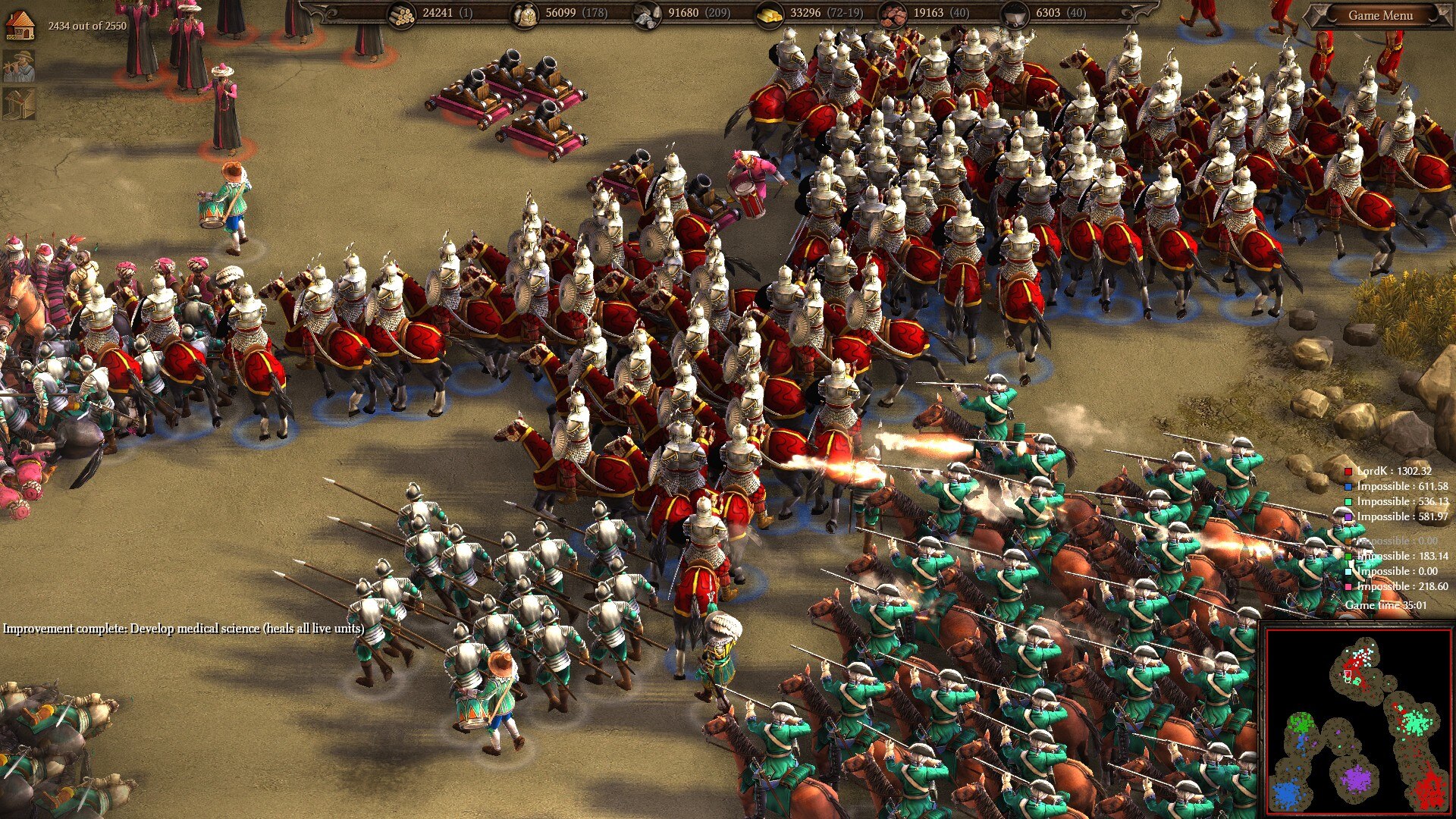
1600s superpowers unite! Heavy Sipahis place themselves in front of their Spanish ally’s Dragoons, keeping rival Turks from interfering. Say what you will about Heavy Sipahis, their in-game models look amazing.
Other than their tankiness, Heavy Sipahis are a pretty unremarkable heavy cavalry unit. They’ll slaughter Pikemen and laugh off arrows all day long like an armored horseman should but they struggle against others of their kind, only beating Swedish Reiters, Scottish Lancers, and Polish Light Reiters in tests. (It gets even worse once the Europeans max out on Stables later in the match.) They also cost a staggering 70 iron apiece, which is ludicrously high even compared to other heavy horsemen.

Europeans’ revenge: 40 fully-upgraded Heavy Sipahis vs 45 Reiters.
Perhaps the biggest issue with Heavy Sipahis is that they’re the Turkish cavalry option least suited for early aggression. Their super high iron cost is draining on an early economy and they can’t raze a base like Tatars or dominate initial melee fights like Light Sipahis (though they are much cheaper to upgrade than the latter, so they could potentially achieve early superiority with a tech advantage). Since Turkey is all about the early game, Heavy Sipahis often feel out of place and don’t jive with the preferred rushing tactics, which is why you don’t see them used often.
Still, Turkish armies are desperately weak to gunfire in the later stages of the game and Heavy Sipahis are a direct answer to that vulnerability. They might not be a go-to pick in the types of games Turkish players favor, but if the match revolves around Musketeers or goes late, the sultan’s elite household cavalry stand ready to answer your call.

Servants of the Sublime Porte: Janissaries and Heavy Sipahis (plus the obligatory mercs) advance into battle. A large army like this is by far the strongest possible force Turkey can field in terms of power-per-soldier, but the slow training time of its units makes replacing casualties a nightmare, especially in the attrition-heavy wars of the late-game, which is why you don’t see it used online. It does look super cool, though.
Mullah (17th century)
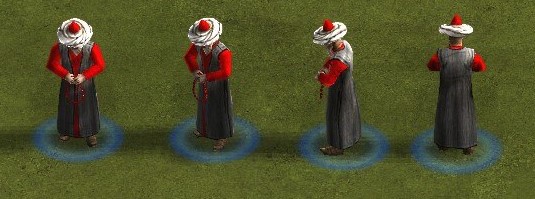
Stats:
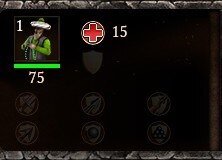
Cost: 30 food, 10 gold
Training time: 15 seconds
+ Cheapest and fastest-training healer in the game
+ Outperforms other healers when in large numbers
+ Trained at the Mosque–doesn’t interfere with Peasant or military production
– Very slow training time
– Requires gold upkeep
– Individually worse than other healers
– Need to go out of your way to build a Mosque
The Mullah is the game’s Islamic healer and, like many other Islamic units, emphasizes quantity over quality. This works out well for them as despite being the worst healer in the game stat-wise, healing the least health per second (hps), Mullahs can potentially outperform all other healers thanks to their greater numbers.
Compared to the typical European Priest, Mullahs cost significantly less (most notably -10 gold) and train 5 seconds faster (15 seconds vs 20). They also have the lowest gold upkeep and hps of any healer:
Mullah: 15 hps, 53 units/1 gold per second
Priest: 20 hps, 40 units/1 gold per second
Pope: 25 hps, 40 units/1 gold per second
Padre: 30 hps, 19 units/1 gold per second
So the obvious question is: Is a larger number of worse healers better than a few good ones?
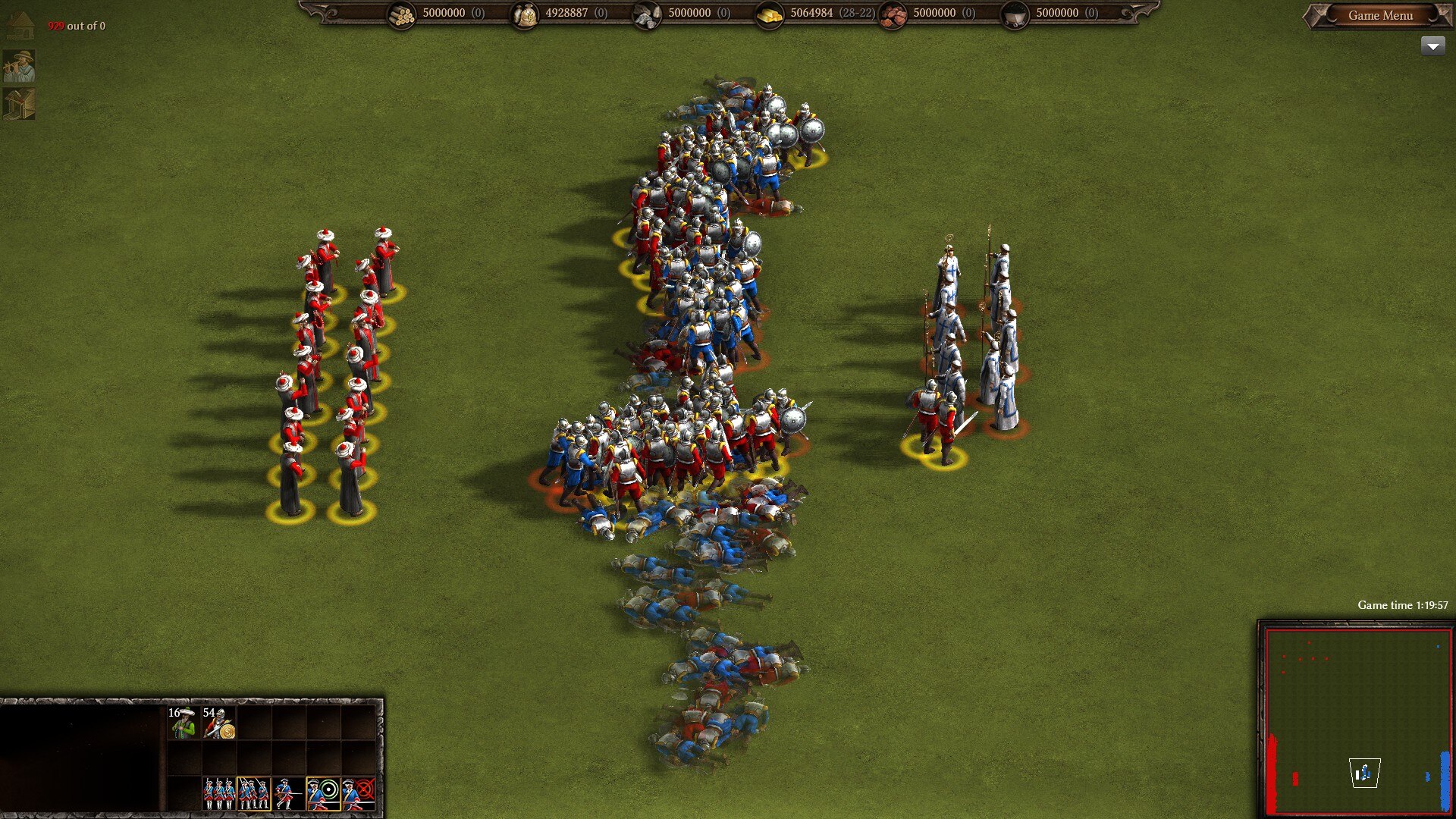
All praise be to God! 16 Mullahs versus 10 Padres, reflecting the difference in training time. In each test, both sides were tasked with supporting 160 Mercenary Roundshiers to create an equal (if unrealistic) force for the healers to work with.
The answer is yes. In repeated testing, the Mullahs performed the best of the game’s four healers. They went undefeated against Priests and Piedmontese Padres and eked out a close victory over Popes (6 wins to 4). Considering that Mullahs also have a much lower gold upkeep, there’s a strong argument to be made that they’re the best healers in the game, and their presence can make Islamic armies even more deadly in the early-to-mid game.
There are a few caveats, of course. First, like all healers, they tend to walk forward blindly and get cut down if you don’t micro them separately from your other troops. Secondly, unlike other factions, Islamic countries don’t require a Mosque for aging up, meaning you have to go out of your way to build one. You probably still should–it’ll buff your army plus your forces are so cheap that the Mullah’s reduced gold upkeep won’t be an issue–but only once you can’t easily afford other production buildings like Barracks and Stables.
Still, Mullahs are great healers, cheap and efficient, and they can help keep your armies alive if you can spare the resources to start producing them. They may not be a mandatory unit that you see in every game, but when you do have them working for you you’ll probably be glad for it.
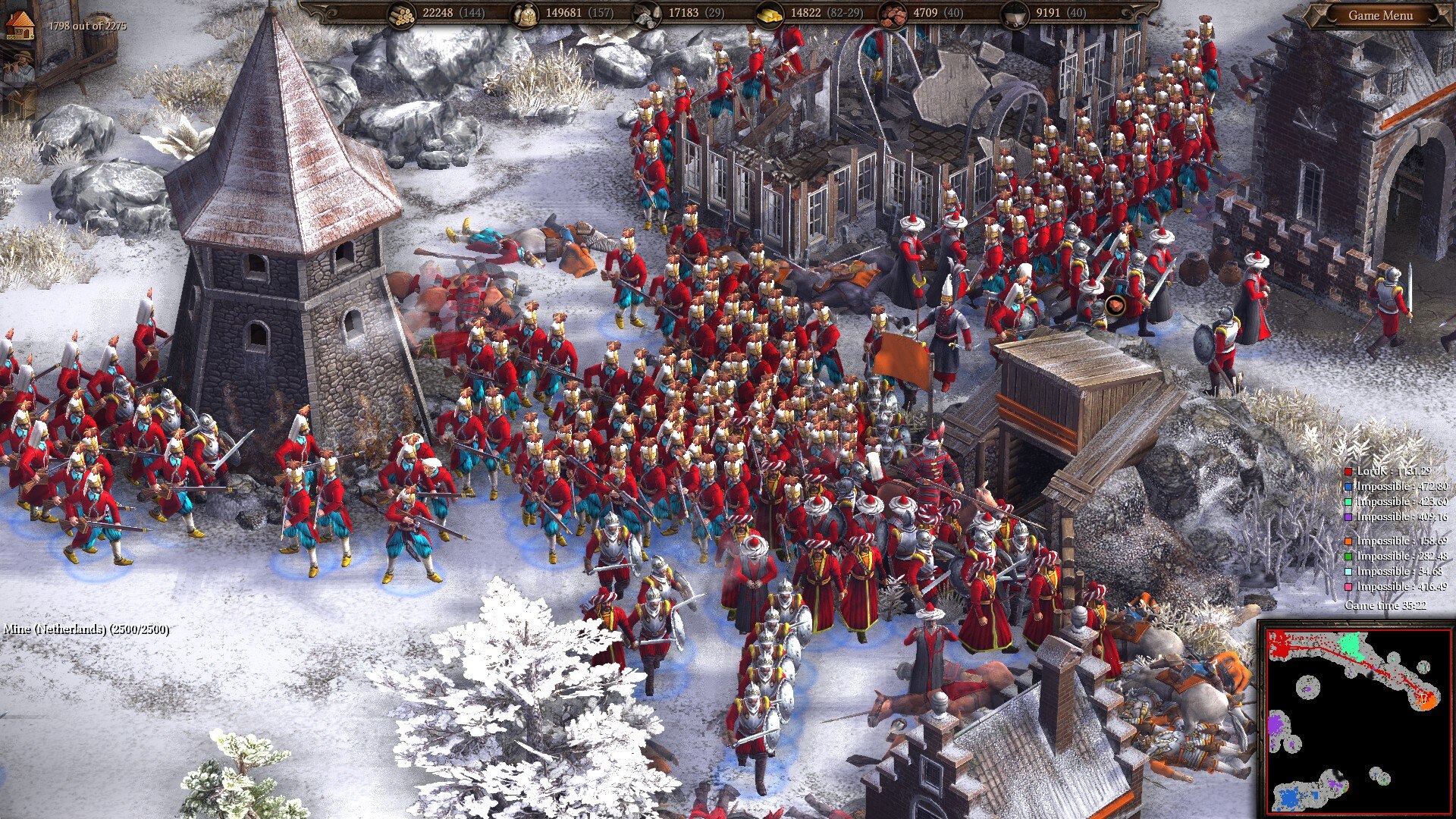
Crushing Dutch heathens: As Janissaries and mercs fight their way through the streets, the army’s Mullahs keep their health topped up.
Islamic Yacht (17th century)

Stats:
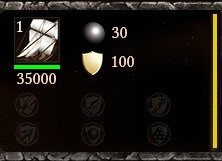
Cost (base): 900 wood, 450 gold, 150 iron, 200 coal
Training time: 48 seconds max: 24 seconds min.
Range: roughly the same as a fully-upgraded Howitzer
Reload speed: roughly 13 seconds
Gold upkeep: roughly 1.85 gold per second
NOTE: Stats for non-generic ships are hard to find, so this entry is based on tests and comparisons to other units.
+ Cheap low-tier warship
+ Stronger and faster than normal Yachts for the same price
+ Has built-in armor
+ Longer range
+ Damage is higher than what the stat card says
+ Benefits from artillery range and accuracy techs at Minaret
– Requires artillery depot to unlock
– Very high gold upkeep
– Cost scales up with each unit made
– Movement right after receiving orders is even jankier than other ships’
The Islamic Yacht is basically a European Yacht but better. That’s it; everything the standard Yacht is or does, the Islamic Yacht is either better or at worst identical at. This, on top of their other bonuses, gives Islamic nations a big military advantage in early water combat that can easily snowball a game. The only thing that’s worse is its gold upkeep, but that’s a price worth paying if it means securing the water for your team.
Stat-wise, Islamic Yachts are largely the same as European ones—same escalating cost, seemingly similar damage (despite what the stat card says), much longer range, and far faster movement, especially before both sides get the naval movement speed upgrade. This allows Islamic Yachts to zoom across the map, preying on other early fleets and harassing land forces while staying away from anything that might threaten them.
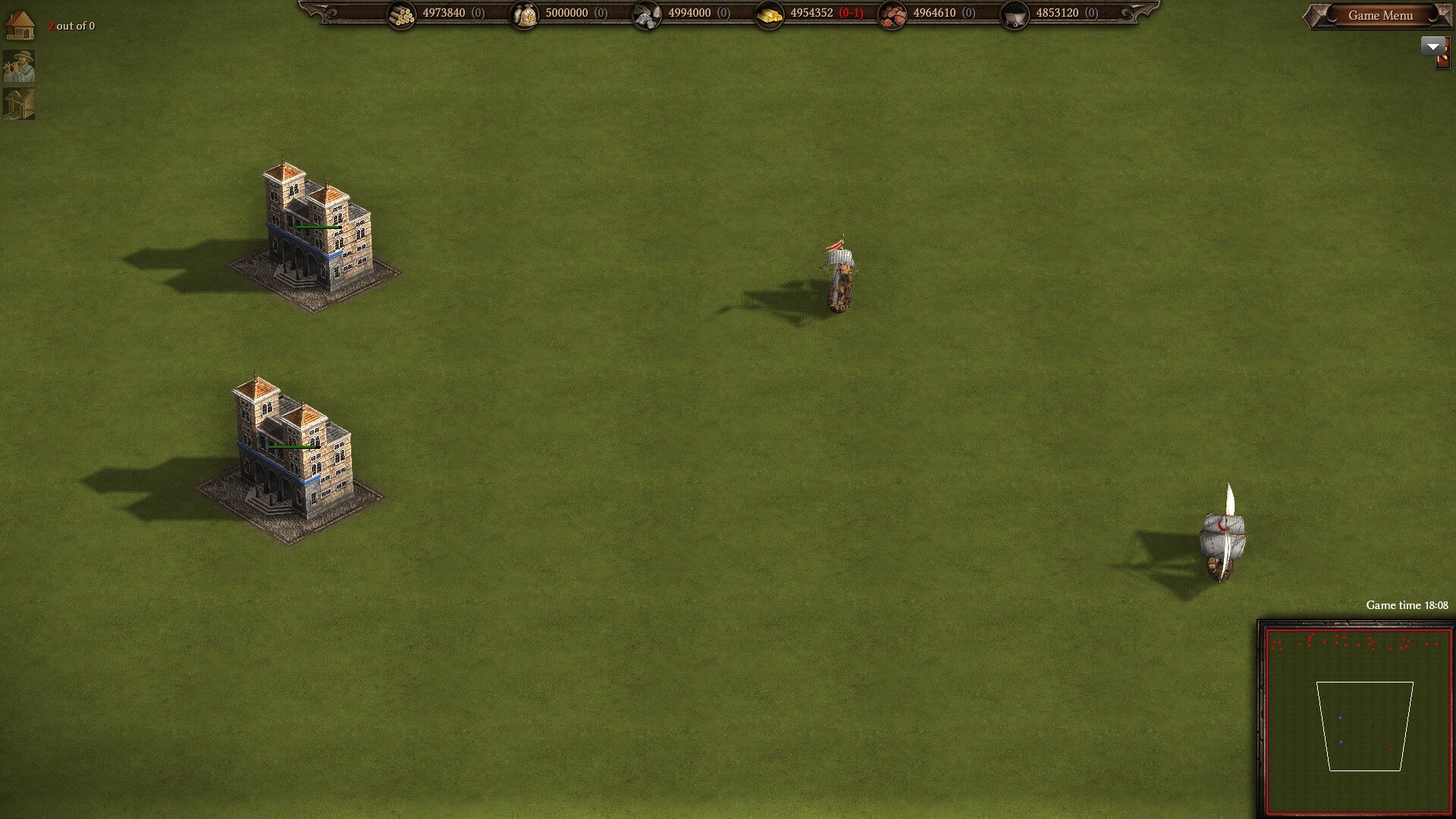
Range test: Islamic Yacht vs standard Yacht with full upgrades. The damage their shots did to the unupgraded 18c. Barracks was pretty random (sometime a few hundred damage per hit, sometimes a few thousand) but similar overall.
To prove this prowess, I pitted twelve Islamic and standard Yachts against each other in a series of one-on-one duels. The Islamic ships won each time, usually in overwhelming fashion.

Total sweep: The victorious Islamic Yachts pose for the camera after going 12-0 against their European counterparts (often with most of their HP left).
They performed about evenly with Ukraine’s Chaika, with the Yacht’s defenses and the Chaika’s fast rate of fire canceling each other out. Which one is better depends on which strengths and weaknesses you prefer: The Chaika has no gold upkeep and can fire behind it while the Islamic Yacht is faster and costs less to build.
The only downside to Islamic Yachts is their high gold upkeep, which is so far above the normal Yacht’s upkeep that it’s comical:
Gold Upkeep Comparison
Yacht: 1 ship = roughly 0.0625 gold per second
Islamic Yacht: 1 ship = roughly 1.85 gold per second
This is annoying as it means you won’t be able to field as many Yachts as your European foes if you give them time to build up a small fleet. Fortunately, Islamic Yachts are strong enough that it’s very easy to just charge in and beat the tar out of them before they can do that.
In conclusion, Islamic Yachts are well worth their absurd upkeep. You probably shouldn’t make too many of them, but you won’t need more than a few to secure early naval superiority. Slam down your Shipyards, crank out some Yachts, and remind those Europeans that the Mediterranean is your lake.
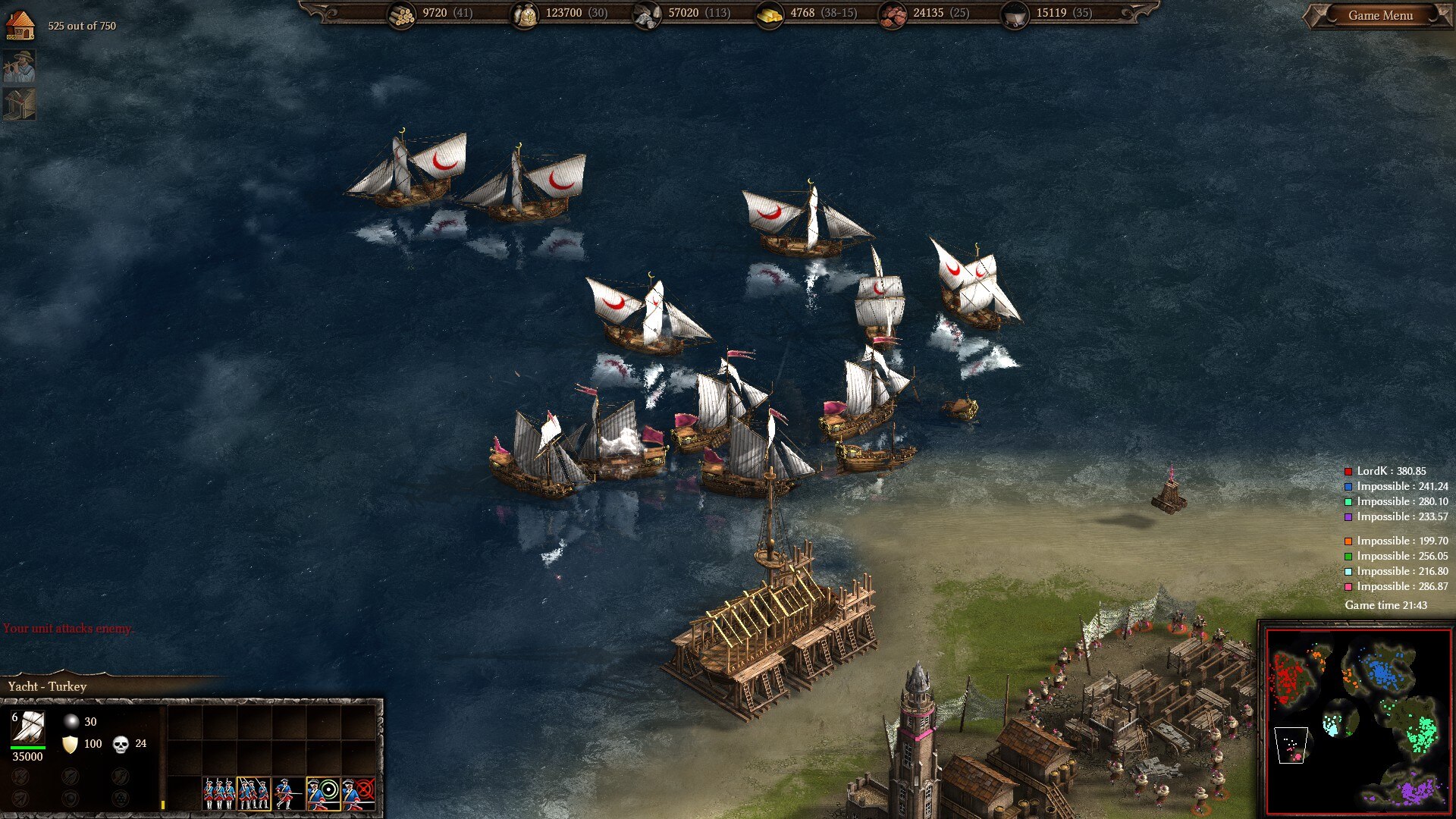
A second Preveza: Islamic Yachts beating the snot out of normal Yachts. (I’ve actually split my Islamic Yachts between two fronts since they’re so much better than what the Europeans have that I don’t need my entire force to dunk on them.)
Xebec (17th century)
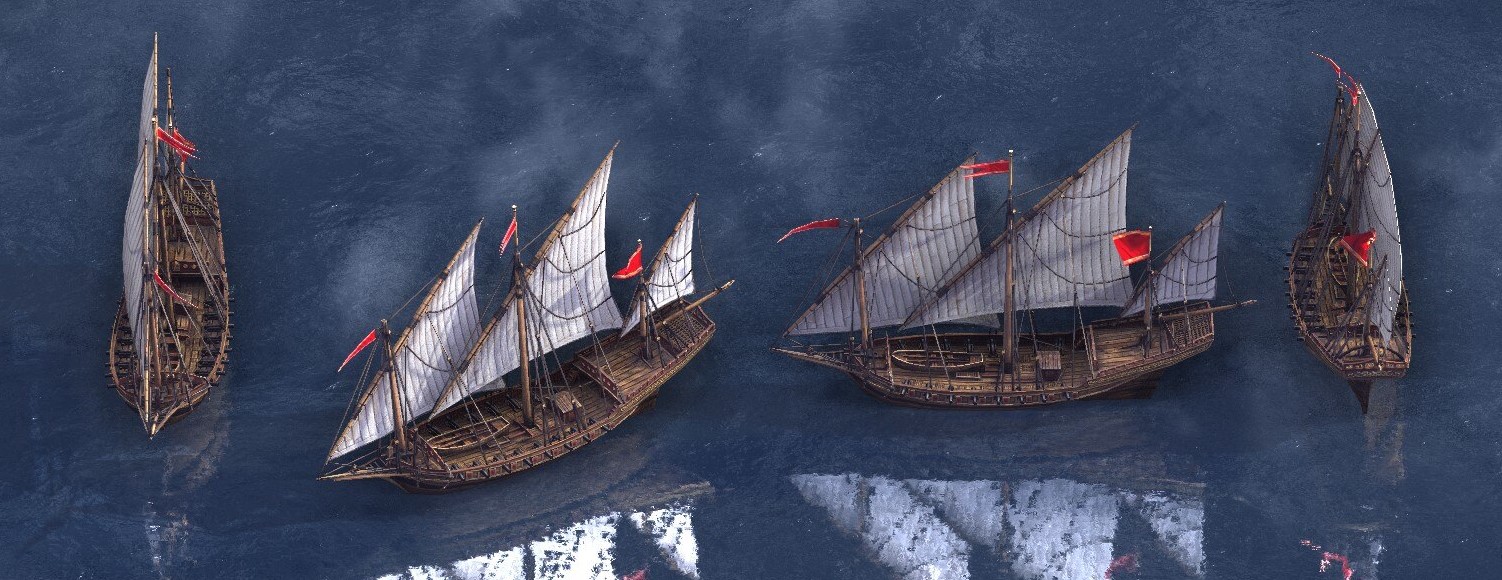
Stats:

Cost: 7,000 wood, 1,600 gold, 320 iron, 960 coal
Training time: 230 seconds max: 115 seconds min.
Range:
Reload speed: roughly 2 seconds
Gold upkeep: None
NOTE: Stats for unique ships are hard to find, so this entry is based on tests and comparisons to other units.
+ Strong medium warship
+ No gold upkeep
+ Faster rate of fire than Frigate
+ Tech to unlock costs 2,900 less wood
+ 15,000 more HP than Frigate
+ Benefits from artillery range and accuracy techs at Minaret
– Requires tech and Artillery Depot to unlock
– Slightly shorter range than Frigate
– Costs more wood, gold, and coal but less iron than Frigate
As if the Islamic nations didn’t dominate the water hard enough, they get the Xebec–a powerful Frigate substitute with more guns and the ability to be spammed harder than any other naval vessel if you can afford it.
Stat-wise, Xebecs are more expensive to purchase than Frigates, but the tech to unlock them is cheaper, allowing Islamic countries to access them earlier. They also have a lower gold upkeep. Here’s another comparison:
Gold Upkeep Comparison:
Frigate: 1 ship = roughly .17 gold per second
Xebec: 1 ship = no gold per second
That’s right–Xebecs have no upkeep. Granted, Frigates are quite cheap upkeep-wise, but it still pretty cool and it means there’s no effective limit on the number of Xebecs an Islamic country can produce.
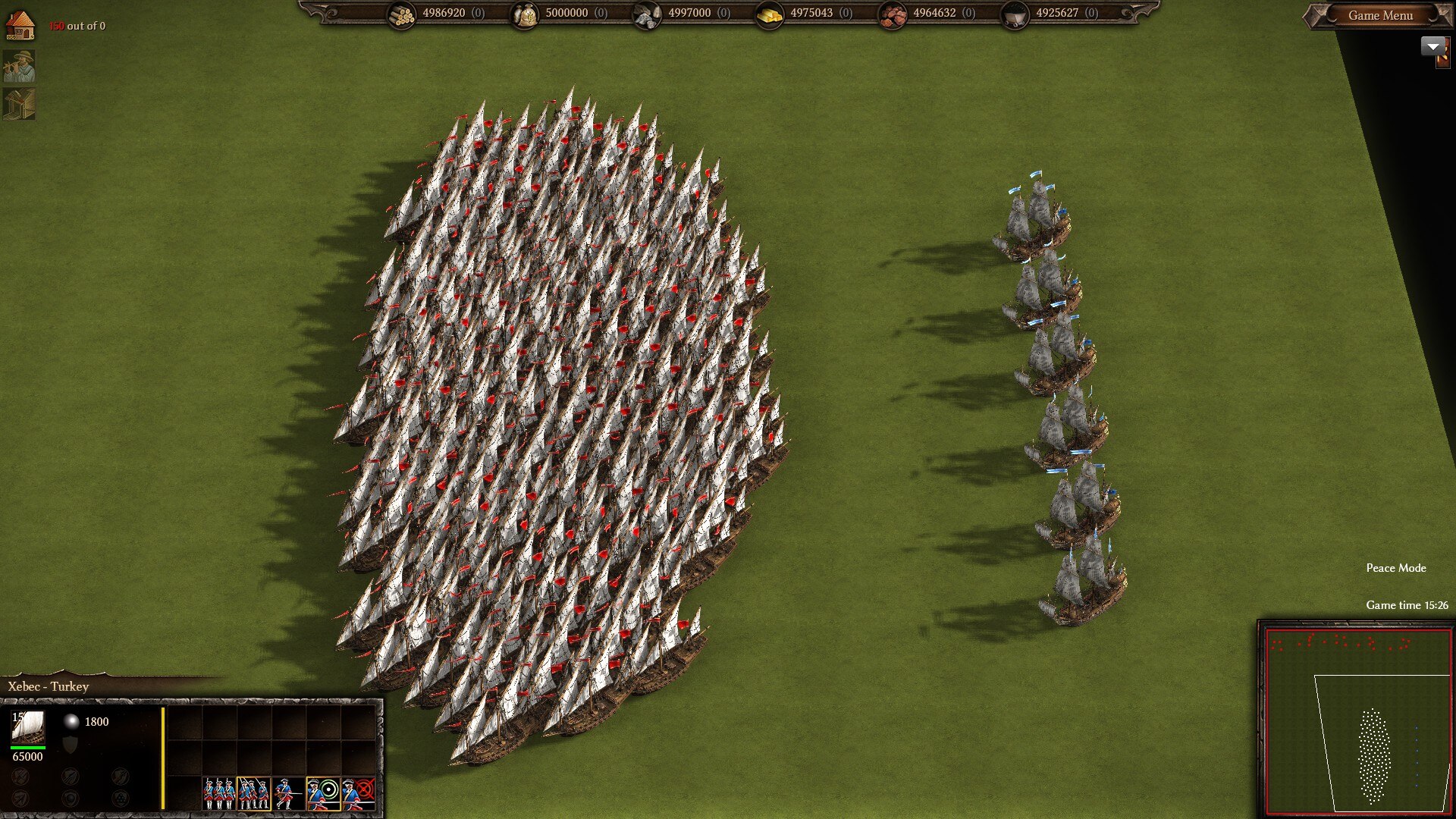
Upkeep test! Whereas 6 Frigates cost 1 gold per second in upkeep, 150 Xebecs cost the same as 1 of them would; nothing.
In terms of combat power, Xebecs have a shorter range than Frigates but they make up for it with +15,000 HP and a much faster rate of fire due to their larger number of cannons. This makes them arguably worse for shore bombardment since they can reach out as far (though you really should be using Galleys and their mortars for bombing buildings inland) but they make up for it by dominating on the water.
I couldn’t find many hard details about the Xebec (or any other unique ships for that matter), so instead of spitting numbers, here’s some screenshots from the tests I ran to figure out how Xebecs perform:
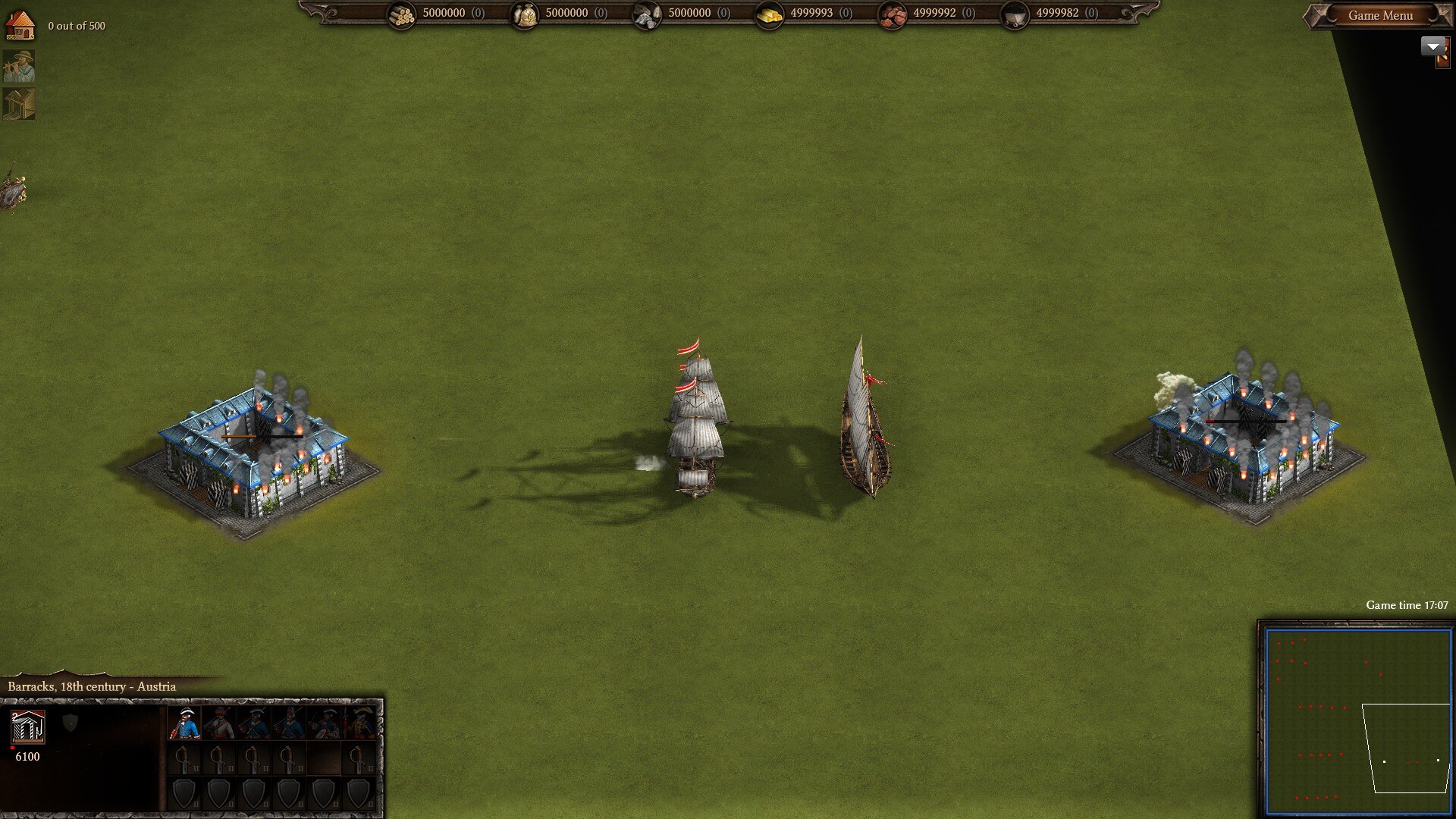
Damage output test, Frigate vs Xebec. Look at how much lower the HP on the Xebec’s Barracks is.
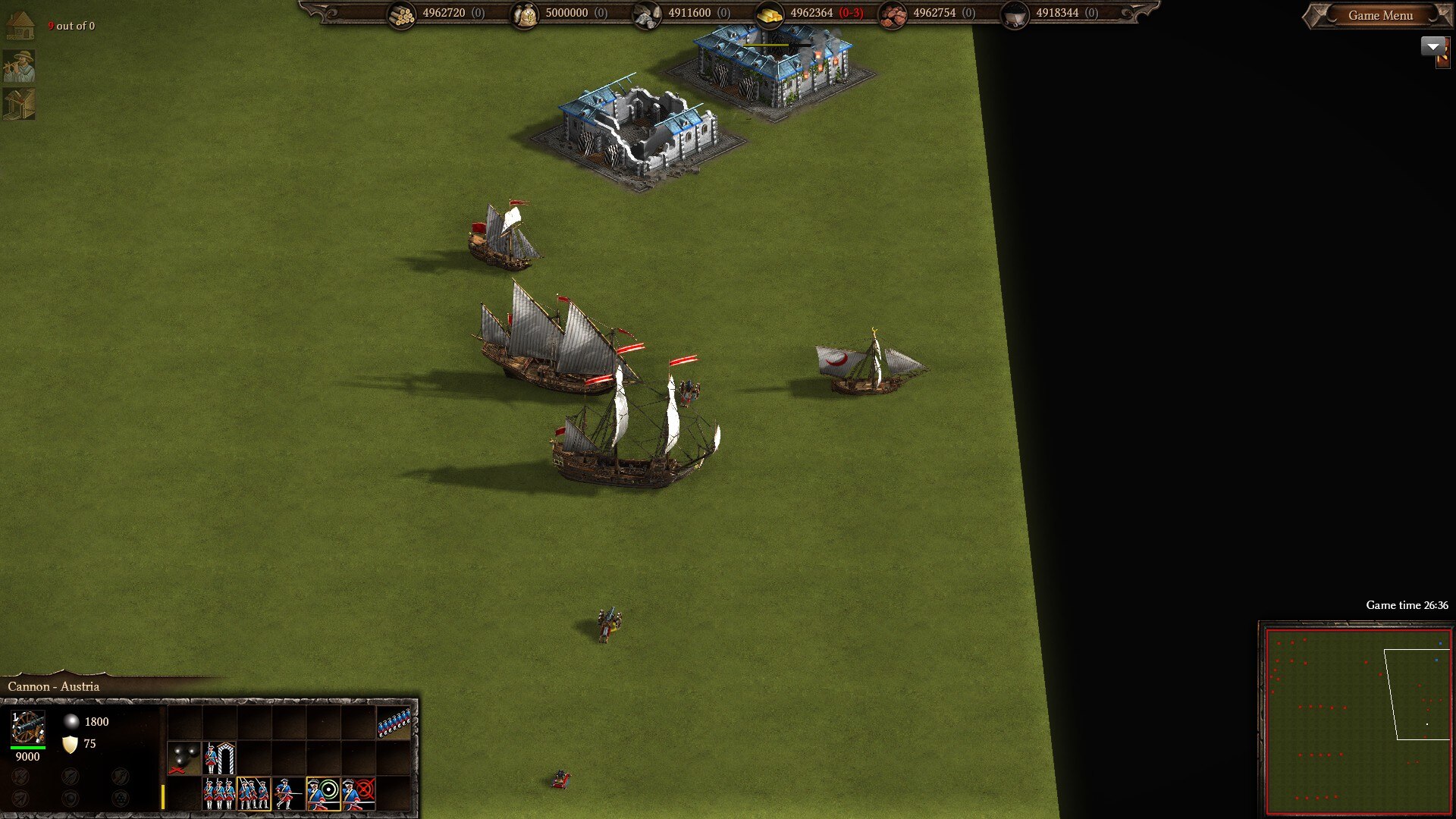
Range test, showing how Xebecs, Frigates, and both types of Yachts compare with land artillery.
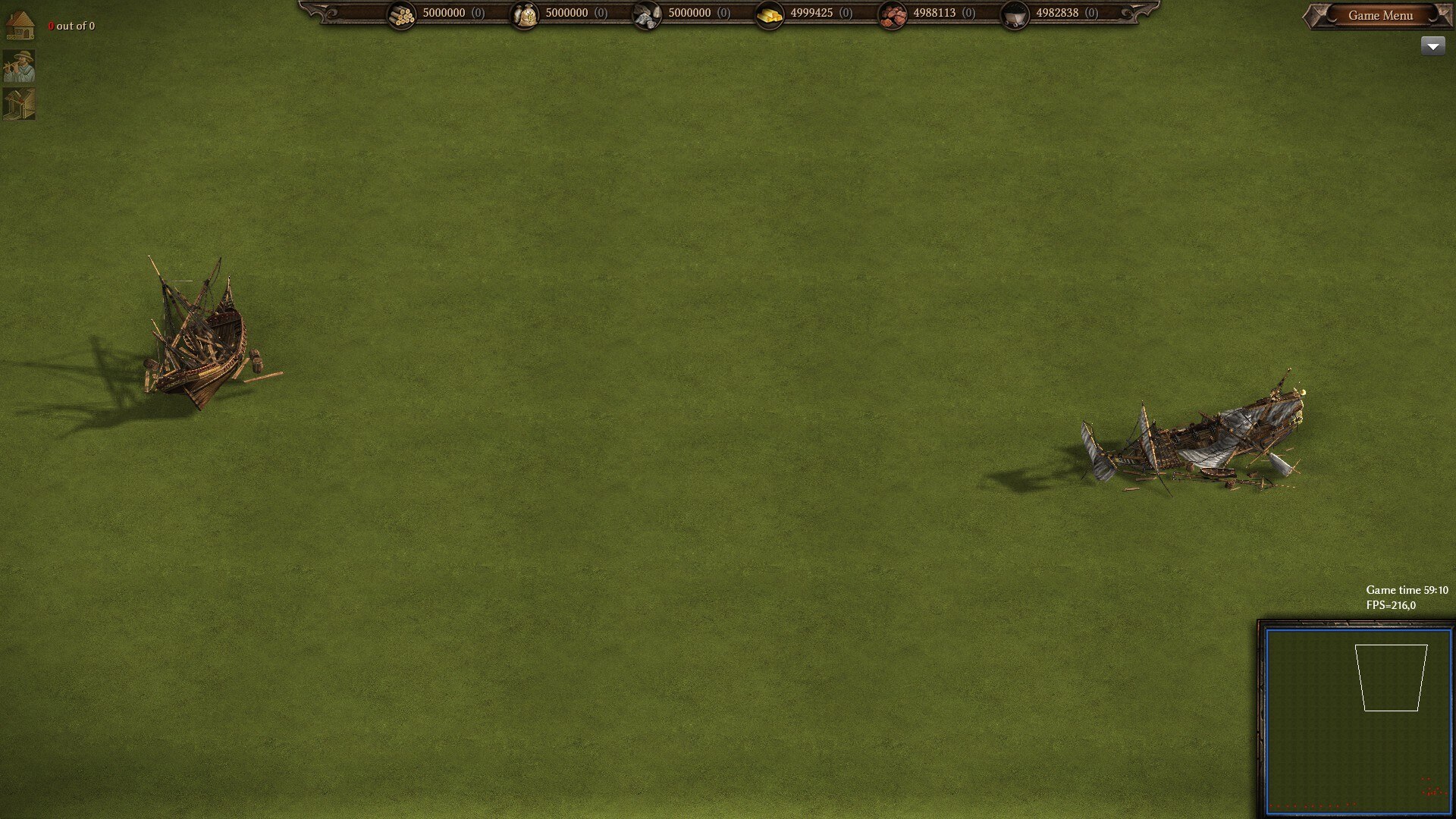
Mutual kill: A test duel between a Xebec and a Frigate. In 12 battles, this was the only one where the Frigate managed to kill the Xebec (and only because the Xebec missed most of its shots).
In another 12 duels I ran (which I lost the pictures of), the Xebecs beat the Frigates 11-0-1. The last was a draw where the Frigate killed the Xebec only to be sunk a second later by its opponent’s final shot. That’s a very impressive showing and it nicely demonstrates how powerful Xebecs can be.
All of this makes Xebecs a superior mid-tier warship in naval combat. They’re still not equal to a Ship-of-the-line, but they’re much cheaper and can be built en masse earlier and easier. In longer water games where you have lots of resources and fleets can grow to large sizes, they’ll be a vital part of your navy.
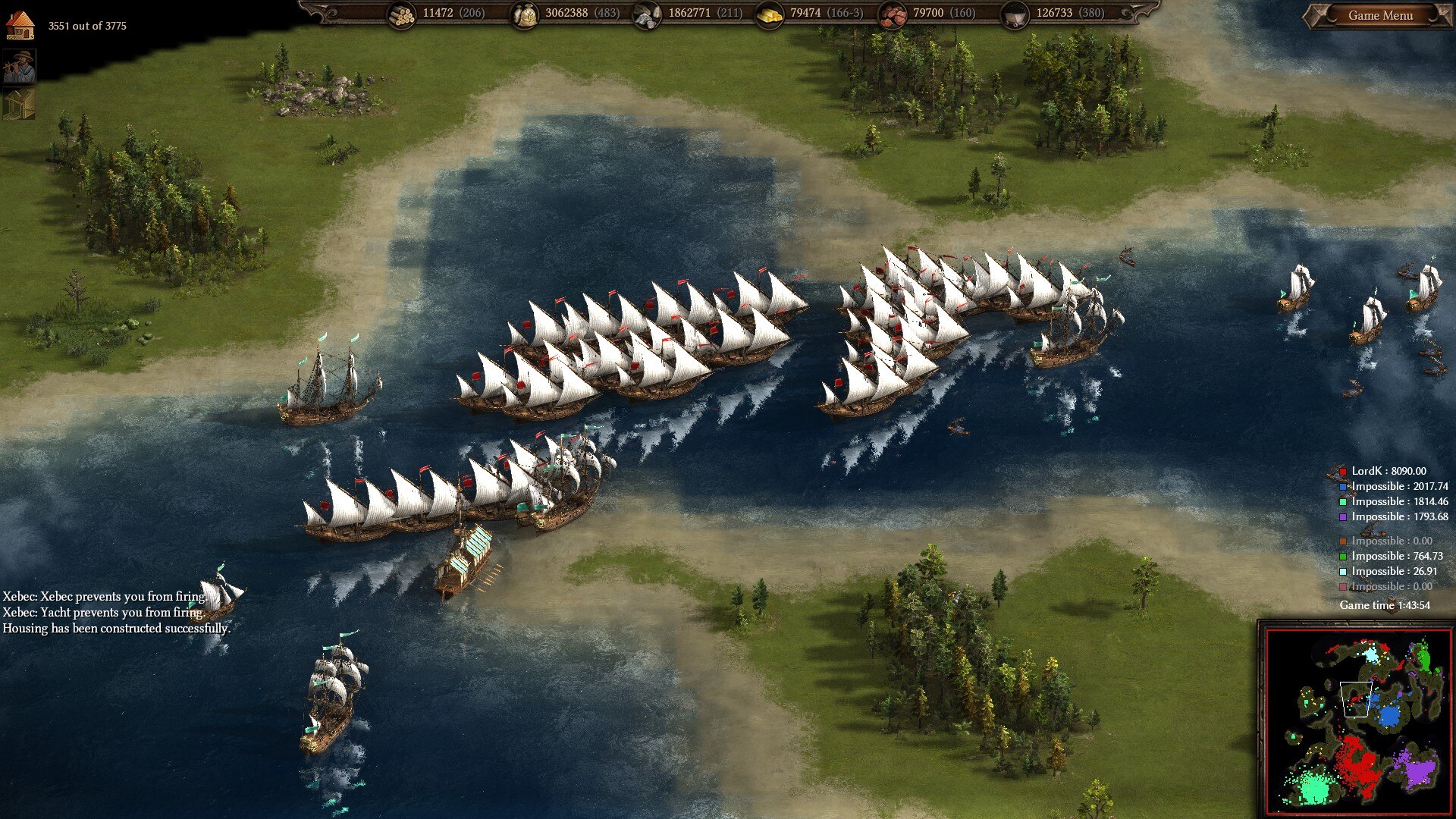
Off to war: An armada of Xebecs accompanies allied ships as set sail for the enemy islands.
Gameplay
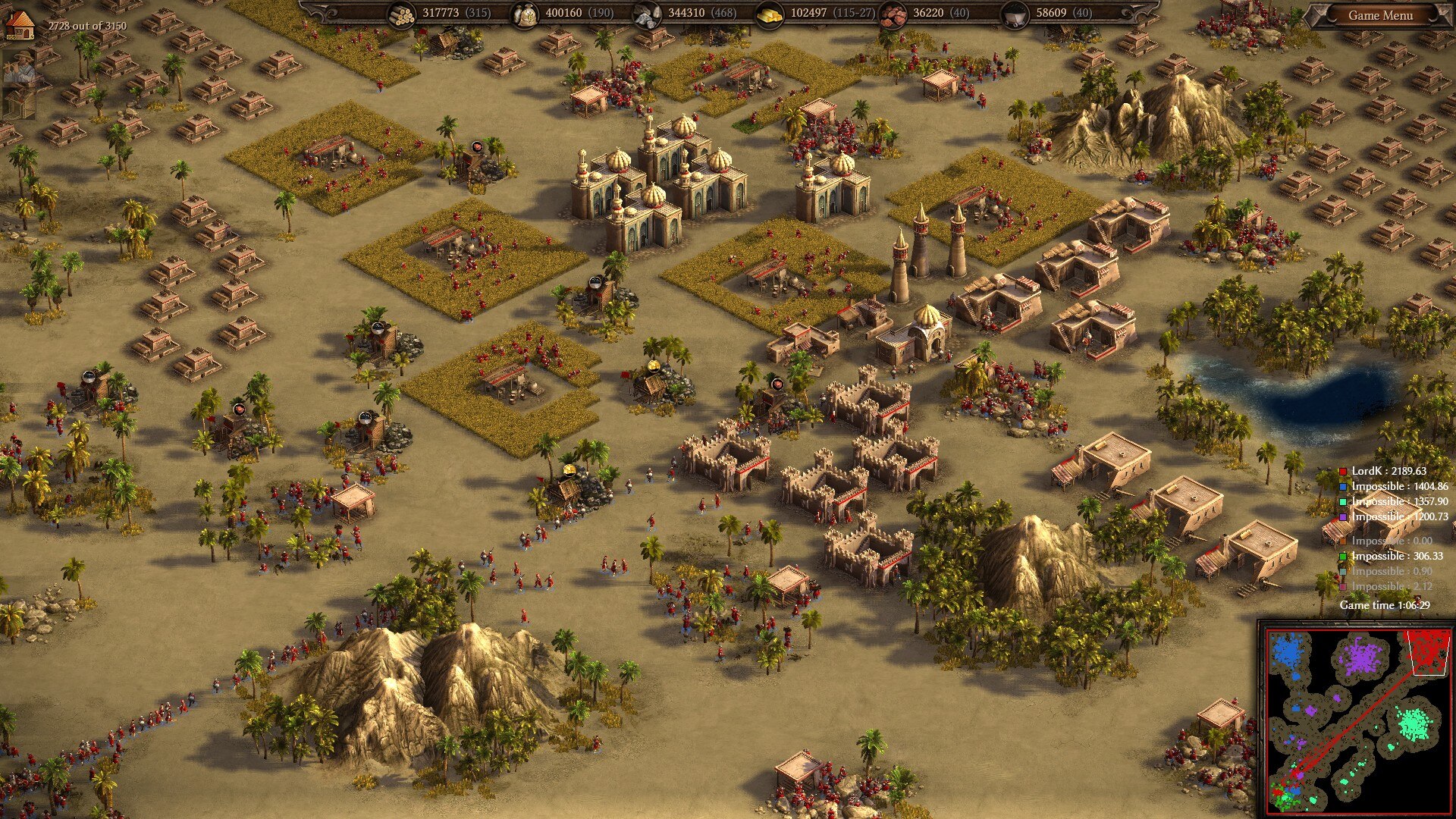
NOTE: This section assumes you’re only playing with Turkish units and buildings. That means it largely ignores capturing, although the advice given can easily be applied to games that allow it.
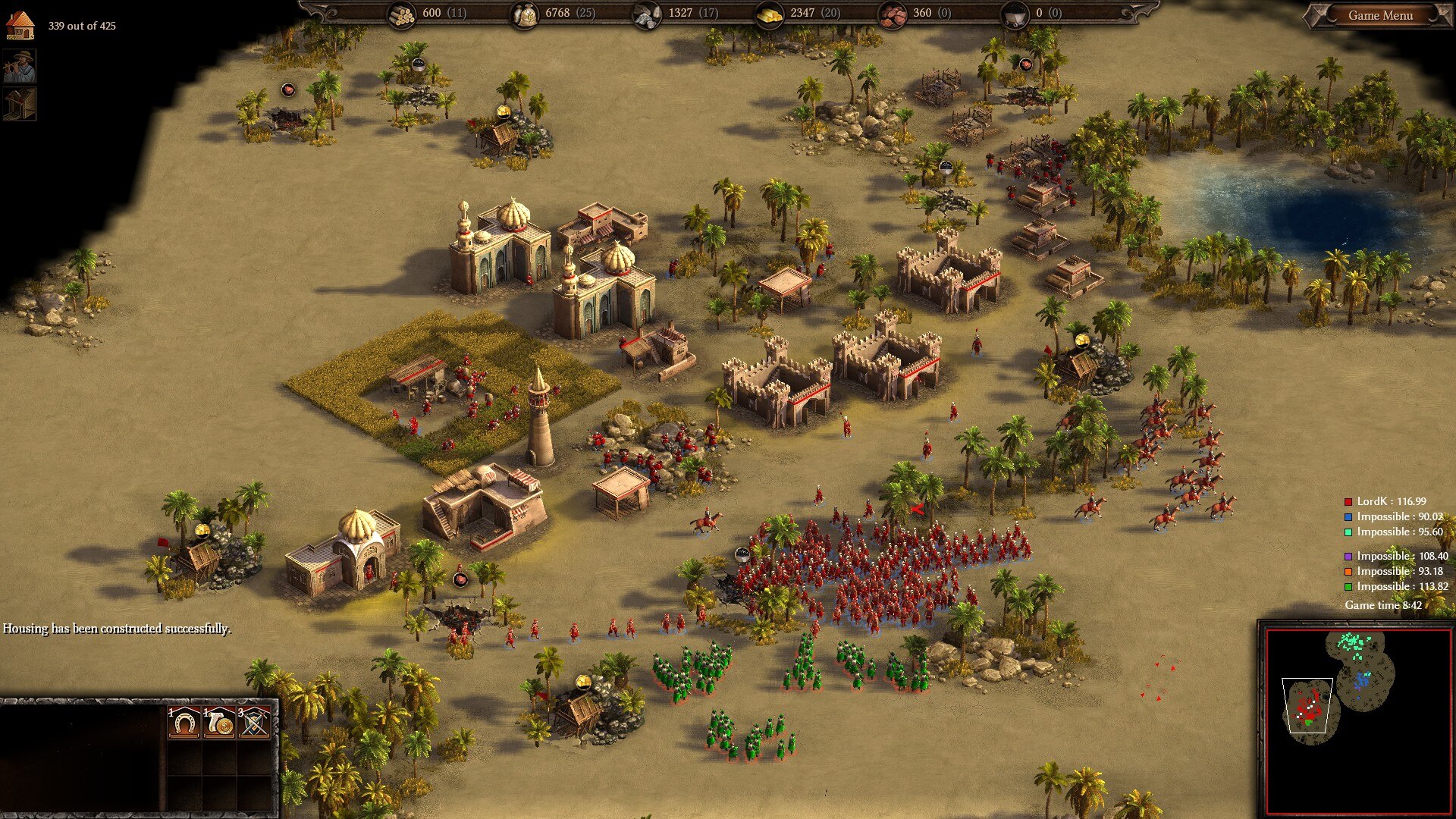
Battling Russia in the Caucuses: An early 0-peacetime Turkish base going for a Tatar-Pikeman build. This is perhaps the most common Turkish opening in low-peacetime games.
As already stated countless times in this guide, Turkey is a top-tier nation in the early game, up there with Poland, Scotland, and fellow Islamic country Algeria. Between their strong and cheap units, fast-building economy, and inexpensive production buildings, Turkey can easily raise a powerful army no matter what the starting conditions.
Thankfully, Turkey’s opening builds tend to follow European norms. The most critical deviation is building a third Barracks quickly, ideally well before the ten-minute mark. Do this after you get your first Stable plus the other mandatory buildings up (Market, Academy, Diplomatic center). This requires heavy use of the Market to sell resources and it’ll take some practice games to get the hang of, but it’s not that hard.
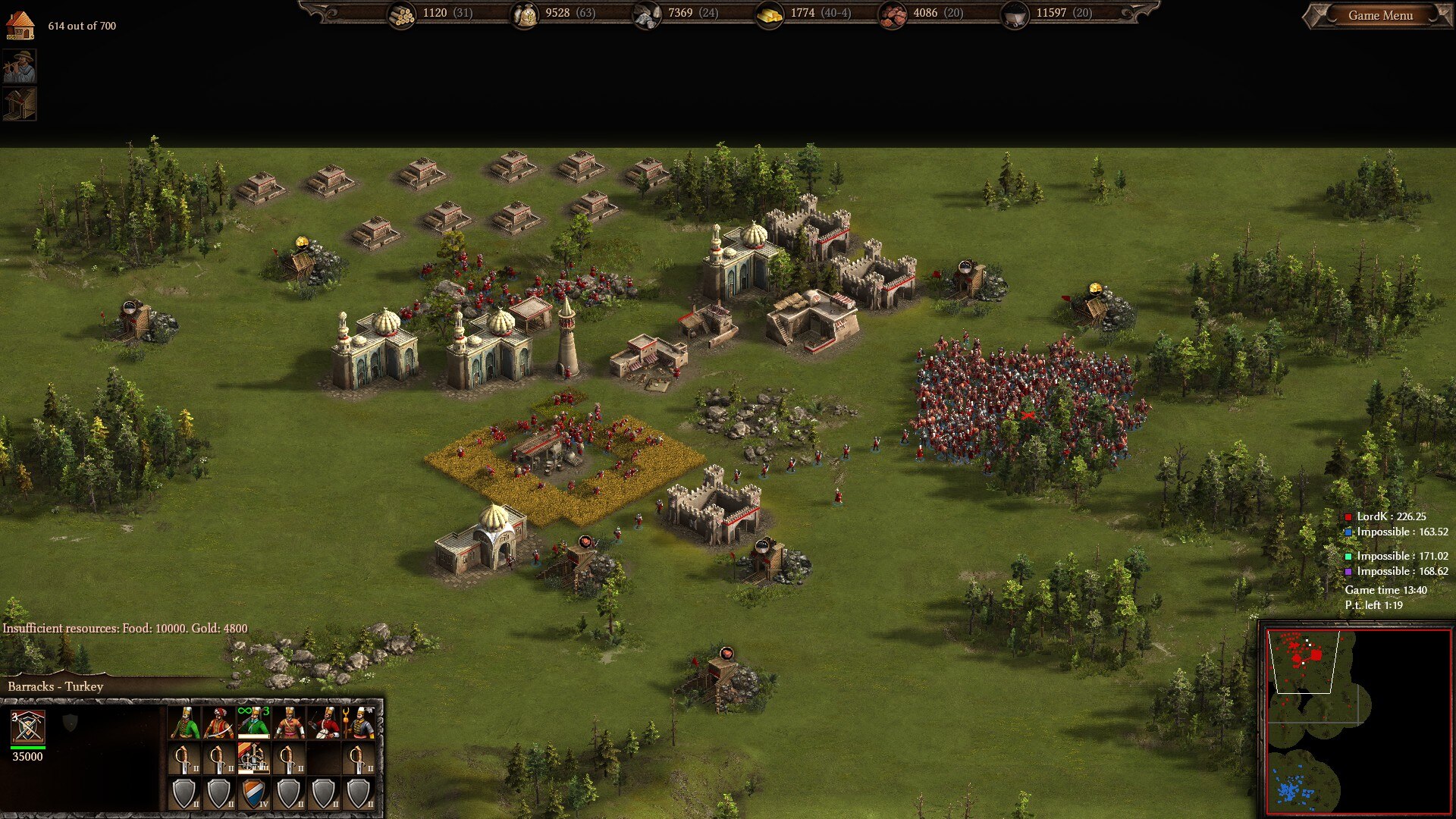
Mustering the Janissaries: A 15-minute peacetime Turkish base going for a Janissary-Light Sipahi build.
The units you pick will depend on the peacetime. To summarize: Ottoman Pikemen are the easiest starting infantry for low-peacetime games, Janissaries get better with longer peacetimes so you can grab more upgrades before the fighting starts, and Light infantry can be very good at most peacetimes so long as you properly manage your housing. As for cavalry, Tatars are great for early raiding and town razing, Light Sipahis provide the most melee power and train quickly, and Heavy Sipahis are pure tanks.
Lastly, there’s water maps, where Turkey is one of the best factions in the game. Between huge tech and building discounts and powerful, swift-moving Yachts, Turkey should have no problem establishing their navy before European countries and seizing early control of the seas.
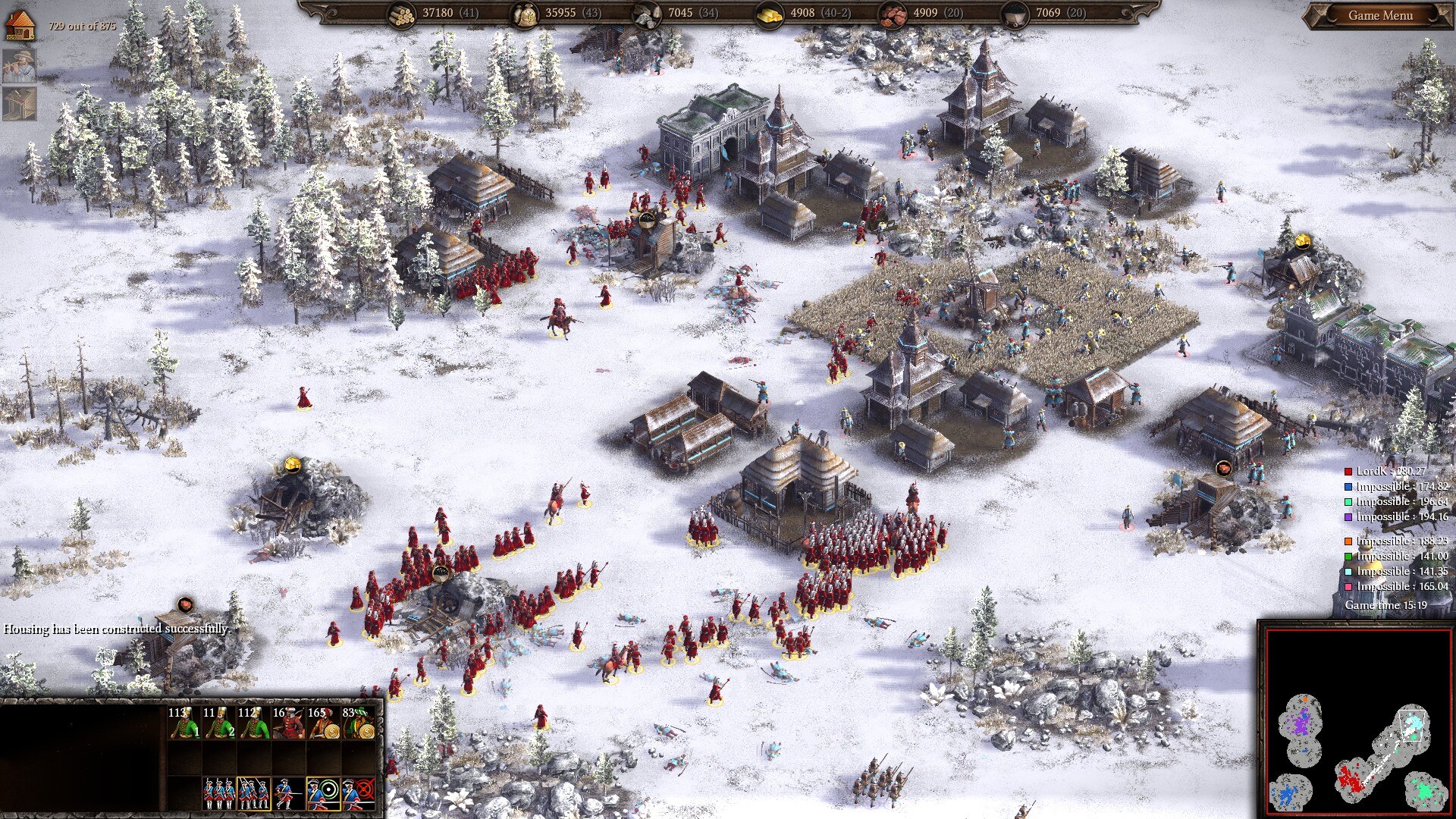
Punishing the Cossacks: A 15-minute peacetime force of Ottoman Pikes and mercs storms a Ukrainian town.
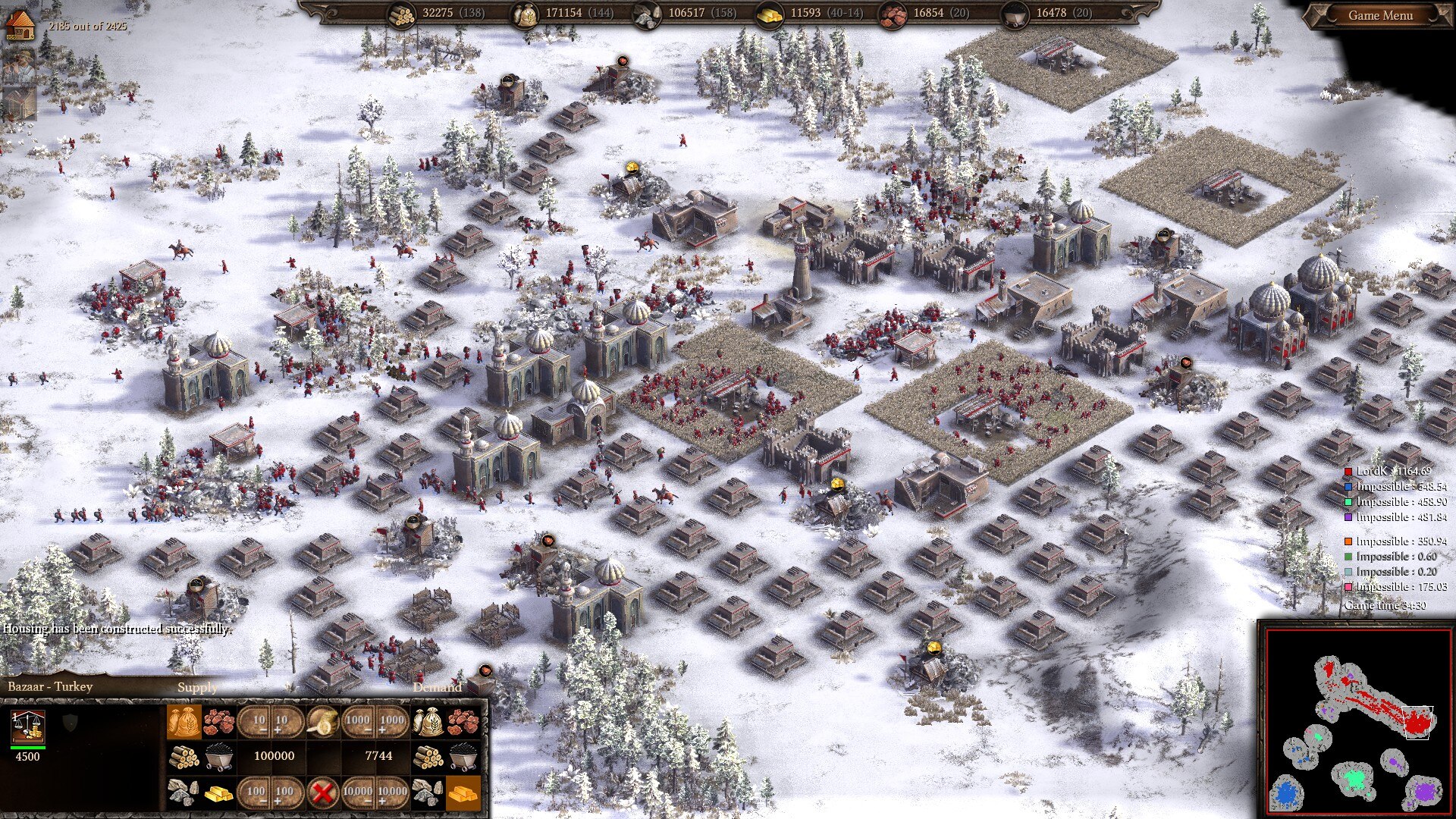
The Köprülü era: A mid-game Turkish base.
Turkey remains competitive in the mid game, though their relative strength is declining. By now nations are more established with growing economies and increasing Peasant and military production. Some are even starting to reach the 18th century, effectively putting Turkish players on a timer before they get eclipsed by the increasingly-strong Europeans.
Even with all that, Turkey can still pack a serious punch in this era. Their discounted artillery techs make it easy to add Cannons to their army and their infantry and cavalry can still get the job done, whether they’re a Light Infantry horde or an elite Janissary force. Combine that with an increasing number of Sipahis as more Stables come down, and Turkey can give just about any faction a serious fight.
On water maps, Turkey is even better off. Still riding high off their discounts and now starting Xebec and maybe even Ship-of-the-line production, Turkey can easily outgun and outnumber non-Islamic factions’ navies, ensuring a serious advantage for their team.
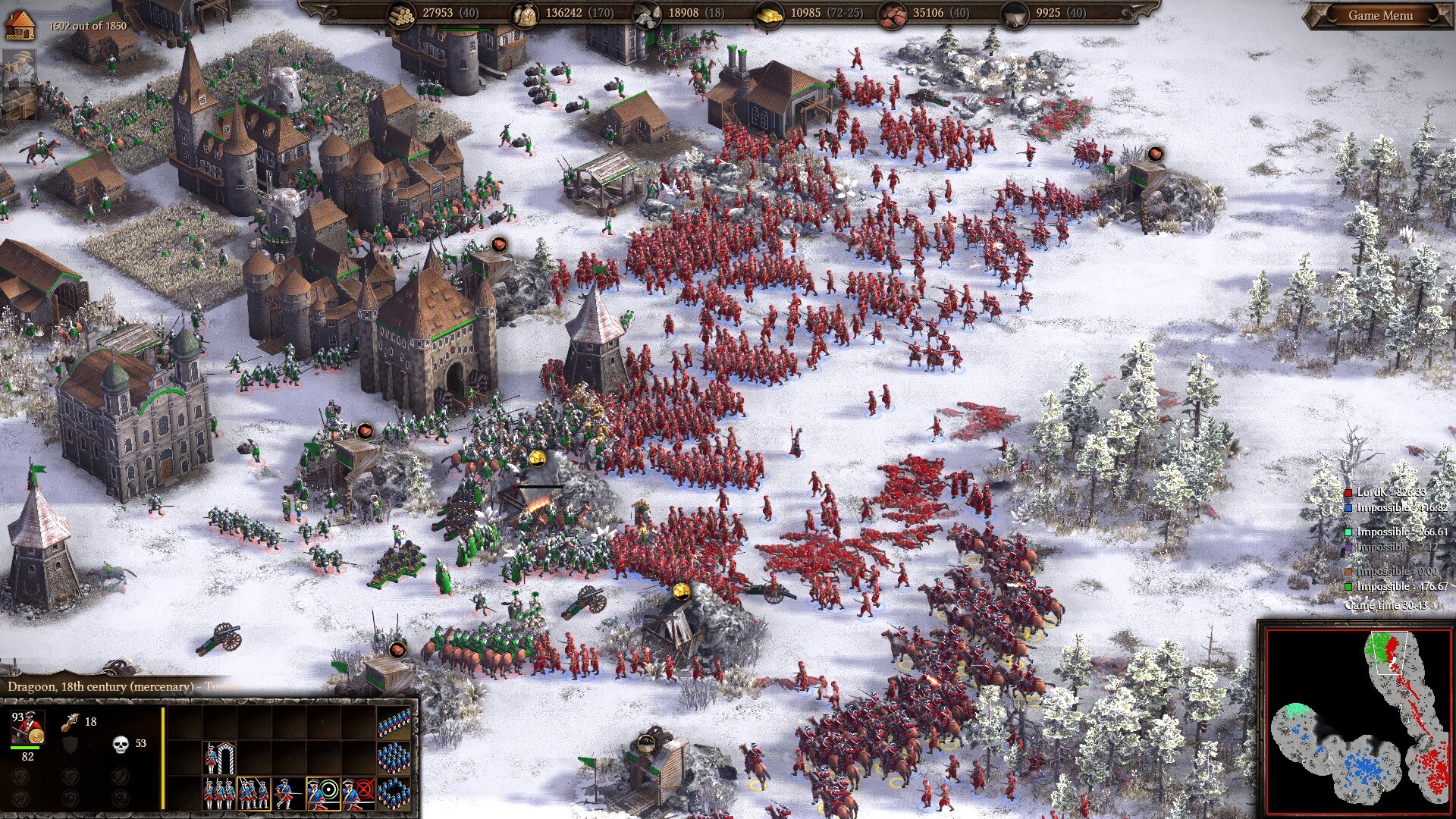
Alpine invasion: Light Infantry and mercenaries swarm over a mid-game Swiss base. Strong late-game units like Jaegers don’t mean much if you kill the foe before they can amass them.
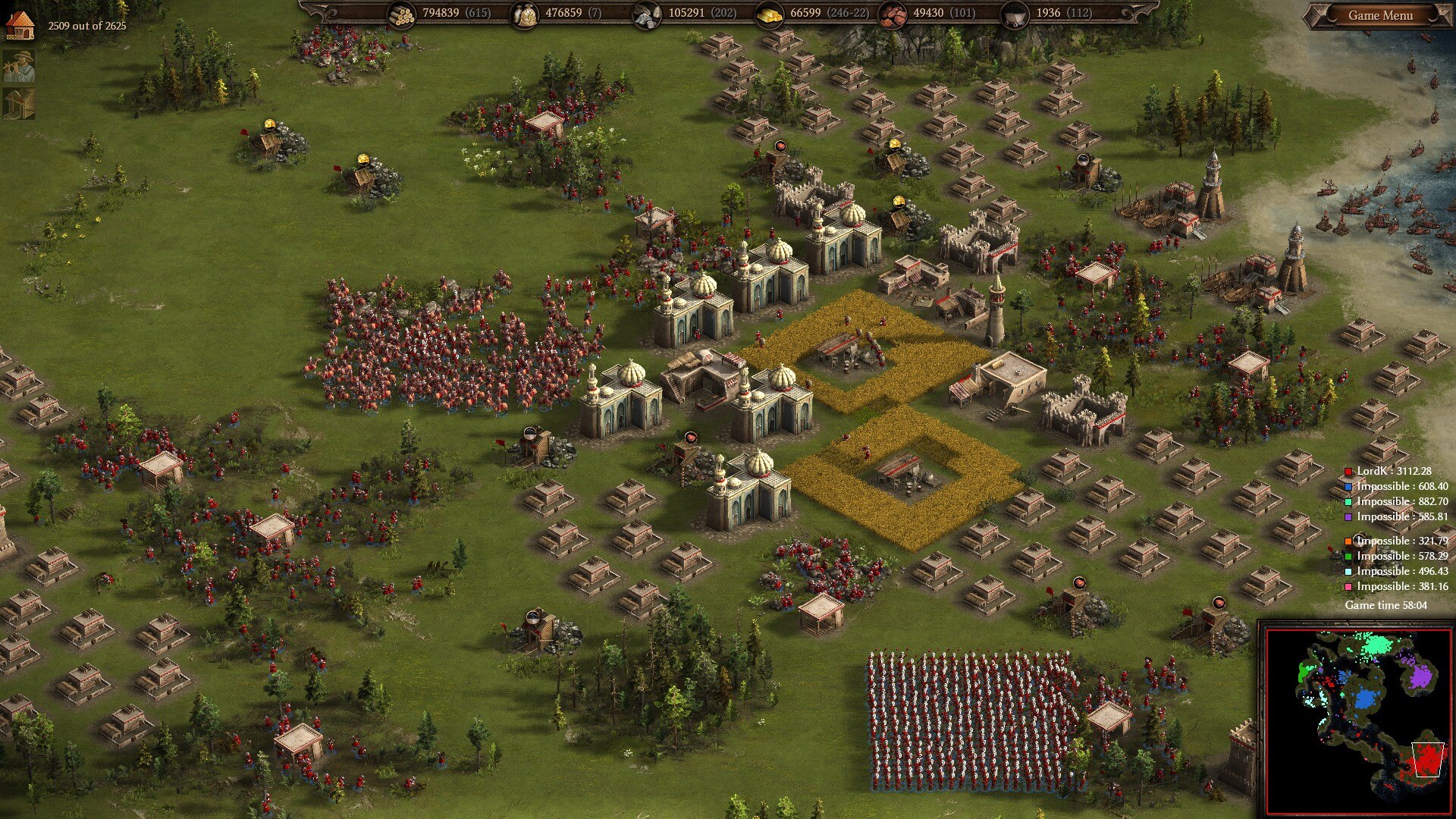
Reforming for a new era: A late-game Turkish base with a large fishing fleet just offshore. The massive number of lumberjacks is to sustain constant Xebec production.
This is where everything goes downhill. By now other countries will have stronger economies and large, powerful militaries. Most of Turkey’s troops will be unable to last more than a few seconds against the massed gunfire of an 18th century army and those that do can’t be trained fast enough to keep up with the losses. Simply put, Turkey lacks the tools to effectively compete with European countries in the late game.
How you play out the rest of the game depends on what the situation is. If you’re alone against a non-crippled European country handled by a competent player, your options are to surrender or die gloriously. Unless you massively outskill the enemy, there’s not much you can do to stop them from steamrolling your 17th century troops.
On the flip side, if you have strong teammates left, you can still do some good in support of their war effort. Hurling masses of Light Infantry and Sipahis in front of your allies’ armies during a fight will help protect their far more valuable troops from harm. If you still have a lot of Janissaries left, you can add their firepower to big fights. Max out on artillery, as it’s the only part of your army that’s just as good as everyone else’s (save for missing Multi-barreled Cannons). You can also go into the menu to send spare resources to your allies. (Offer to do so in the chat.) Remember, your forces are utterly incapable of pushing against a late-game European army on your own, so don’t go solo and keep your forces near your allies’ armies so you don’t get caught out and annihilated.
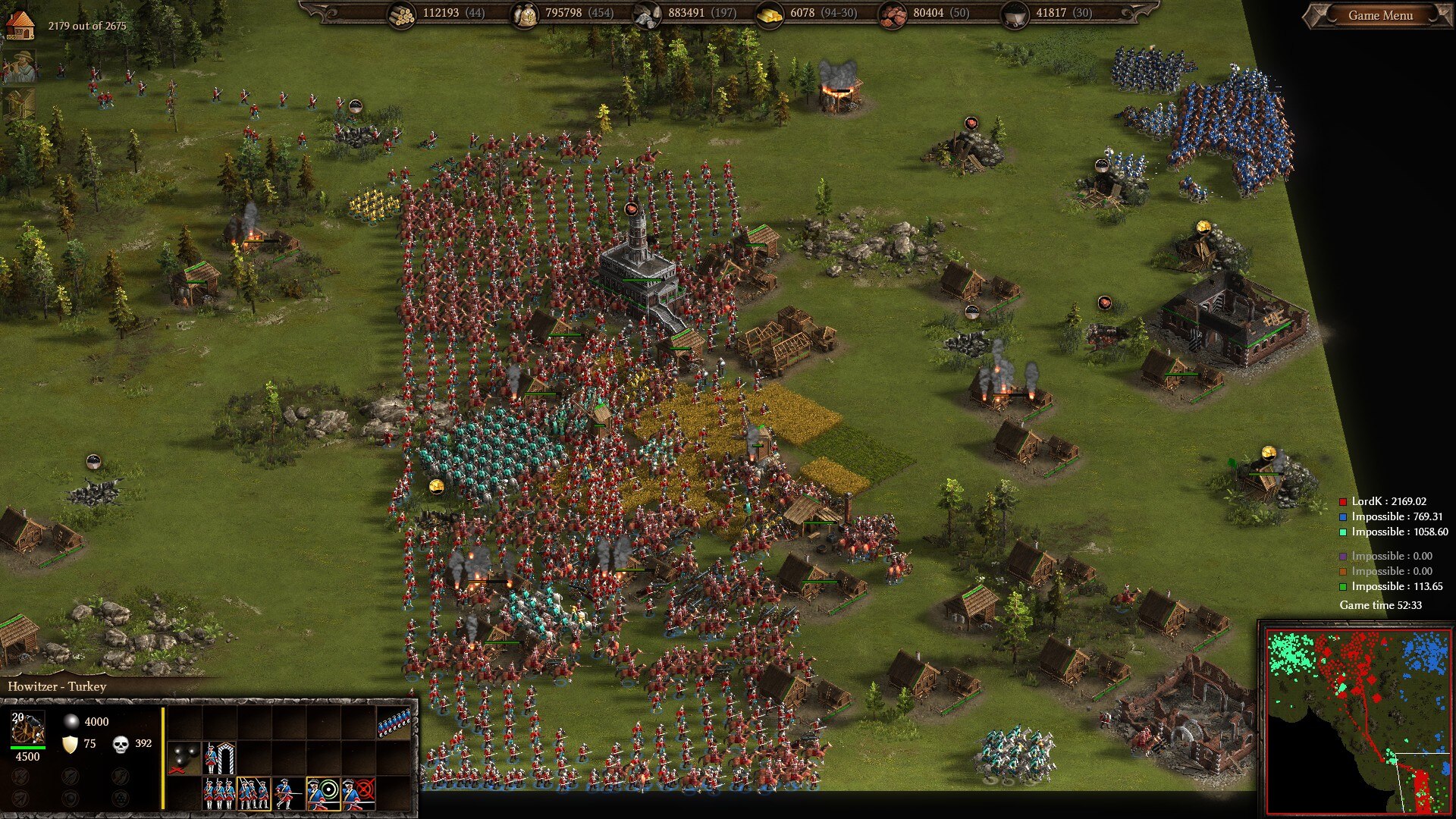
Allied victory: A Janissary force levels the last enemy base alongside their Danish and Bavarian allies. If you can put your team ahead in the early game, you allies might be able to carry you later on.
All that stuff only applies to land maps, however. On water maps, late-game Turkey is not just competitive but arguably the best faction in the game. With their strong Xebecs and Yachts plus the standard Galleys and Ships of the Line, they can field arguably the most powerful navy in the game, tied with Algeria. The only things they struggle with are conducting naval landings and not getting the balloon tech, but your allies can help with those issues.

Building the sultan’s fleet: Newly-launched Xebecs sail past more ships under construction. Towers ensure the harbor stays defended while the fleet is away.
Map Preferences
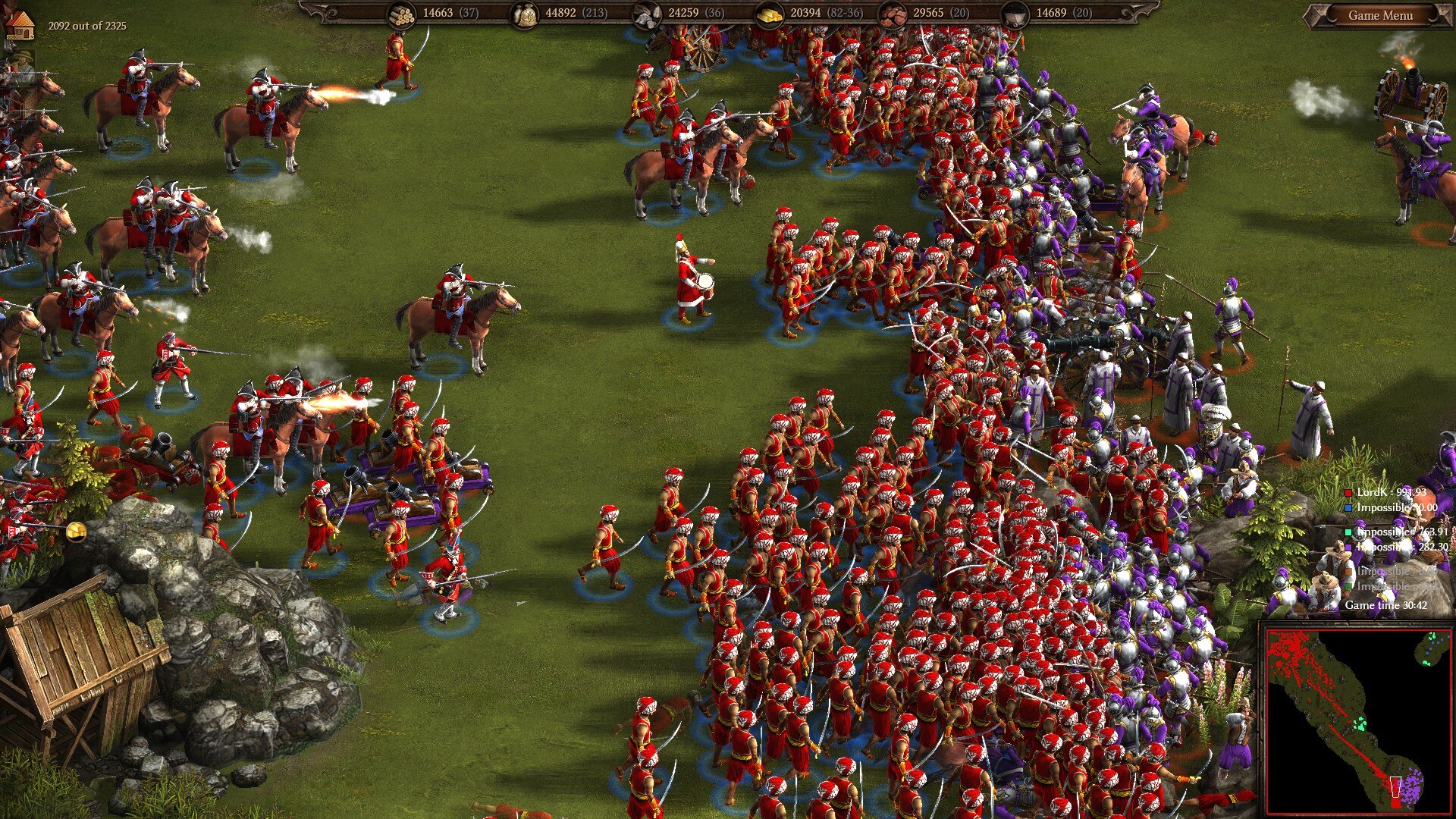
Levies and sellswords: With covering fire from Mercenary Dragoons and Grenadiers, Light Infantry overwhelm a Piedmontese force.
Being a nation focused entirely on the early game, Turkey does best in matches that emphasize it. They like small maps with low peacetimes—small maps to minimize the rush distance (allowing their armies to reach the enemy base quickly) and low peacetimes to get the fighting started as quickly as possible. Hit the ground running and strike hard and fast—that’s the Turkish way of war.
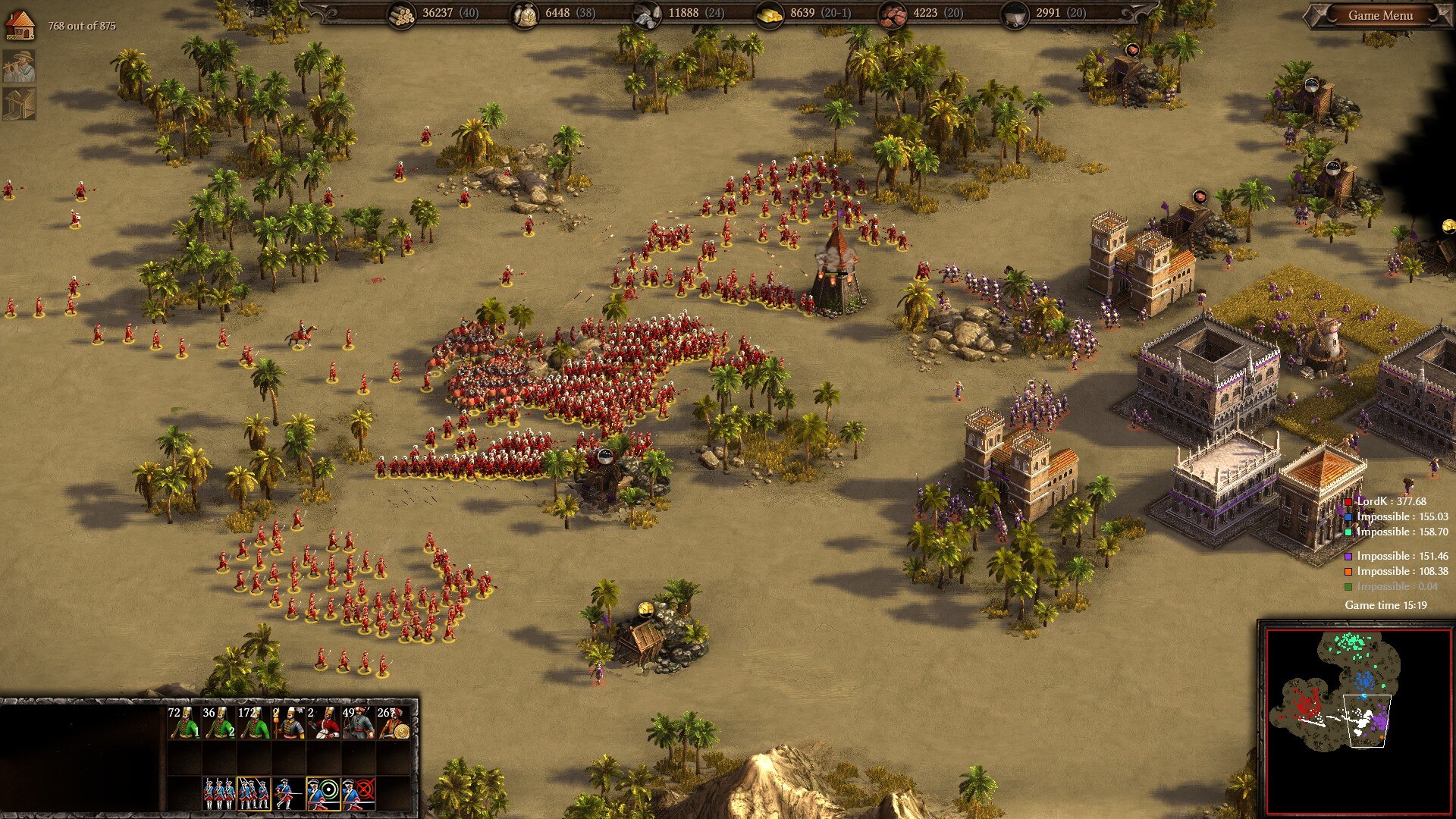
Make the merchants tremble! A force of Ottoman Pikes, mercs, and Tatar auxiliaries surge towards a surprised Venetian town.
The flip side is just as true: Turkey is utterly unsuited for matches that cancel out or skip over the early game. Turkey needs the early game, and any match with long peacetimes to prevent rushing or with millions of starting resources that let players get late-game armies going right away are anathema to them. This makes Turkey one of the most limited factions in the game when it comes to preferred map settings.
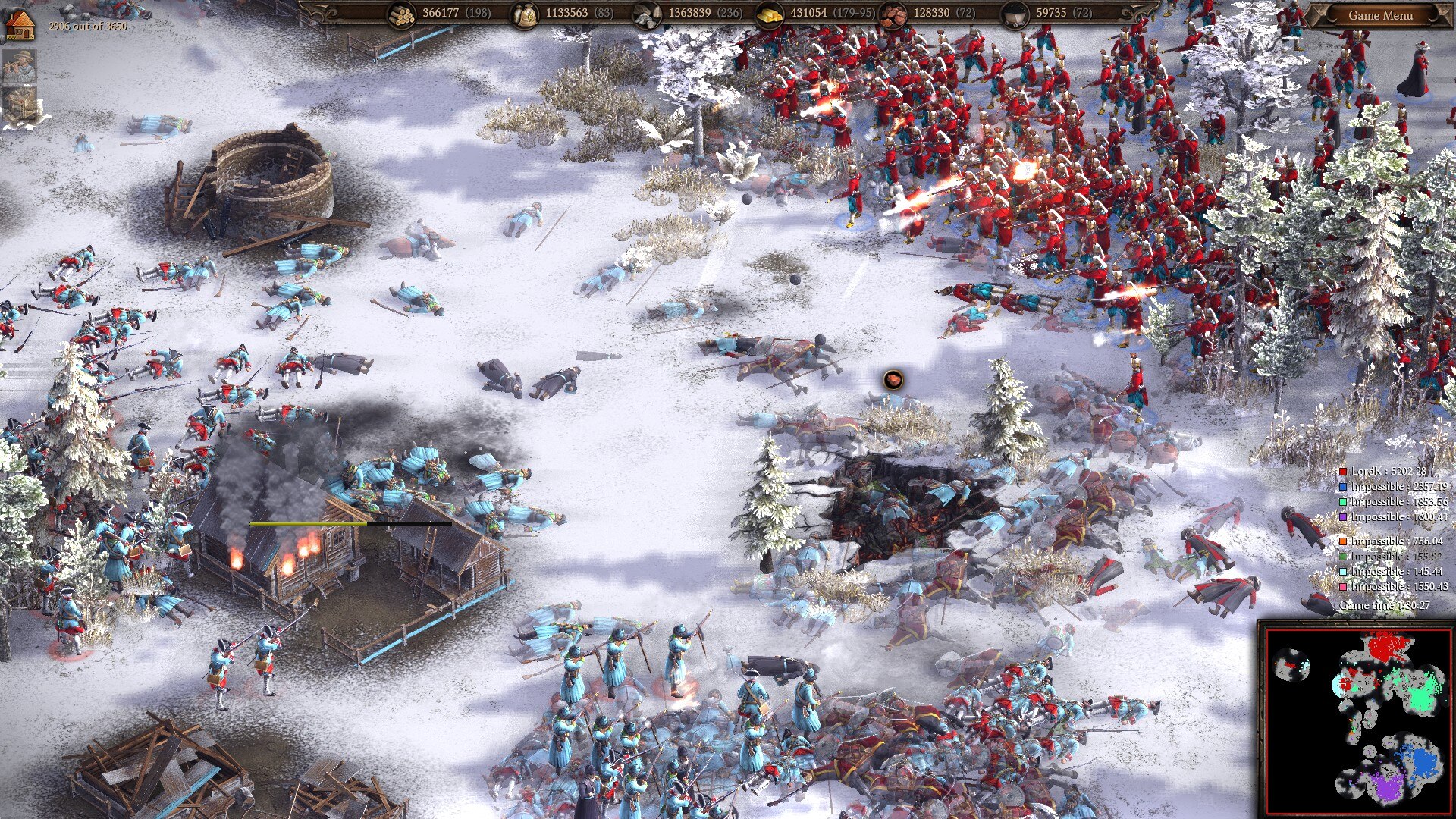
Battle along the Black Sea: Turkish landing troops besiege a coastal Russian fort.
This dependency on the early game carries over to team matches. Since your strength will drop off later on, Turkey needs to deal as much damage as possible early on. Kill or cripple an enemy or two, and it’ll help your teammates make up for your eventual weakness (or, ideally, win the game before it goes late).
Whatever the case, the point remains that Turkey must always be aggressive and start attacking as soon as possible. If you like playing defense or sitting back and booming, this isn’t a nation for you. But if you enjoy fast-paced, action-packed games, then few other countries can scratch that itch like Turkey.
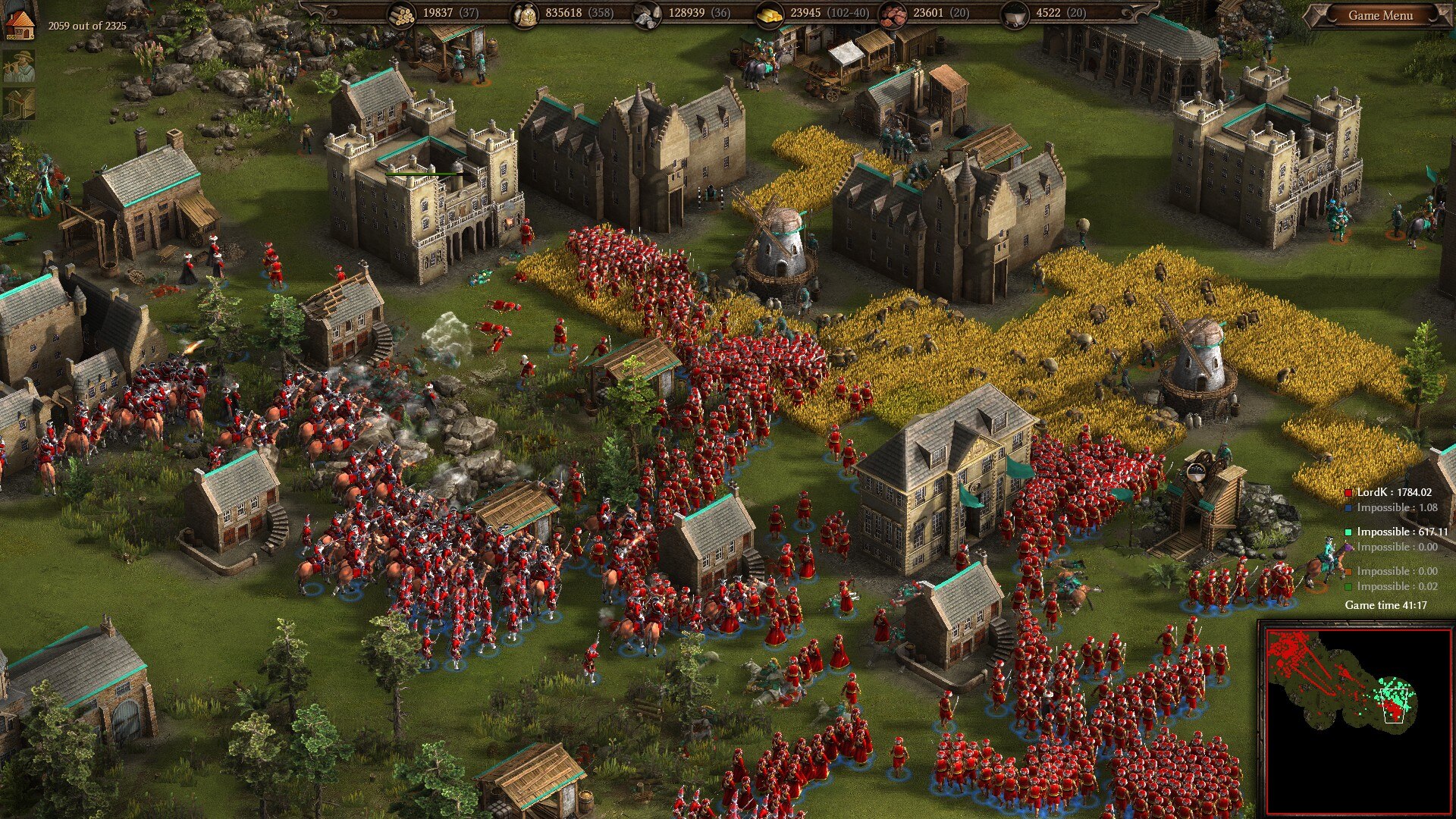
Humbling the highlands: Light Infantry swarm a Scottish base.
Tutorials & Example Games
1. The first of two classic guides from top player colorfit. A must-watch for people looking to dive into multiplayer or just get better at the game.
https://youtu.be/XP19ocvOIg0
2. The second colorfit guide, this time covering how to micro your armies in battle. Again, a must-watch.
https://youtu.be/t6JE59Gnesk?list=PL9MM6y8GRIFcfOaVMvUGSZ7s3HANGpEPd
3. A 4v4 by colorfit that features a very successful Ottoman Pike and Tatar defense and counterattack against fellow rushing nation Portugal that snowballs into victory for his team. Also note the funny way he scouts around his base with Light Infantry.
https://youtu.be/JvZTc8BmH5w
4. A 1v1 Turkey mirror from Odin with low starting resources that transforms into a duel of pikes and Light Sipahis.
https://youtu.be/RyNF0UUUFsw
Closing Remarks
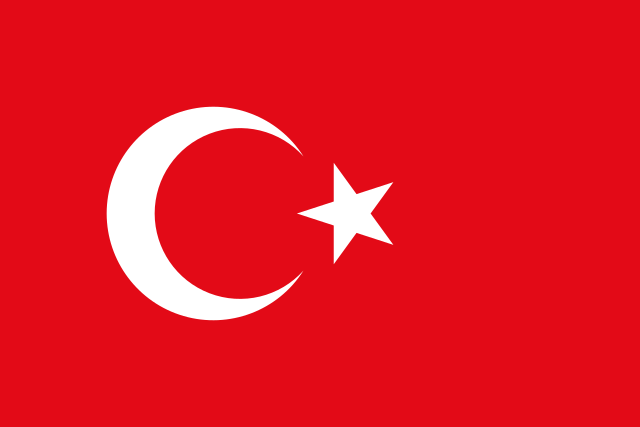
Modern flag of Turkey, first established in 1936. The design is very closely based on the Ottoman naval ensign of 1793, which was officially adopted as the empire’s national flag in 1844. The laws of 1936 simply standardized the position and proportions of the crescent and five-pointed star, which were allowed to vary under the Ottomans.
Thank you for reading! If you made it through the whole thing, you’re awesome! This was easily the longest guide and most exhausting I’ve done, having been in the works for months, so getting it posted is a great relief.
There are only seven nations left that need guides. I’m honestly a bit surprised I made it this far, but I’m glad for it and for all the helpful feedback and encouragement from the community. Knowing that some people are finding these helpful keeps me going.
Let me know which of the remaining factions you want to see. I already know which one is next. (Here’s a hint: They really like the color yellow.)
Austria
Bavaria
England
Netherlands
Piedmont
Poland
Portugal
Prussia
Russia
Saxony
Scotland
Spain
Sweden
And that wraps up our share on Cossacks 3: Turkey Faction Guide. If you have any additional insights or tips to contribute, don’t hesitate to drop a comment below. For a more in-depth read, you can refer to the original article here by PirateMike, who deserves all the credit. Happy gaming!
